Case Study of Employee Performance of Marriott Hotel
VerifiedAdded on 2019/12/28
|45
|12095
|2999
Dissertation
AI Summary
Contribute Materials
Your contribution can guide someone’s learning journey. Share your
documents today.
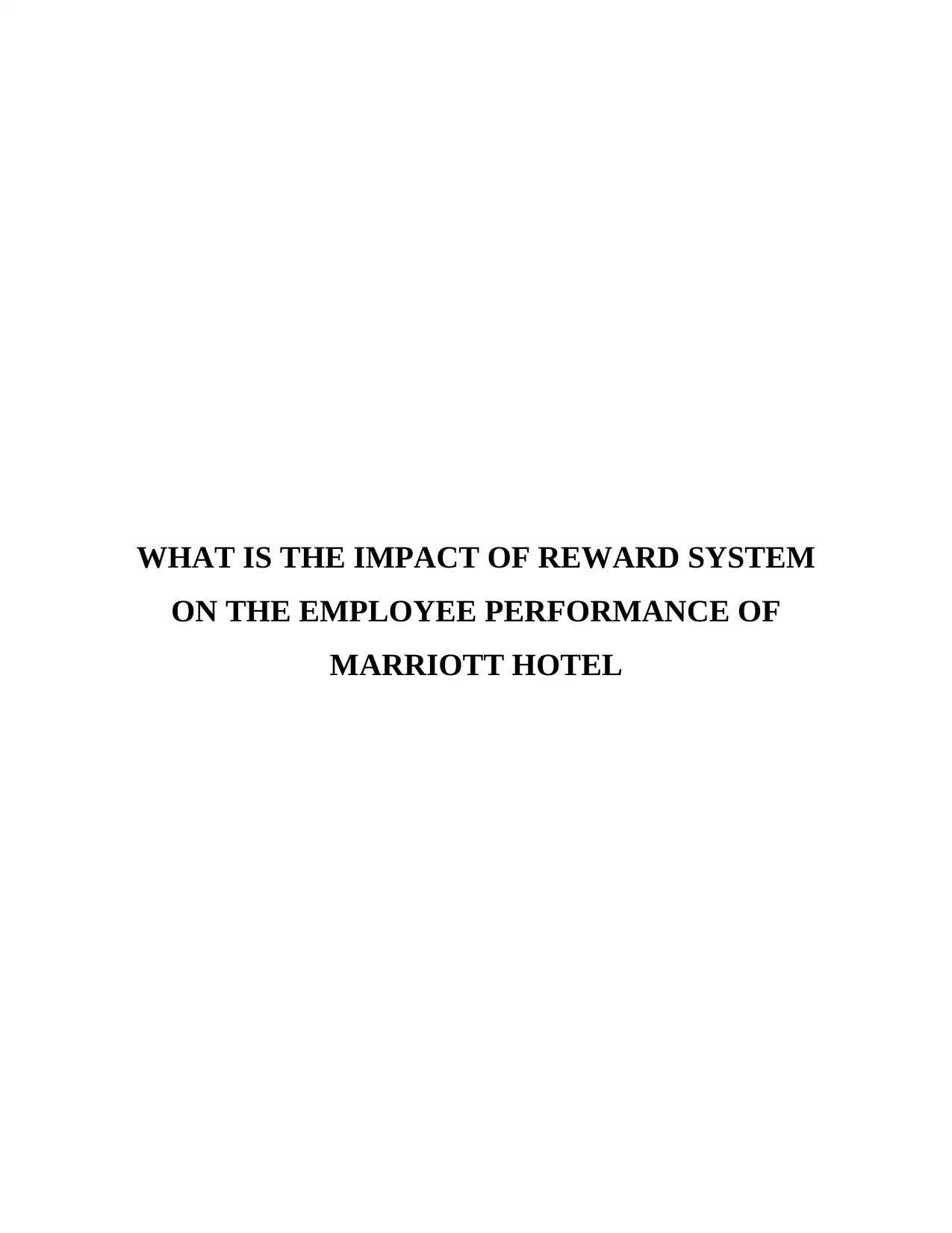
WHAT IS THE IMPACT OF REWARD SYSTEM
ON THE EMPLOYEE PERFORMANCE OF
MARRIOTT HOTEL
ON THE EMPLOYEE PERFORMANCE OF
MARRIOTT HOTEL
Secure Best Marks with AI Grader
Need help grading? Try our AI Grader for instant feedback on your assignments.
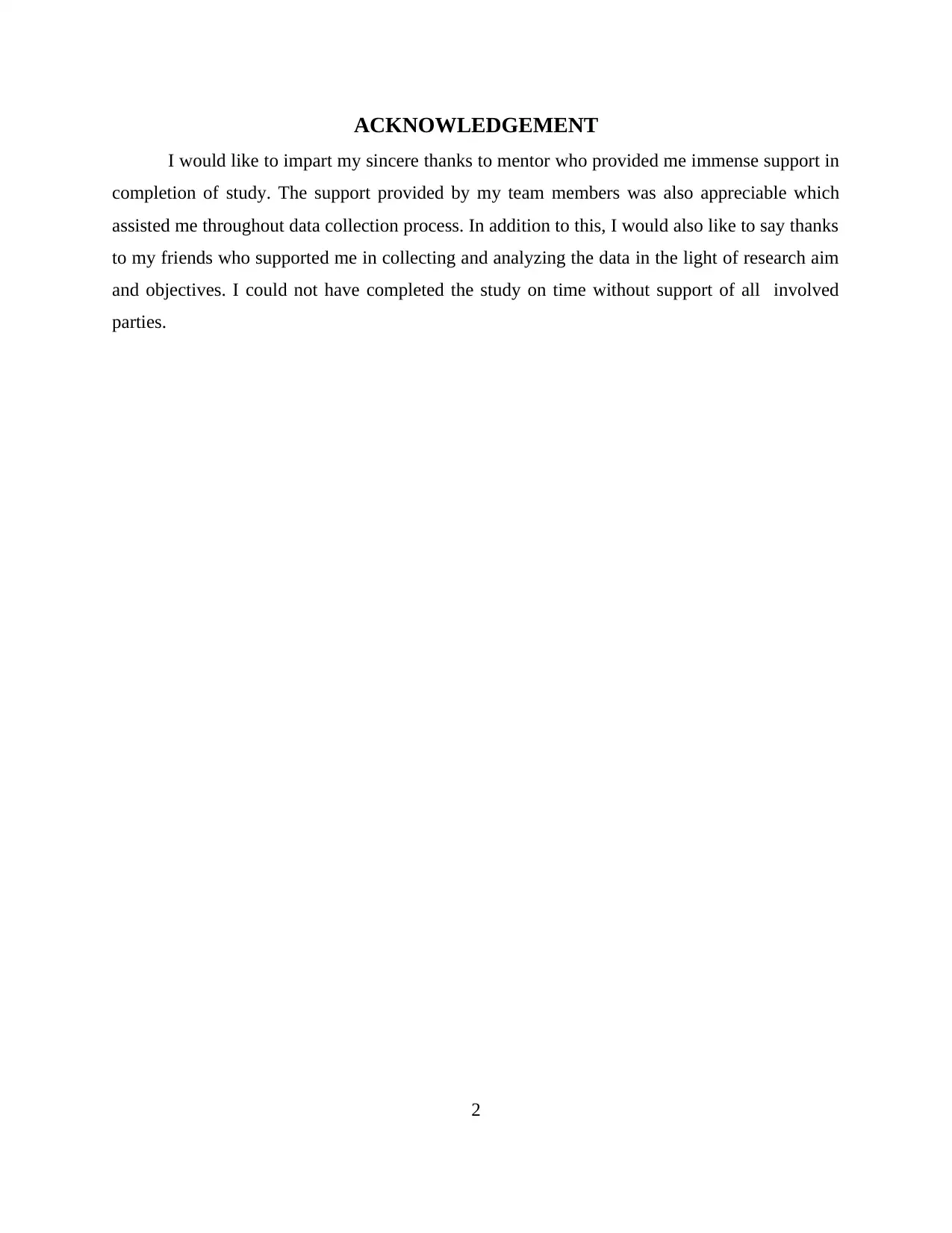
ACKNOWLEDGEMENT
I would like to impart my sincere thanks to mentor who provided me immense support in
completion of study. The support provided by my team members was also appreciable which
assisted me throughout data collection process. In addition to this, I would also like to say thanks
to my friends who supported me in collecting and analyzing the data in the light of research aim
and objectives. I could not have completed the study on time without support of all involved
parties.
2
I would like to impart my sincere thanks to mentor who provided me immense support in
completion of study. The support provided by my team members was also appreciable which
assisted me throughout data collection process. In addition to this, I would also like to say thanks
to my friends who supported me in collecting and analyzing the data in the light of research aim
and objectives. I could not have completed the study on time without support of all involved
parties.
2
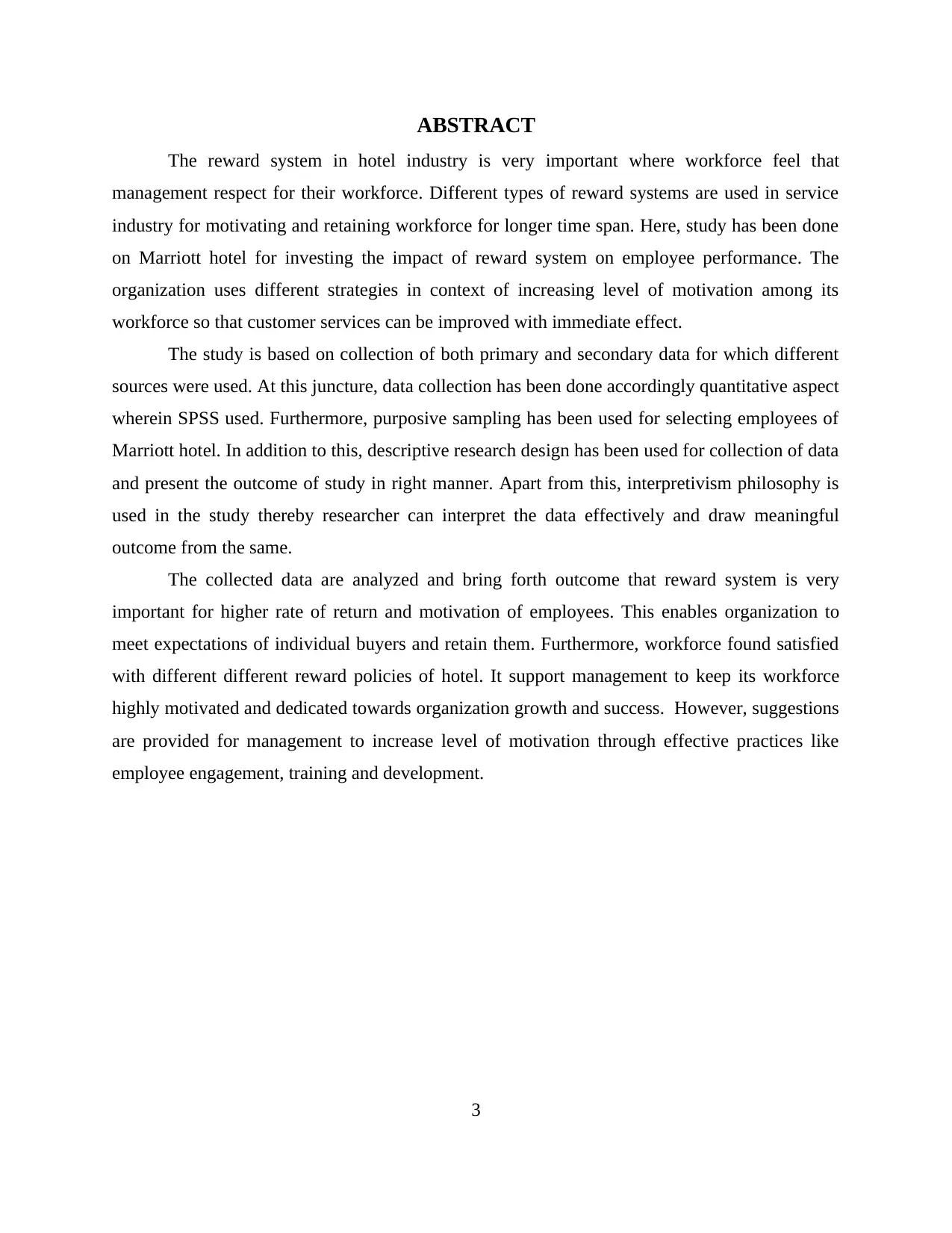
ABSTRACT
The reward system in hotel industry is very important where workforce feel that
management respect for their workforce. Different types of reward systems are used in service
industry for motivating and retaining workforce for longer time span. Here, study has been done
on Marriott hotel for investing the impact of reward system on employee performance. The
organization uses different strategies in context of increasing level of motivation among its
workforce so that customer services can be improved with immediate effect.
The study is based on collection of both primary and secondary data for which different
sources were used. At this juncture, data collection has been done accordingly quantitative aspect
wherein SPSS used. Furthermore, purposive sampling has been used for selecting employees of
Marriott hotel. In addition to this, descriptive research design has been used for collection of data
and present the outcome of study in right manner. Apart from this, interpretivism philosophy is
used in the study thereby researcher can interpret the data effectively and draw meaningful
outcome from the same.
The collected data are analyzed and bring forth outcome that reward system is very
important for higher rate of return and motivation of employees. This enables organization to
meet expectations of individual buyers and retain them. Furthermore, workforce found satisfied
with different different reward policies of hotel. It support management to keep its workforce
highly motivated and dedicated towards organization growth and success. However, suggestions
are provided for management to increase level of motivation through effective practices like
employee engagement, training and development.
3
The reward system in hotel industry is very important where workforce feel that
management respect for their workforce. Different types of reward systems are used in service
industry for motivating and retaining workforce for longer time span. Here, study has been done
on Marriott hotel for investing the impact of reward system on employee performance. The
organization uses different strategies in context of increasing level of motivation among its
workforce so that customer services can be improved with immediate effect.
The study is based on collection of both primary and secondary data for which different
sources were used. At this juncture, data collection has been done accordingly quantitative aspect
wherein SPSS used. Furthermore, purposive sampling has been used for selecting employees of
Marriott hotel. In addition to this, descriptive research design has been used for collection of data
and present the outcome of study in right manner. Apart from this, interpretivism philosophy is
used in the study thereby researcher can interpret the data effectively and draw meaningful
outcome from the same.
The collected data are analyzed and bring forth outcome that reward system is very
important for higher rate of return and motivation of employees. This enables organization to
meet expectations of individual buyers and retain them. Furthermore, workforce found satisfied
with different different reward policies of hotel. It support management to keep its workforce
highly motivated and dedicated towards organization growth and success. However, suggestions
are provided for management to increase level of motivation through effective practices like
employee engagement, training and development.
3
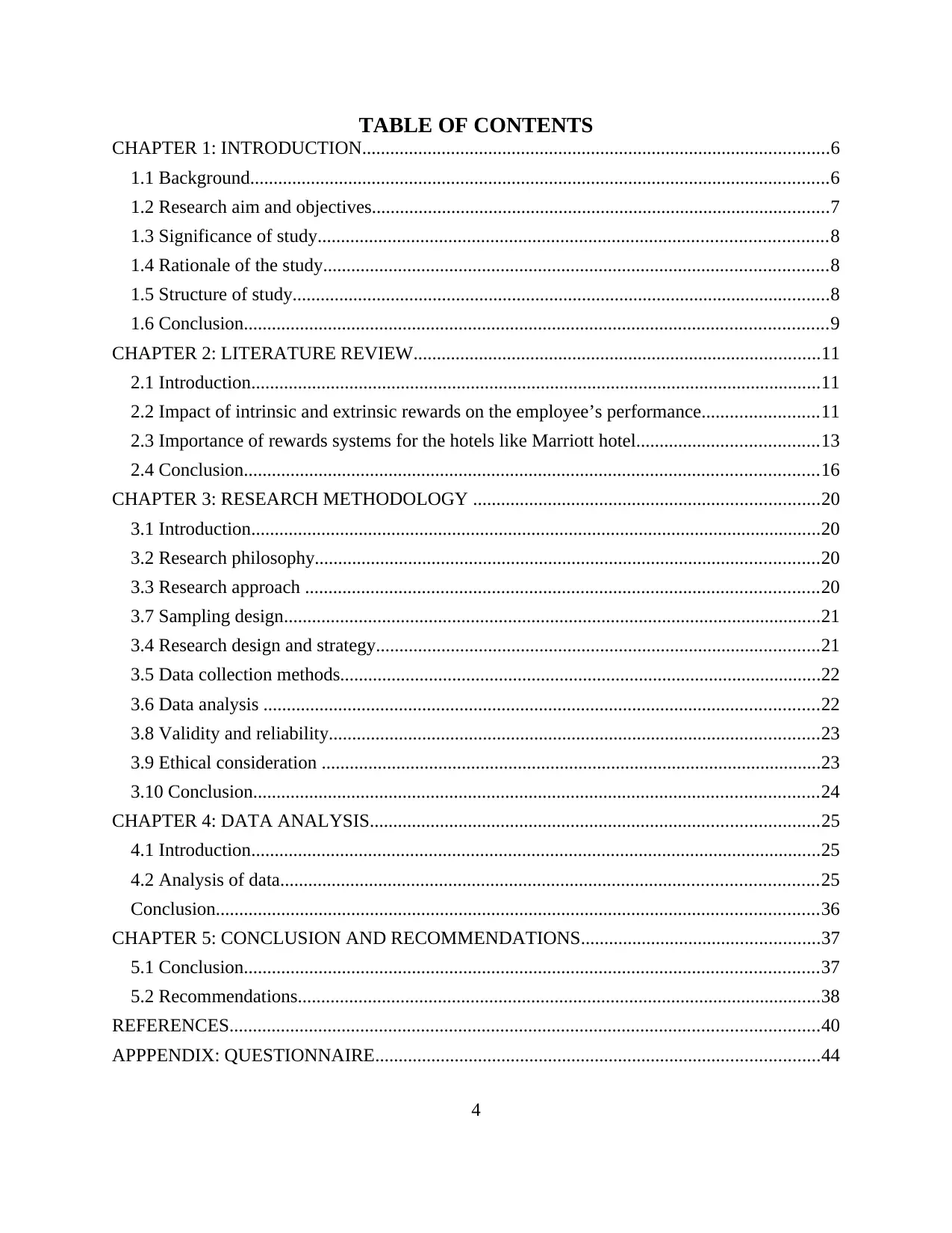
TABLE OF CONTENTS
CHAPTER 1: INTRODUCTION....................................................................................................6
1.1 Background............................................................................................................................6
1.2 Research aim and objectives..................................................................................................7
1.3 Significance of study.............................................................................................................8
1.4 Rationale of the study............................................................................................................8
1.5 Structure of study...................................................................................................................8
1.6 Conclusion.............................................................................................................................9
CHAPTER 2: LITERATURE REVIEW.......................................................................................11
2.1 Introduction..........................................................................................................................11
2.2 Impact of intrinsic and extrinsic rewards on the employee’s performance.........................11
2.3 Importance of rewards systems for the hotels like Marriott hotel.......................................13
2.4 Conclusion...........................................................................................................................16
CHAPTER 3: RESEARCH METHODOLOGY ..........................................................................20
3.1 Introduction..........................................................................................................................20
3.2 Research philosophy............................................................................................................20
3.3 Research approach ..............................................................................................................20
3.7 Sampling design...................................................................................................................21
3.4 Research design and strategy...............................................................................................21
3.5 Data collection methods.......................................................................................................22
3.6 Data analysis .......................................................................................................................22
3.8 Validity and reliability.........................................................................................................23
3.9 Ethical consideration ...........................................................................................................23
3.10 Conclusion.........................................................................................................................24
CHAPTER 4: DATA ANALYSIS................................................................................................25
4.1 Introduction..........................................................................................................................25
4.2 Analysis of data...................................................................................................................25
Conclusion.................................................................................................................................36
CHAPTER 5: CONCLUSION AND RECOMMENDATIONS...................................................37
5.1 Conclusion...........................................................................................................................37
5.2 Recommendations................................................................................................................38
REFERENCES..............................................................................................................................40
APPPENDIX: QUESTIONNAIRE...............................................................................................44
4
CHAPTER 1: INTRODUCTION....................................................................................................6
1.1 Background............................................................................................................................6
1.2 Research aim and objectives..................................................................................................7
1.3 Significance of study.............................................................................................................8
1.4 Rationale of the study............................................................................................................8
1.5 Structure of study...................................................................................................................8
1.6 Conclusion.............................................................................................................................9
CHAPTER 2: LITERATURE REVIEW.......................................................................................11
2.1 Introduction..........................................................................................................................11
2.2 Impact of intrinsic and extrinsic rewards on the employee’s performance.........................11
2.3 Importance of rewards systems for the hotels like Marriott hotel.......................................13
2.4 Conclusion...........................................................................................................................16
CHAPTER 3: RESEARCH METHODOLOGY ..........................................................................20
3.1 Introduction..........................................................................................................................20
3.2 Research philosophy............................................................................................................20
3.3 Research approach ..............................................................................................................20
3.7 Sampling design...................................................................................................................21
3.4 Research design and strategy...............................................................................................21
3.5 Data collection methods.......................................................................................................22
3.6 Data analysis .......................................................................................................................22
3.8 Validity and reliability.........................................................................................................23
3.9 Ethical consideration ...........................................................................................................23
3.10 Conclusion.........................................................................................................................24
CHAPTER 4: DATA ANALYSIS................................................................................................25
4.1 Introduction..........................................................................................................................25
4.2 Analysis of data...................................................................................................................25
Conclusion.................................................................................................................................36
CHAPTER 5: CONCLUSION AND RECOMMENDATIONS...................................................37
5.1 Conclusion...........................................................................................................................37
5.2 Recommendations................................................................................................................38
REFERENCES..............................................................................................................................40
APPPENDIX: QUESTIONNAIRE...............................................................................................44
4
Secure Best Marks with AI Grader
Need help grading? Try our AI Grader for instant feedback on your assignments.

5
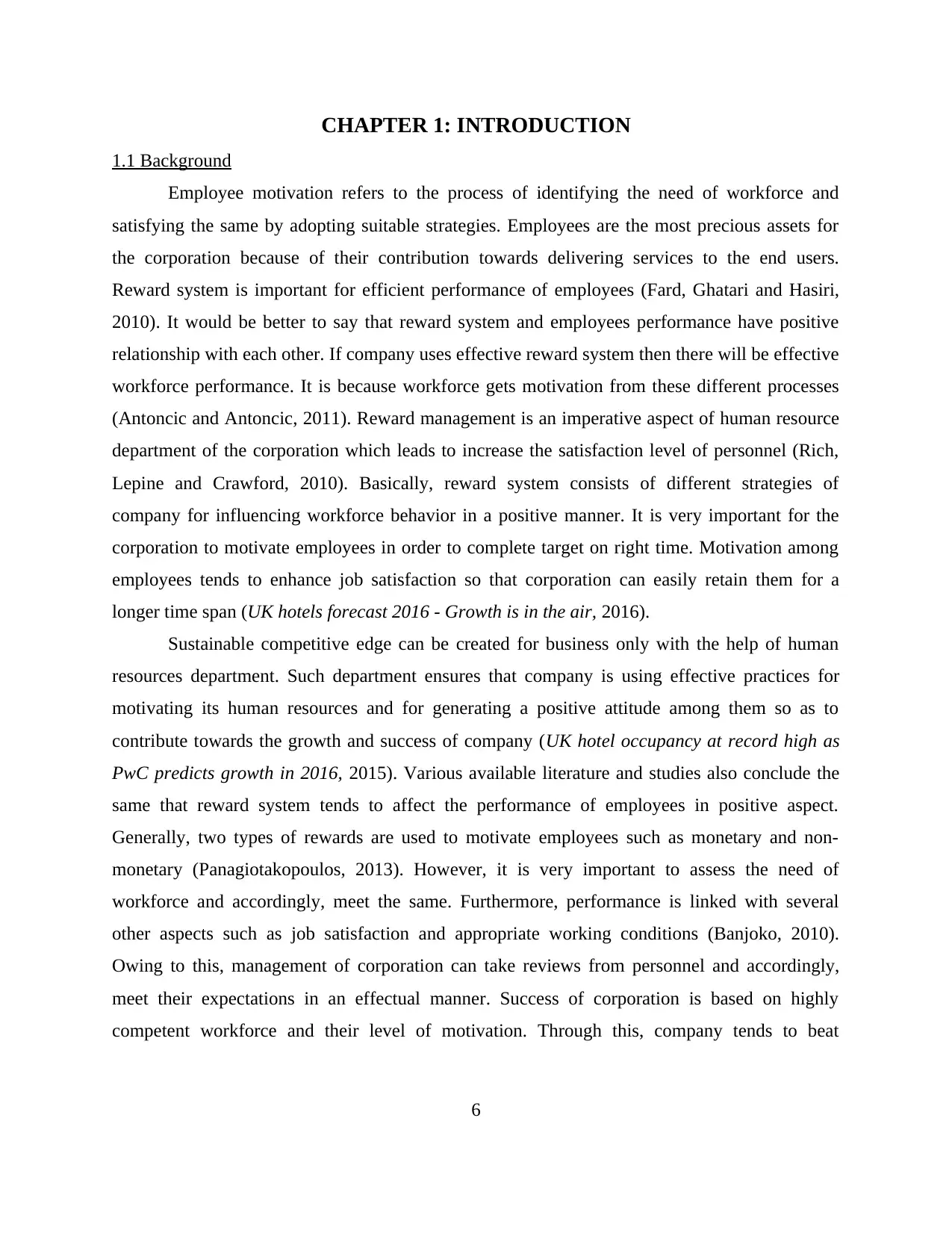
CHAPTER 1: INTRODUCTION
1.1 Background
Employee motivation refers to the process of identifying the need of workforce and
satisfying the same by adopting suitable strategies. Employees are the most precious assets for
the corporation because of their contribution towards delivering services to the end users.
Reward system is important for efficient performance of employees (Fard, Ghatari and Hasiri,
2010). It would be better to say that reward system and employees performance have positive
relationship with each other. If company uses effective reward system then there will be effective
workforce performance. It is because workforce gets motivation from these different processes
(Antoncic and Antoncic, 2011). Reward management is an imperative aspect of human resource
department of the corporation which leads to increase the satisfaction level of personnel (Rich,
Lepine and Crawford, 2010). Basically, reward system consists of different strategies of
company for influencing workforce behavior in a positive manner. It is very important for the
corporation to motivate employees in order to complete target on right time. Motivation among
employees tends to enhance job satisfaction so that corporation can easily retain them for a
longer time span (UK hotels forecast 2016 - Growth is in the air, 2016).
Sustainable competitive edge can be created for business only with the help of human
resources department. Such department ensures that company is using effective practices for
motivating its human resources and for generating a positive attitude among them so as to
contribute towards the growth and success of company (UK hotel occupancy at record high as
PwC predicts growth in 2016, 2015). Various available literature and studies also conclude the
same that reward system tends to affect the performance of employees in positive aspect.
Generally, two types of rewards are used to motivate employees such as monetary and non-
monetary (Panagiotakopoulos, 2013). However, it is very important to assess the need of
workforce and accordingly, meet the same. Furthermore, performance is linked with several
other aspects such as job satisfaction and appropriate working conditions (Banjoko, 2010).
Owing to this, management of corporation can take reviews from personnel and accordingly,
meet their expectations in an effectual manner. Success of corporation is based on highly
competent workforce and their level of motivation. Through this, company tends to beat
6
1.1 Background
Employee motivation refers to the process of identifying the need of workforce and
satisfying the same by adopting suitable strategies. Employees are the most precious assets for
the corporation because of their contribution towards delivering services to the end users.
Reward system is important for efficient performance of employees (Fard, Ghatari and Hasiri,
2010). It would be better to say that reward system and employees performance have positive
relationship with each other. If company uses effective reward system then there will be effective
workforce performance. It is because workforce gets motivation from these different processes
(Antoncic and Antoncic, 2011). Reward management is an imperative aspect of human resource
department of the corporation which leads to increase the satisfaction level of personnel (Rich,
Lepine and Crawford, 2010). Basically, reward system consists of different strategies of
company for influencing workforce behavior in a positive manner. It is very important for the
corporation to motivate employees in order to complete target on right time. Motivation among
employees tends to enhance job satisfaction so that corporation can easily retain them for a
longer time span (UK hotels forecast 2016 - Growth is in the air, 2016).
Sustainable competitive edge can be created for business only with the help of human
resources department. Such department ensures that company is using effective practices for
motivating its human resources and for generating a positive attitude among them so as to
contribute towards the growth and success of company (UK hotel occupancy at record high as
PwC predicts growth in 2016, 2015). Various available literature and studies also conclude the
same that reward system tends to affect the performance of employees in positive aspect.
Generally, two types of rewards are used to motivate employees such as monetary and non-
monetary (Panagiotakopoulos, 2013). However, it is very important to assess the need of
workforce and accordingly, meet the same. Furthermore, performance is linked with several
other aspects such as job satisfaction and appropriate working conditions (Banjoko, 2010).
Owing to this, management of corporation can take reviews from personnel and accordingly,
meet their expectations in an effectual manner. Success of corporation is based on highly
competent workforce and their level of motivation. Through this, company tends to beat
6
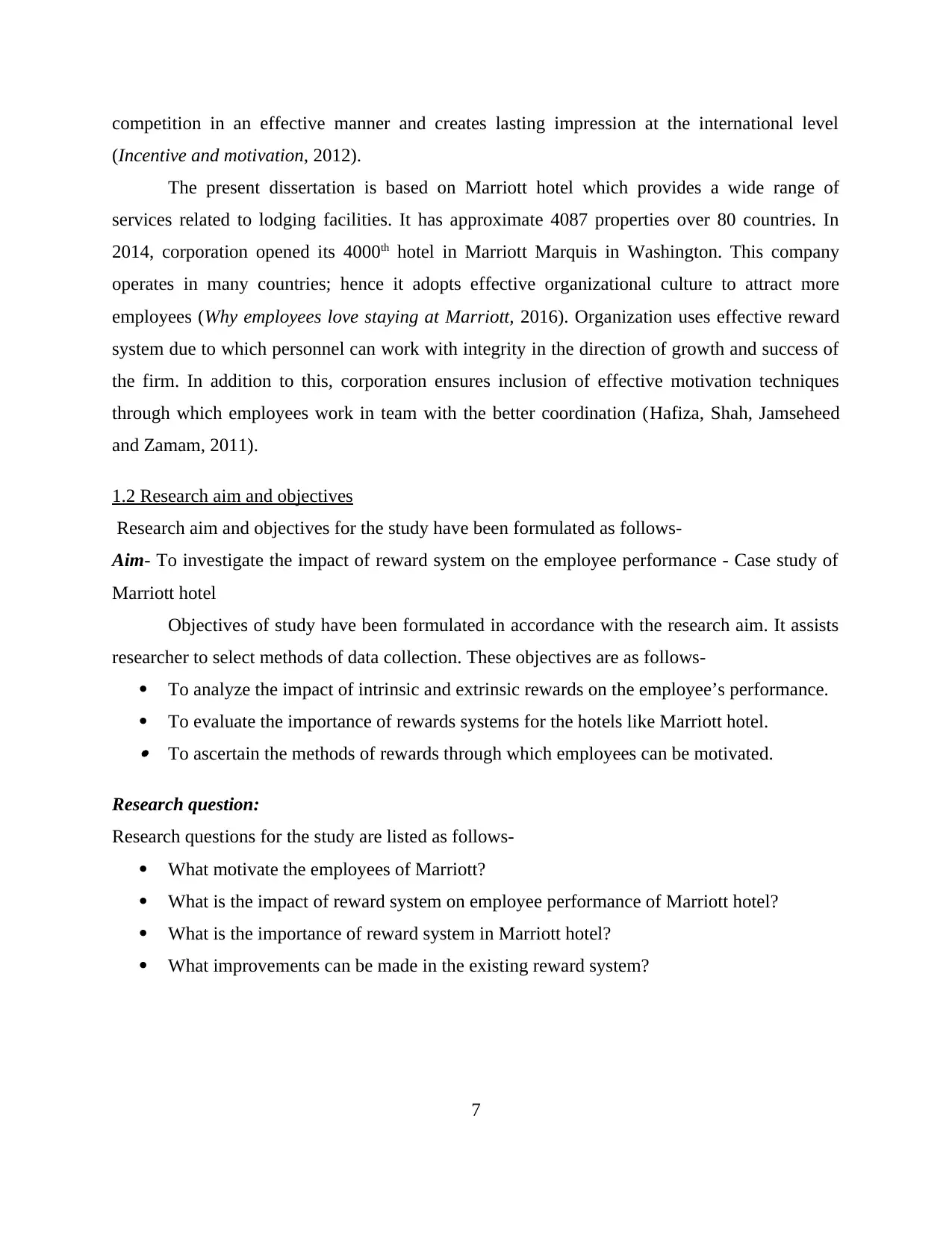
competition in an effective manner and creates lasting impression at the international level
(Incentive and motivation, 2012).
The present dissertation is based on Marriott hotel which provides a wide range of
services related to lodging facilities. It has approximate 4087 properties over 80 countries. In
2014, corporation opened its 4000th hotel in Marriott Marquis in Washington. This company
operates in many countries; hence it adopts effective organizational culture to attract more
employees (Why employees love staying at Marriott, 2016). Organization uses effective reward
system due to which personnel can work with integrity in the direction of growth and success of
the firm. In addition to this, corporation ensures inclusion of effective motivation techniques
through which employees work in team with the better coordination (Hafiza, Shah, Jamseheed
and Zamam, 2011).
1.2 Research aim and objectives
Research aim and objectives for the study have been formulated as follows-
Aim- To investigate the impact of reward system on the employee performance - Case study of
Marriott hotel
Objectives of study have been formulated in accordance with the research aim. It assists
researcher to select methods of data collection. These objectives are as follows-
To analyze the impact of intrinsic and extrinsic rewards on the employee’s performance.
To evaluate the importance of rewards systems for the hotels like Marriott hotel. To ascertain the methods of rewards through which employees can be motivated.
Research question:
Research questions for the study are listed as follows-
What motivate the employees of Marriott?
What is the impact of reward system on employee performance of Marriott hotel?
What is the importance of reward system in Marriott hotel?
What improvements can be made in the existing reward system?
7
(Incentive and motivation, 2012).
The present dissertation is based on Marriott hotel which provides a wide range of
services related to lodging facilities. It has approximate 4087 properties over 80 countries. In
2014, corporation opened its 4000th hotel in Marriott Marquis in Washington. This company
operates in many countries; hence it adopts effective organizational culture to attract more
employees (Why employees love staying at Marriott, 2016). Organization uses effective reward
system due to which personnel can work with integrity in the direction of growth and success of
the firm. In addition to this, corporation ensures inclusion of effective motivation techniques
through which employees work in team with the better coordination (Hafiza, Shah, Jamseheed
and Zamam, 2011).
1.2 Research aim and objectives
Research aim and objectives for the study have been formulated as follows-
Aim- To investigate the impact of reward system on the employee performance - Case study of
Marriott hotel
Objectives of study have been formulated in accordance with the research aim. It assists
researcher to select methods of data collection. These objectives are as follows-
To analyze the impact of intrinsic and extrinsic rewards on the employee’s performance.
To evaluate the importance of rewards systems for the hotels like Marriott hotel. To ascertain the methods of rewards through which employees can be motivated.
Research question:
Research questions for the study are listed as follows-
What motivate the employees of Marriott?
What is the impact of reward system on employee performance of Marriott hotel?
What is the importance of reward system in Marriott hotel?
What improvements can be made in the existing reward system?
7
Paraphrase This Document
Need a fresh take? Get an instant paraphrase of this document with our AI Paraphraser
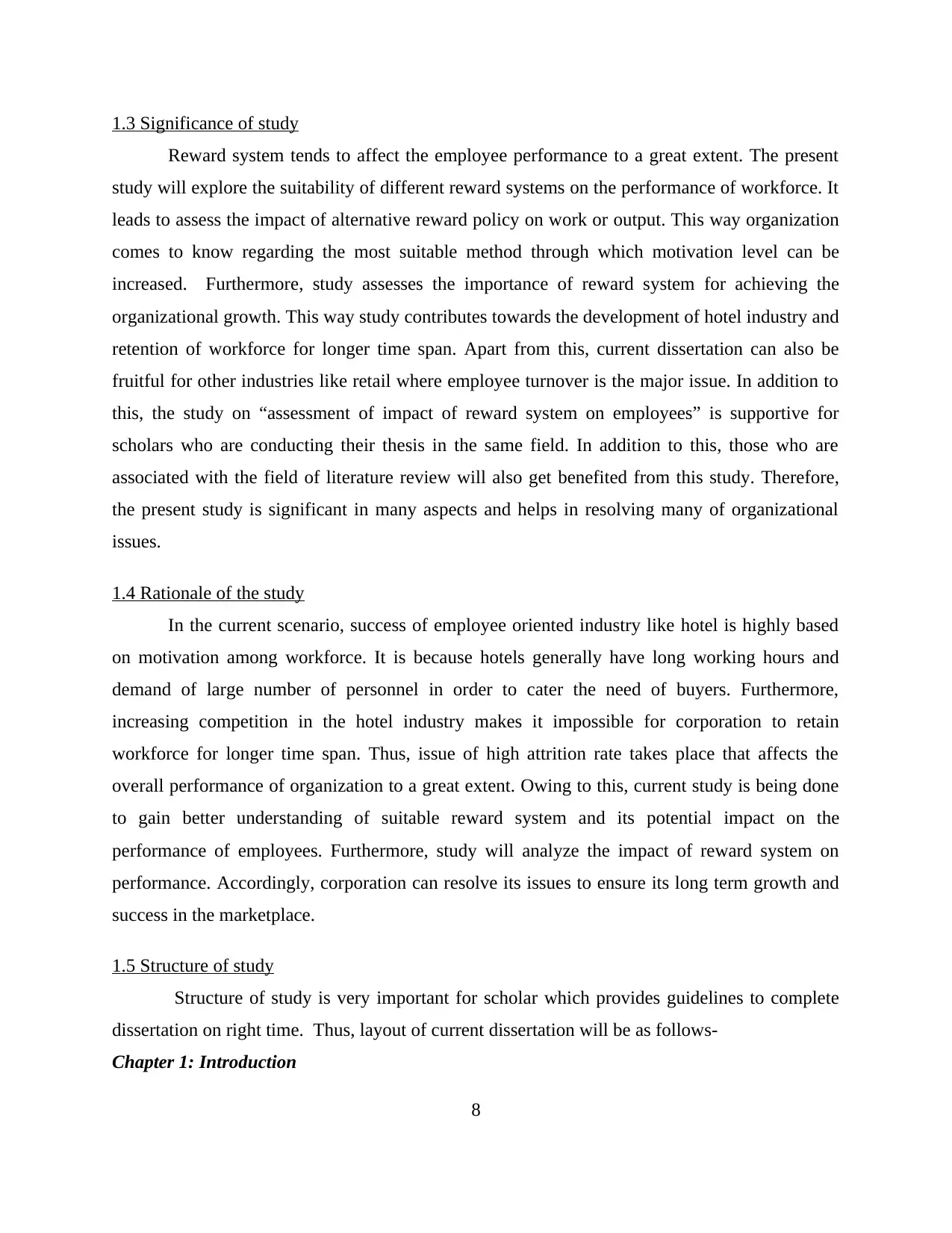
1.3 Significance of study
Reward system tends to affect the employee performance to a great extent. The present
study will explore the suitability of different reward systems on the performance of workforce. It
leads to assess the impact of alternative reward policy on work or output. This way organization
comes to know regarding the most suitable method through which motivation level can be
increased. Furthermore, study assesses the importance of reward system for achieving the
organizational growth. This way study contributes towards the development of hotel industry and
retention of workforce for longer time span. Apart from this, current dissertation can also be
fruitful for other industries like retail where employee turnover is the major issue. In addition to
this, the study on “assessment of impact of reward system on employees” is supportive for
scholars who are conducting their thesis in the same field. In addition to this, those who are
associated with the field of literature review will also get benefited from this study. Therefore,
the present study is significant in many aspects and helps in resolving many of organizational
issues.
1.4 Rationale of the study
In the current scenario, success of employee oriented industry like hotel is highly based
on motivation among workforce. It is because hotels generally have long working hours and
demand of large number of personnel in order to cater the need of buyers. Furthermore,
increasing competition in the hotel industry makes it impossible for corporation to retain
workforce for longer time span. Thus, issue of high attrition rate takes place that affects the
overall performance of organization to a great extent. Owing to this, current study is being done
to gain better understanding of suitable reward system and its potential impact on the
performance of employees. Furthermore, study will analyze the impact of reward system on
performance. Accordingly, corporation can resolve its issues to ensure its long term growth and
success in the marketplace.
1.5 Structure of study
Structure of study is very important for scholar which provides guidelines to complete
dissertation on right time. Thus, layout of current dissertation will be as follows-
Chapter 1: Introduction
8
Reward system tends to affect the employee performance to a great extent. The present
study will explore the suitability of different reward systems on the performance of workforce. It
leads to assess the impact of alternative reward policy on work or output. This way organization
comes to know regarding the most suitable method through which motivation level can be
increased. Furthermore, study assesses the importance of reward system for achieving the
organizational growth. This way study contributes towards the development of hotel industry and
retention of workforce for longer time span. Apart from this, current dissertation can also be
fruitful for other industries like retail where employee turnover is the major issue. In addition to
this, the study on “assessment of impact of reward system on employees” is supportive for
scholars who are conducting their thesis in the same field. In addition to this, those who are
associated with the field of literature review will also get benefited from this study. Therefore,
the present study is significant in many aspects and helps in resolving many of organizational
issues.
1.4 Rationale of the study
In the current scenario, success of employee oriented industry like hotel is highly based
on motivation among workforce. It is because hotels generally have long working hours and
demand of large number of personnel in order to cater the need of buyers. Furthermore,
increasing competition in the hotel industry makes it impossible for corporation to retain
workforce for longer time span. Thus, issue of high attrition rate takes place that affects the
overall performance of organization to a great extent. Owing to this, current study is being done
to gain better understanding of suitable reward system and its potential impact on the
performance of employees. Furthermore, study will analyze the impact of reward system on
performance. Accordingly, corporation can resolve its issues to ensure its long term growth and
success in the marketplace.
1.5 Structure of study
Structure of study is very important for scholar which provides guidelines to complete
dissertation on right time. Thus, layout of current dissertation will be as follows-
Chapter 1: Introduction
8
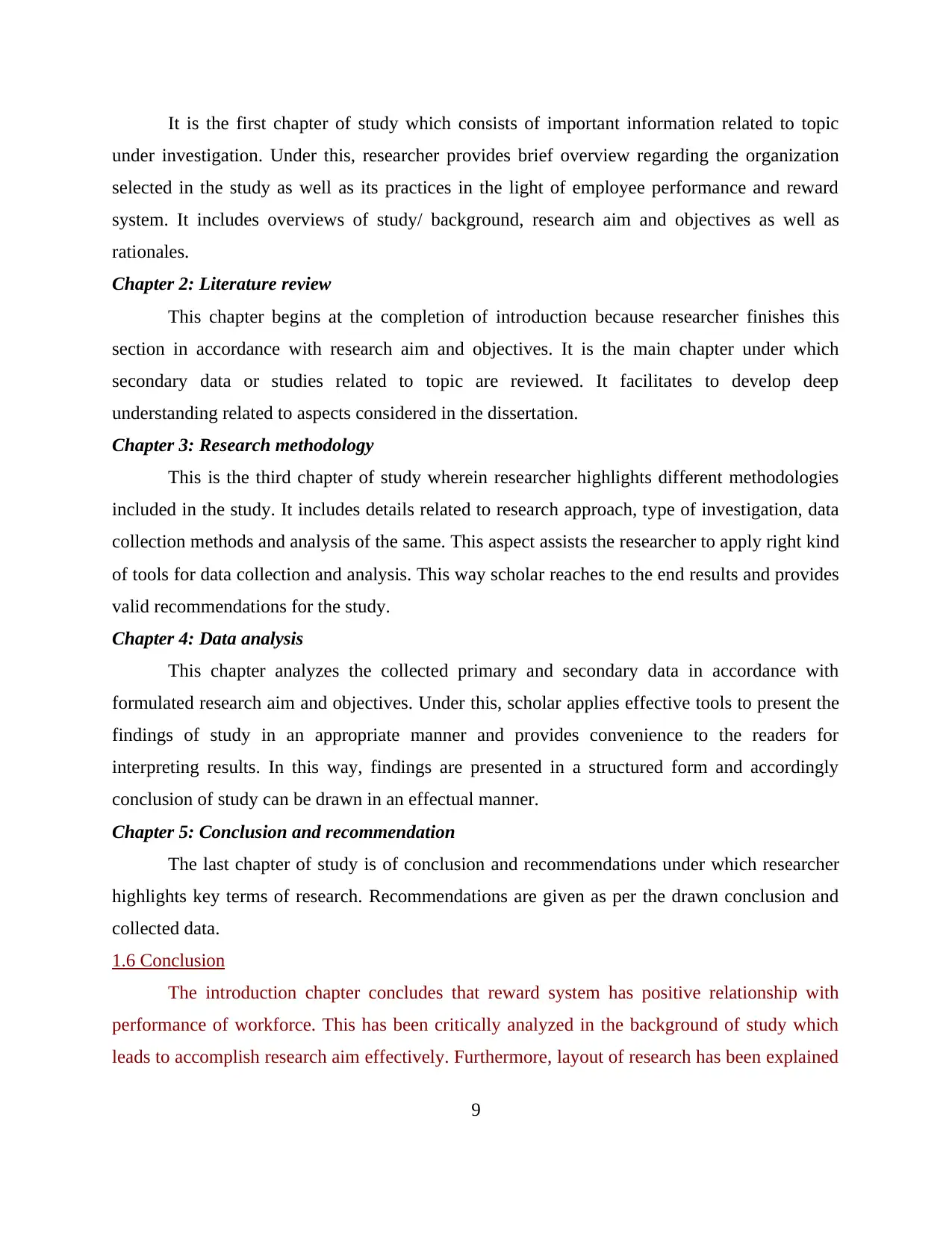
It is the first chapter of study which consists of important information related to topic
under investigation. Under this, researcher provides brief overview regarding the organization
selected in the study as well as its practices in the light of employee performance and reward
system. It includes overviews of study/ background, research aim and objectives as well as
rationales.
Chapter 2: Literature review
This chapter begins at the completion of introduction because researcher finishes this
section in accordance with research aim and objectives. It is the main chapter under which
secondary data or studies related to topic are reviewed. It facilitates to develop deep
understanding related to aspects considered in the dissertation.
Chapter 3: Research methodology
This is the third chapter of study wherein researcher highlights different methodologies
included in the study. It includes details related to research approach, type of investigation, data
collection methods and analysis of the same. This aspect assists the researcher to apply right kind
of tools for data collection and analysis. This way scholar reaches to the end results and provides
valid recommendations for the study.
Chapter 4: Data analysis
This chapter analyzes the collected primary and secondary data in accordance with
formulated research aim and objectives. Under this, scholar applies effective tools to present the
findings of study in an appropriate manner and provides convenience to the readers for
interpreting results. In this way, findings are presented in a structured form and accordingly
conclusion of study can be drawn in an effectual manner.
Chapter 5: Conclusion and recommendation
The last chapter of study is of conclusion and recommendations under which researcher
highlights key terms of research. Recommendations are given as per the drawn conclusion and
collected data.
1.6 Conclusion
The introduction chapter concludes that reward system has positive relationship with
performance of workforce. This has been critically analyzed in the background of study which
leads to accomplish research aim effectively. Furthermore, layout of research has been explained
9
under investigation. Under this, researcher provides brief overview regarding the organization
selected in the study as well as its practices in the light of employee performance and reward
system. It includes overviews of study/ background, research aim and objectives as well as
rationales.
Chapter 2: Literature review
This chapter begins at the completion of introduction because researcher finishes this
section in accordance with research aim and objectives. It is the main chapter under which
secondary data or studies related to topic are reviewed. It facilitates to develop deep
understanding related to aspects considered in the dissertation.
Chapter 3: Research methodology
This is the third chapter of study wherein researcher highlights different methodologies
included in the study. It includes details related to research approach, type of investigation, data
collection methods and analysis of the same. This aspect assists the researcher to apply right kind
of tools for data collection and analysis. This way scholar reaches to the end results and provides
valid recommendations for the study.
Chapter 4: Data analysis
This chapter analyzes the collected primary and secondary data in accordance with
formulated research aim and objectives. Under this, scholar applies effective tools to present the
findings of study in an appropriate manner and provides convenience to the readers for
interpreting results. In this way, findings are presented in a structured form and accordingly
conclusion of study can be drawn in an effectual manner.
Chapter 5: Conclusion and recommendation
The last chapter of study is of conclusion and recommendations under which researcher
highlights key terms of research. Recommendations are given as per the drawn conclusion and
collected data.
1.6 Conclusion
The introduction chapter concludes that reward system has positive relationship with
performance of workforce. This has been critically analyzed in the background of study which
leads to accomplish research aim effectively. Furthermore, layout of research has been explained
9
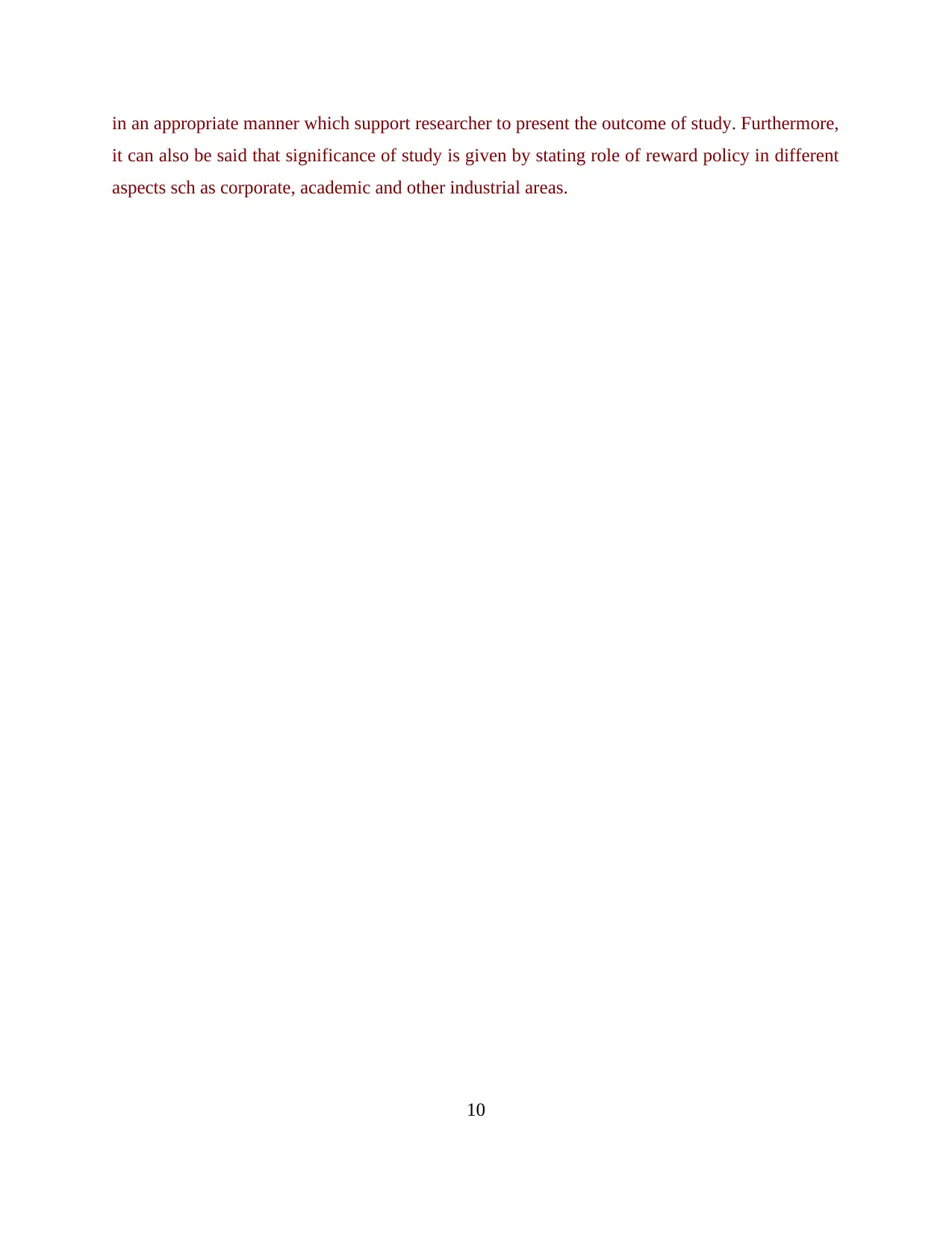
in an appropriate manner which support researcher to present the outcome of study. Furthermore,
it can also be said that significance of study is given by stating role of reward policy in different
aspects sch as corporate, academic and other industrial areas.
10
it can also be said that significance of study is given by stating role of reward policy in different
aspects sch as corporate, academic and other industrial areas.
10
Secure Best Marks with AI Grader
Need help grading? Try our AI Grader for instant feedback on your assignments.
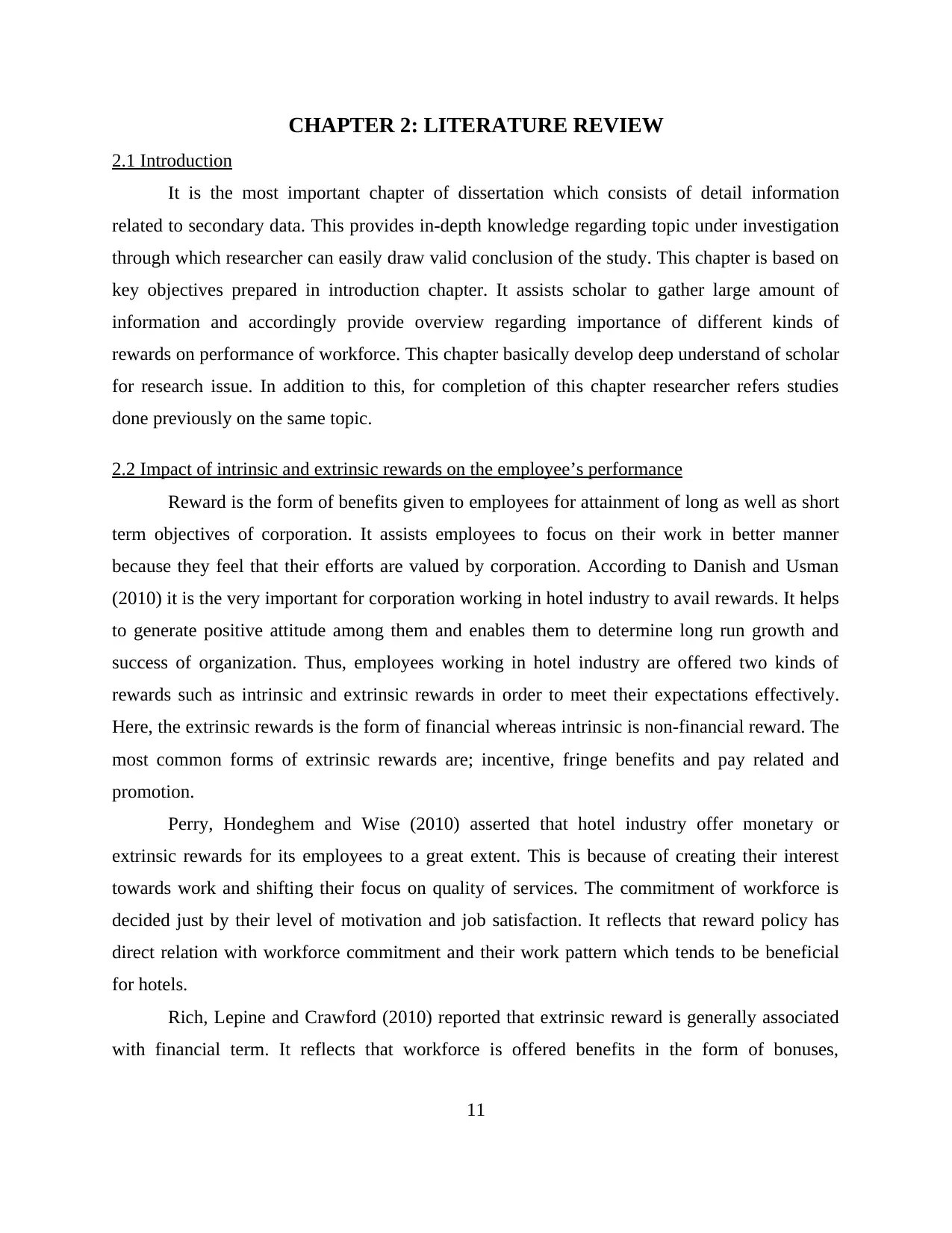
CHAPTER 2: LITERATURE REVIEW
2.1 Introduction
It is the most important chapter of dissertation which consists of detail information
related to secondary data. This provides in-depth knowledge regarding topic under investigation
through which researcher can easily draw valid conclusion of the study. This chapter is based on
key objectives prepared in introduction chapter. It assists scholar to gather large amount of
information and accordingly provide overview regarding importance of different kinds of
rewards on performance of workforce. This chapter basically develop deep understand of scholar
for research issue. In addition to this, for completion of this chapter researcher refers studies
done previously on the same topic.
2.2 Impact of intrinsic and extrinsic rewards on the employee’s performance
Reward is the form of benefits given to employees for attainment of long as well as short
term objectives of corporation. It assists employees to focus on their work in better manner
because they feel that their efforts are valued by corporation. According to Danish and Usman
(2010) it is the very important for corporation working in hotel industry to avail rewards. It helps
to generate positive attitude among them and enables them to determine long run growth and
success of organization. Thus, employees working in hotel industry are offered two kinds of
rewards such as intrinsic and extrinsic rewards in order to meet their expectations effectively.
Here, the extrinsic rewards is the form of financial whereas intrinsic is non-financial reward. The
most common forms of extrinsic rewards are; incentive, fringe benefits and pay related and
promotion.
Perry, Hondeghem and Wise (2010) asserted that hotel industry offer monetary or
extrinsic rewards for its employees to a great extent. This is because of creating their interest
towards work and shifting their focus on quality of services. The commitment of workforce is
decided just by their level of motivation and job satisfaction. It reflects that reward policy has
direct relation with workforce commitment and their work pattern which tends to be beneficial
for hotels.
Rich, Lepine and Crawford (2010) reported that extrinsic reward is generally associated
with financial term. It reflects that workforce is offered benefits in the form of bonuses,
11
2.1 Introduction
It is the most important chapter of dissertation which consists of detail information
related to secondary data. This provides in-depth knowledge regarding topic under investigation
through which researcher can easily draw valid conclusion of the study. This chapter is based on
key objectives prepared in introduction chapter. It assists scholar to gather large amount of
information and accordingly provide overview regarding importance of different kinds of
rewards on performance of workforce. This chapter basically develop deep understand of scholar
for research issue. In addition to this, for completion of this chapter researcher refers studies
done previously on the same topic.
2.2 Impact of intrinsic and extrinsic rewards on the employee’s performance
Reward is the form of benefits given to employees for attainment of long as well as short
term objectives of corporation. It assists employees to focus on their work in better manner
because they feel that their efforts are valued by corporation. According to Danish and Usman
(2010) it is the very important for corporation working in hotel industry to avail rewards. It helps
to generate positive attitude among them and enables them to determine long run growth and
success of organization. Thus, employees working in hotel industry are offered two kinds of
rewards such as intrinsic and extrinsic rewards in order to meet their expectations effectively.
Here, the extrinsic rewards is the form of financial whereas intrinsic is non-financial reward. The
most common forms of extrinsic rewards are; incentive, fringe benefits and pay related and
promotion.
Perry, Hondeghem and Wise (2010) asserted that hotel industry offer monetary or
extrinsic rewards for its employees to a great extent. This is because of creating their interest
towards work and shifting their focus on quality of services. The commitment of workforce is
decided just by their level of motivation and job satisfaction. It reflects that reward policy has
direct relation with workforce commitment and their work pattern which tends to be beneficial
for hotels.
Rich, Lepine and Crawford (2010) reported that extrinsic reward is generally associated
with financial term. It reflects that workforce is offered benefits in the form of bonuses,
11
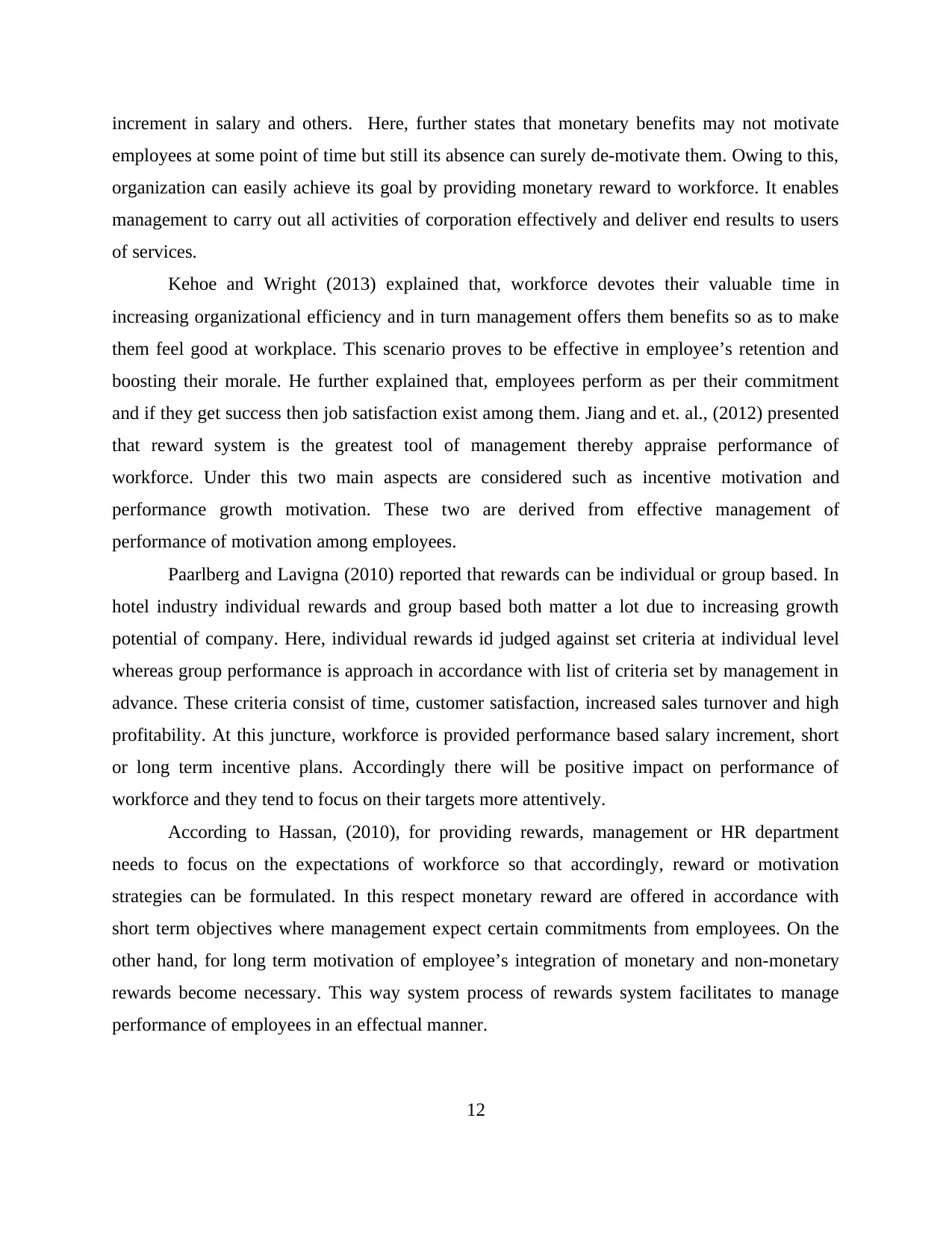
increment in salary and others. Here, further states that monetary benefits may not motivate
employees at some point of time but still its absence can surely de-motivate them. Owing to this,
organization can easily achieve its goal by providing monetary reward to workforce. It enables
management to carry out all activities of corporation effectively and deliver end results to users
of services.
Kehoe and Wright (2013) explained that, workforce devotes their valuable time in
increasing organizational efficiency and in turn management offers them benefits so as to make
them feel good at workplace. This scenario proves to be effective in employee’s retention and
boosting their morale. He further explained that, employees perform as per their commitment
and if they get success then job satisfaction exist among them. Jiang and et. al., (2012) presented
that reward system is the greatest tool of management thereby appraise performance of
workforce. Under this two main aspects are considered such as incentive motivation and
performance growth motivation. These two are derived from effective management of
performance of motivation among employees.
Paarlberg and Lavigna (2010) reported that rewards can be individual or group based. In
hotel industry individual rewards and group based both matter a lot due to increasing growth
potential of company. Here, individual rewards id judged against set criteria at individual level
whereas group performance is approach in accordance with list of criteria set by management in
advance. These criteria consist of time, customer satisfaction, increased sales turnover and high
profitability. At this juncture, workforce is provided performance based salary increment, short
or long term incentive plans. Accordingly there will be positive impact on performance of
workforce and they tend to focus on their targets more attentively.
According to Hassan, (2010), for providing rewards, management or HR department
needs to focus on the expectations of workforce so that accordingly, reward or motivation
strategies can be formulated. In this respect monetary reward are offered in accordance with
short term objectives where management expect certain commitments from employees. On the
other hand, for long term motivation of employee’s integration of monetary and non-monetary
rewards become necessary. This way system process of rewards system facilitates to manage
performance of employees in an effectual manner.
12
employees at some point of time but still its absence can surely de-motivate them. Owing to this,
organization can easily achieve its goal by providing monetary reward to workforce. It enables
management to carry out all activities of corporation effectively and deliver end results to users
of services.
Kehoe and Wright (2013) explained that, workforce devotes their valuable time in
increasing organizational efficiency and in turn management offers them benefits so as to make
them feel good at workplace. This scenario proves to be effective in employee’s retention and
boosting their morale. He further explained that, employees perform as per their commitment
and if they get success then job satisfaction exist among them. Jiang and et. al., (2012) presented
that reward system is the greatest tool of management thereby appraise performance of
workforce. Under this two main aspects are considered such as incentive motivation and
performance growth motivation. These two are derived from effective management of
performance of motivation among employees.
Paarlberg and Lavigna (2010) reported that rewards can be individual or group based. In
hotel industry individual rewards and group based both matter a lot due to increasing growth
potential of company. Here, individual rewards id judged against set criteria at individual level
whereas group performance is approach in accordance with list of criteria set by management in
advance. These criteria consist of time, customer satisfaction, increased sales turnover and high
profitability. At this juncture, workforce is provided performance based salary increment, short
or long term incentive plans. Accordingly there will be positive impact on performance of
workforce and they tend to focus on their targets more attentively.
According to Hassan, (2010), for providing rewards, management or HR department
needs to focus on the expectations of workforce so that accordingly, reward or motivation
strategies can be formulated. In this respect monetary reward are offered in accordance with
short term objectives where management expect certain commitments from employees. On the
other hand, for long term motivation of employee’s integration of monetary and non-monetary
rewards become necessary. This way system process of rewards system facilitates to manage
performance of employees in an effectual manner.
12
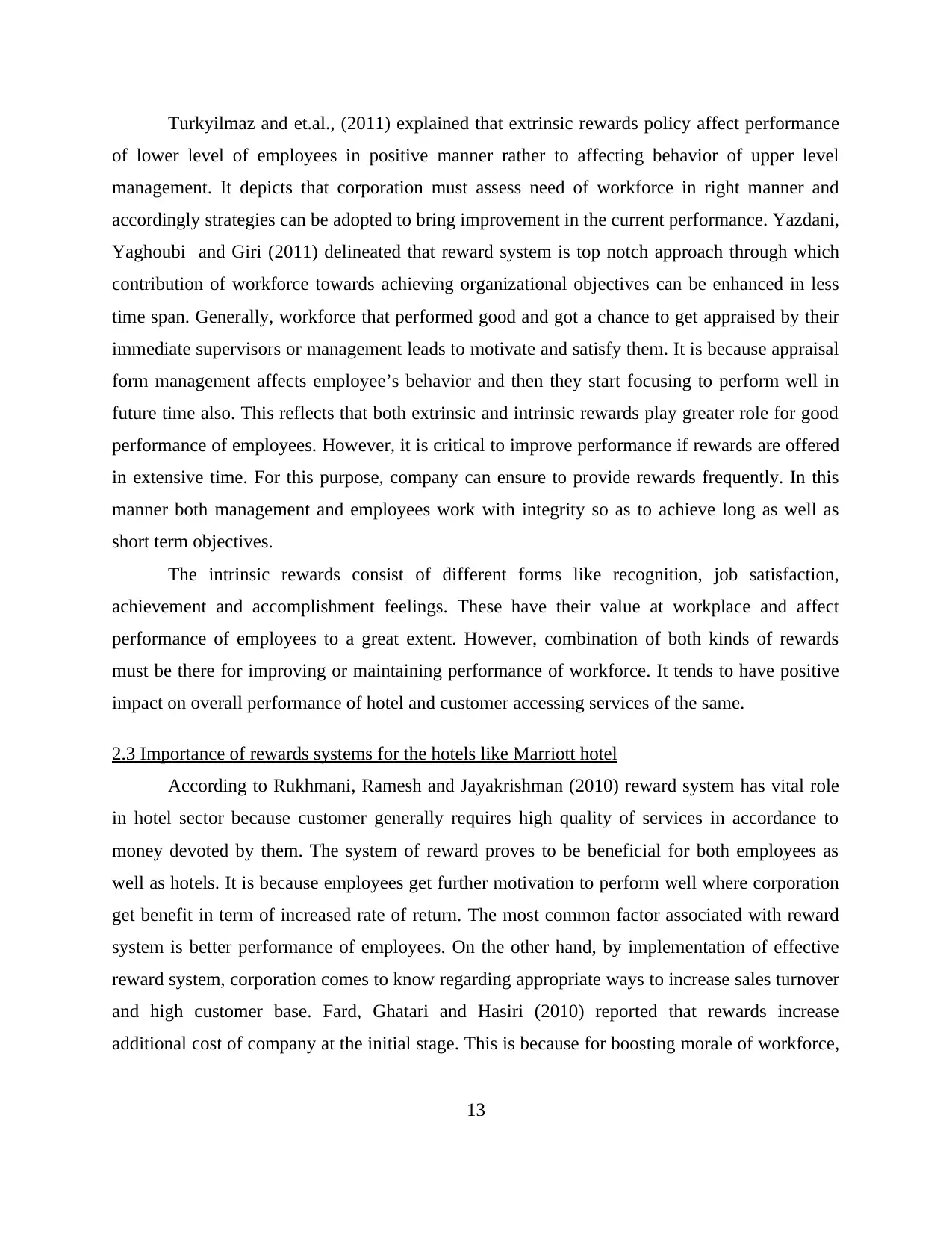
Turkyilmaz and et.al., (2011) explained that extrinsic rewards policy affect performance
of lower level of employees in positive manner rather to affecting behavior of upper level
management. It depicts that corporation must assess need of workforce in right manner and
accordingly strategies can be adopted to bring improvement in the current performance. Yazdani,
Yaghoubi and Giri (2011) delineated that reward system is top notch approach through which
contribution of workforce towards achieving organizational objectives can be enhanced in less
time span. Generally, workforce that performed good and got a chance to get appraised by their
immediate supervisors or management leads to motivate and satisfy them. It is because appraisal
form management affects employee’s behavior and then they start focusing to perform well in
future time also. This reflects that both extrinsic and intrinsic rewards play greater role for good
performance of employees. However, it is critical to improve performance if rewards are offered
in extensive time. For this purpose, company can ensure to provide rewards frequently. In this
manner both management and employees work with integrity so as to achieve long as well as
short term objectives.
The intrinsic rewards consist of different forms like recognition, job satisfaction,
achievement and accomplishment feelings. These have their value at workplace and affect
performance of employees to a great extent. However, combination of both kinds of rewards
must be there for improving or maintaining performance of workforce. It tends to have positive
impact on overall performance of hotel and customer accessing services of the same.
2.3 Importance of rewards systems for the hotels like Marriott hotel
According to Rukhmani, Ramesh and Jayakrishman (2010) reward system has vital role
in hotel sector because customer generally requires high quality of services in accordance to
money devoted by them. The system of reward proves to be beneficial for both employees as
well as hotels. It is because employees get further motivation to perform well where corporation
get benefit in term of increased rate of return. The most common factor associated with reward
system is better performance of employees. On the other hand, by implementation of effective
reward system, corporation comes to know regarding appropriate ways to increase sales turnover
and high customer base. Fard, Ghatari and Hasiri (2010) reported that rewards increase
additional cost of company at the initial stage. This is because for boosting morale of workforce,
13
of lower level of employees in positive manner rather to affecting behavior of upper level
management. It depicts that corporation must assess need of workforce in right manner and
accordingly strategies can be adopted to bring improvement in the current performance. Yazdani,
Yaghoubi and Giri (2011) delineated that reward system is top notch approach through which
contribution of workforce towards achieving organizational objectives can be enhanced in less
time span. Generally, workforce that performed good and got a chance to get appraised by their
immediate supervisors or management leads to motivate and satisfy them. It is because appraisal
form management affects employee’s behavior and then they start focusing to perform well in
future time also. This reflects that both extrinsic and intrinsic rewards play greater role for good
performance of employees. However, it is critical to improve performance if rewards are offered
in extensive time. For this purpose, company can ensure to provide rewards frequently. In this
manner both management and employees work with integrity so as to achieve long as well as
short term objectives.
The intrinsic rewards consist of different forms like recognition, job satisfaction,
achievement and accomplishment feelings. These have their value at workplace and affect
performance of employees to a great extent. However, combination of both kinds of rewards
must be there for improving or maintaining performance of workforce. It tends to have positive
impact on overall performance of hotel and customer accessing services of the same.
2.3 Importance of rewards systems for the hotels like Marriott hotel
According to Rukhmani, Ramesh and Jayakrishman (2010) reward system has vital role
in hotel sector because customer generally requires high quality of services in accordance to
money devoted by them. The system of reward proves to be beneficial for both employees as
well as hotels. It is because employees get further motivation to perform well where corporation
get benefit in term of increased rate of return. The most common factor associated with reward
system is better performance of employees. On the other hand, by implementation of effective
reward system, corporation comes to know regarding appropriate ways to increase sales turnover
and high customer base. Fard, Ghatari and Hasiri (2010) reported that rewards increase
additional cost of company at the initial stage. This is because for boosting morale of workforce,
13
Paraphrase This Document
Need a fresh take? Get an instant paraphrase of this document with our AI Paraphraser
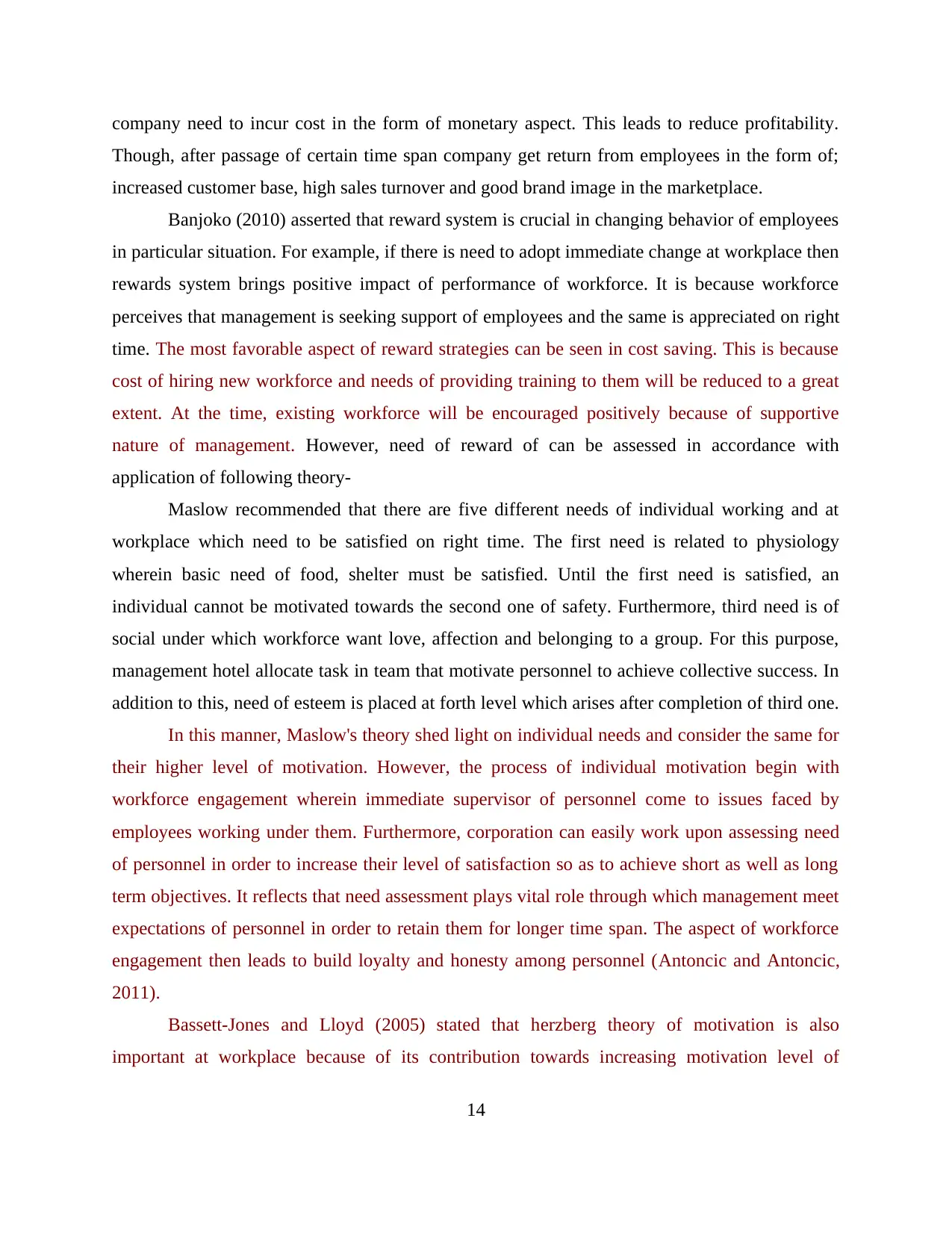
company need to incur cost in the form of monetary aspect. This leads to reduce profitability.
Though, after passage of certain time span company get return from employees in the form of;
increased customer base, high sales turnover and good brand image in the marketplace.
Banjoko (2010) asserted that reward system is crucial in changing behavior of employees
in particular situation. For example, if there is need to adopt immediate change at workplace then
rewards system brings positive impact of performance of workforce. It is because workforce
perceives that management is seeking support of employees and the same is appreciated on right
time. The most favorable aspect of reward strategies can be seen in cost saving. This is because
cost of hiring new workforce and needs of providing training to them will be reduced to a great
extent. At the time, existing workforce will be encouraged positively because of supportive
nature of management. However, need of reward of can be assessed in accordance with
application of following theory-
Maslow recommended that there are five different needs of individual working and at
workplace which need to be satisfied on right time. The first need is related to physiology
wherein basic need of food, shelter must be satisfied. Until the first need is satisfied, an
individual cannot be motivated towards the second one of safety. Furthermore, third need is of
social under which workforce want love, affection and belonging to a group. For this purpose,
management hotel allocate task in team that motivate personnel to achieve collective success. In
addition to this, need of esteem is placed at forth level which arises after completion of third one.
In this manner, Maslow's theory shed light on individual needs and consider the same for
their higher level of motivation. However, the process of individual motivation begin with
workforce engagement wherein immediate supervisor of personnel come to issues faced by
employees working under them. Furthermore, corporation can easily work upon assessing need
of personnel in order to increase their level of satisfaction so as to achieve short as well as long
term objectives. It reflects that need assessment plays vital role through which management meet
expectations of personnel in order to retain them for longer time span. The aspect of workforce
engagement then leads to build loyalty and honesty among personnel (Antoncic and Antoncic,
2011).
Bassett‐Jones and Lloyd (2005) stated that herzberg theory of motivation is also
important at workplace because of its contribution towards increasing motivation level of
14
Though, after passage of certain time span company get return from employees in the form of;
increased customer base, high sales turnover and good brand image in the marketplace.
Banjoko (2010) asserted that reward system is crucial in changing behavior of employees
in particular situation. For example, if there is need to adopt immediate change at workplace then
rewards system brings positive impact of performance of workforce. It is because workforce
perceives that management is seeking support of employees and the same is appreciated on right
time. The most favorable aspect of reward strategies can be seen in cost saving. This is because
cost of hiring new workforce and needs of providing training to them will be reduced to a great
extent. At the time, existing workforce will be encouraged positively because of supportive
nature of management. However, need of reward of can be assessed in accordance with
application of following theory-
Maslow recommended that there are five different needs of individual working and at
workplace which need to be satisfied on right time. The first need is related to physiology
wherein basic need of food, shelter must be satisfied. Until the first need is satisfied, an
individual cannot be motivated towards the second one of safety. Furthermore, third need is of
social under which workforce want love, affection and belonging to a group. For this purpose,
management hotel allocate task in team that motivate personnel to achieve collective success. In
addition to this, need of esteem is placed at forth level which arises after completion of third one.
In this manner, Maslow's theory shed light on individual needs and consider the same for
their higher level of motivation. However, the process of individual motivation begin with
workforce engagement wherein immediate supervisor of personnel come to issues faced by
employees working under them. Furthermore, corporation can easily work upon assessing need
of personnel in order to increase their level of satisfaction so as to achieve short as well as long
term objectives. It reflects that need assessment plays vital role through which management meet
expectations of personnel in order to retain them for longer time span. The aspect of workforce
engagement then leads to build loyalty and honesty among personnel (Antoncic and Antoncic,
2011).
Bassett‐Jones and Lloyd (2005) stated that herzberg theory of motivation is also
important at workplace because of its contribution towards increasing motivation level of
14

workforce. It is also known as two factor theory where one contribute towards maintaining
satisfaction level of employees at workplace. On the other hand, other set of theory cause
dissatisfaction among personnel. The motivating factors consists of challenging work,
achievement of personnel and sense of importance in company as well as recognition or
appreciation on better performance. This all factors play active role in enhancing motivation
level of employees (Banjoko, 2010.). It can be critically evaluated that absence of all these
motivation factor tends to affect performance of individual to a great extent that might increase
attrition rate in company. Apart from this, hygiene factors such as salary, fringe benefits and job
security are also some of the important elements.
Roseanne, Moody and Pesut (2006) reported that these elements are known as
maintenance factors which might cause dissatisfaction. Owing to this, different ways are adopted
by corporation to increase motivation level of employees. In this regard, positive work culture is
created along with high security and reasonable pay scale. This facilitates to deliver good quality
of products and services to end users as motivated workforce tend to focus on customer
satisfaction. Along with that, it is important for management of an organization to given equal
importance to motivating factors which is one of the most important aspect to retain workforce
with great motivation.
Therefore, Lawrence and Jordan (2009) asserted that before starting the process of
employee motivation it becomes crucial to ensure inclusion of job satisfaction at workplace.
However, four possible combinations are there for two factor theory of Herzberg. Here, the first
one is of higher level of motivation which is derived through high motivation and high hygiene.
The second situation is of less motivated workforce with few issues and it is derived from low
motivation and high hygiene. In addition to this, third step is of low hygiene and high motivation
wherein job is satisfactory but pay scale does not give motivation to workforce. At last, low
hygiene and low motivation is also crucial outcome under which no at all motivated and possess
number of issues related to job as well as pay scale.
Process theory is also another form of motivation which reflects that psychological
process tends to have impact on motivation of employees. This is associated with motivation in
three perspectives such as perception of equity, goals and expectations. It depicts that how
15
satisfaction level of employees at workplace. On the other hand, other set of theory cause
dissatisfaction among personnel. The motivating factors consists of challenging work,
achievement of personnel and sense of importance in company as well as recognition or
appreciation on better performance. This all factors play active role in enhancing motivation
level of employees (Banjoko, 2010.). It can be critically evaluated that absence of all these
motivation factor tends to affect performance of individual to a great extent that might increase
attrition rate in company. Apart from this, hygiene factors such as salary, fringe benefits and job
security are also some of the important elements.
Roseanne, Moody and Pesut (2006) reported that these elements are known as
maintenance factors which might cause dissatisfaction. Owing to this, different ways are adopted
by corporation to increase motivation level of employees. In this regard, positive work culture is
created along with high security and reasonable pay scale. This facilitates to deliver good quality
of products and services to end users as motivated workforce tend to focus on customer
satisfaction. Along with that, it is important for management of an organization to given equal
importance to motivating factors which is one of the most important aspect to retain workforce
with great motivation.
Therefore, Lawrence and Jordan (2009) asserted that before starting the process of
employee motivation it becomes crucial to ensure inclusion of job satisfaction at workplace.
However, four possible combinations are there for two factor theory of Herzberg. Here, the first
one is of higher level of motivation which is derived through high motivation and high hygiene.
The second situation is of less motivated workforce with few issues and it is derived from low
motivation and high hygiene. In addition to this, third step is of low hygiene and high motivation
wherein job is satisfactory but pay scale does not give motivation to workforce. At last, low
hygiene and low motivation is also crucial outcome under which no at all motivated and possess
number of issues related to job as well as pay scale.
Process theory is also another form of motivation which reflects that psychological
process tends to have impact on motivation of employees. This is associated with motivation in
three perspectives such as perception of equity, goals and expectations. It depicts that how
15
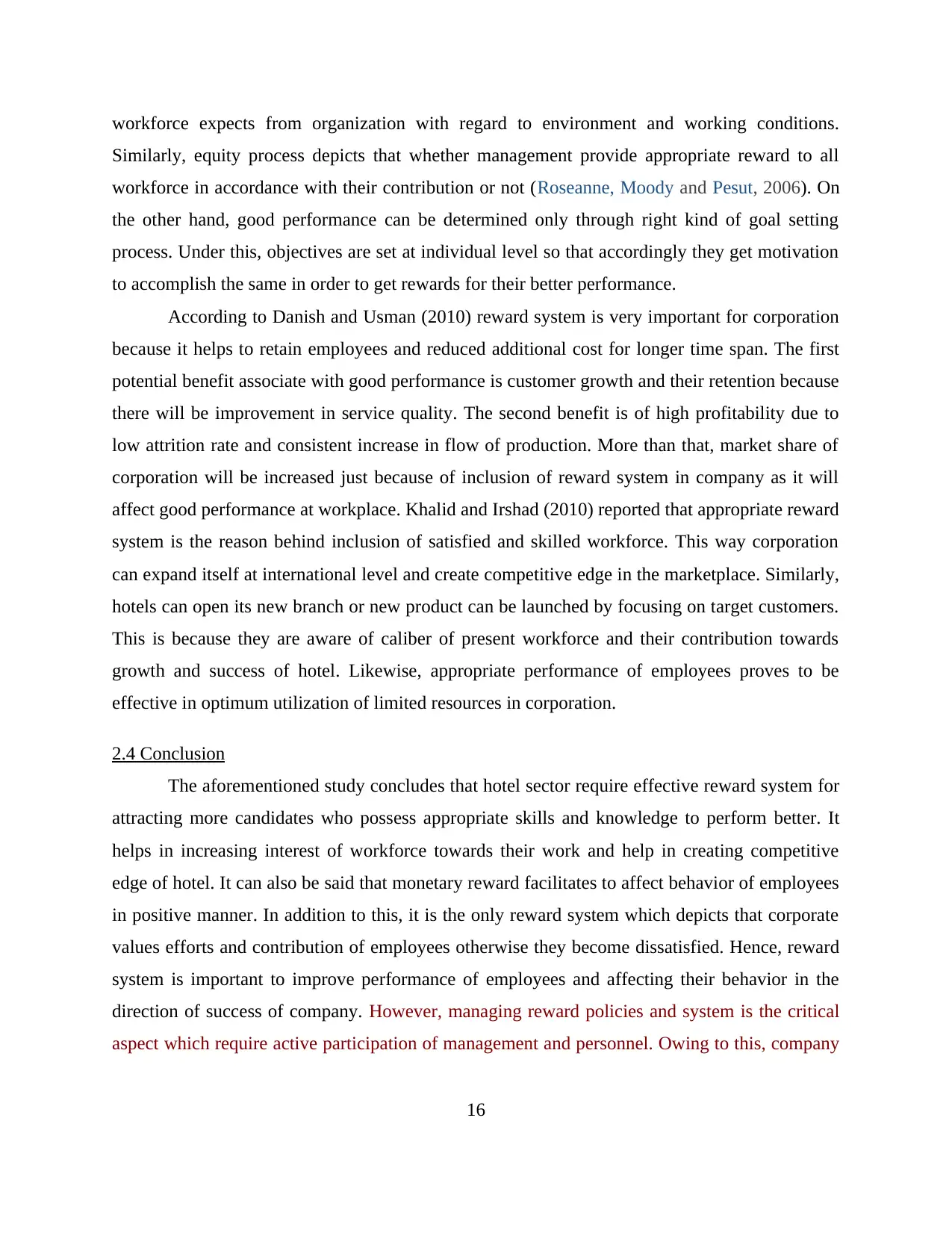
workforce expects from organization with regard to environment and working conditions.
Similarly, equity process depicts that whether management provide appropriate reward to all
workforce in accordance with their contribution or not (Roseanne, Moody and Pesut, 2006). On
the other hand, good performance can be determined only through right kind of goal setting
process. Under this, objectives are set at individual level so that accordingly they get motivation
to accomplish the same in order to get rewards for their better performance.
According to Danish and Usman (2010) reward system is very important for corporation
because it helps to retain employees and reduced additional cost for longer time span. The first
potential benefit associate with good performance is customer growth and their retention because
there will be improvement in service quality. The second benefit is of high profitability due to
low attrition rate and consistent increase in flow of production. More than that, market share of
corporation will be increased just because of inclusion of reward system in company as it will
affect good performance at workplace. Khalid and Irshad (2010) reported that appropriate reward
system is the reason behind inclusion of satisfied and skilled workforce. This way corporation
can expand itself at international level and create competitive edge in the marketplace. Similarly,
hotels can open its new branch or new product can be launched by focusing on target customers.
This is because they are aware of caliber of present workforce and their contribution towards
growth and success of hotel. Likewise, appropriate performance of employees proves to be
effective in optimum utilization of limited resources in corporation.
2.4 Conclusion
The aforementioned study concludes that hotel sector require effective reward system for
attracting more candidates who possess appropriate skills and knowledge to perform better. It
helps in increasing interest of workforce towards their work and help in creating competitive
edge of hotel. It can also be said that monetary reward facilitates to affect behavior of employees
in positive manner. In addition to this, it is the only reward system which depicts that corporate
values efforts and contribution of employees otherwise they become dissatisfied. Hence, reward
system is important to improve performance of employees and affecting their behavior in the
direction of success of company. However, managing reward policies and system is the critical
aspect which require active participation of management and personnel. Owing to this, company
16
Similarly, equity process depicts that whether management provide appropriate reward to all
workforce in accordance with their contribution or not (Roseanne, Moody and Pesut, 2006). On
the other hand, good performance can be determined only through right kind of goal setting
process. Under this, objectives are set at individual level so that accordingly they get motivation
to accomplish the same in order to get rewards for their better performance.
According to Danish and Usman (2010) reward system is very important for corporation
because it helps to retain employees and reduced additional cost for longer time span. The first
potential benefit associate with good performance is customer growth and their retention because
there will be improvement in service quality. The second benefit is of high profitability due to
low attrition rate and consistent increase in flow of production. More than that, market share of
corporation will be increased just because of inclusion of reward system in company as it will
affect good performance at workplace. Khalid and Irshad (2010) reported that appropriate reward
system is the reason behind inclusion of satisfied and skilled workforce. This way corporation
can expand itself at international level and create competitive edge in the marketplace. Similarly,
hotels can open its new branch or new product can be launched by focusing on target customers.
This is because they are aware of caliber of present workforce and their contribution towards
growth and success of hotel. Likewise, appropriate performance of employees proves to be
effective in optimum utilization of limited resources in corporation.
2.4 Conclusion
The aforementioned study concludes that hotel sector require effective reward system for
attracting more candidates who possess appropriate skills and knowledge to perform better. It
helps in increasing interest of workforce towards their work and help in creating competitive
edge of hotel. It can also be said that monetary reward facilitates to affect behavior of employees
in positive manner. In addition to this, it is the only reward system which depicts that corporate
values efforts and contribution of employees otherwise they become dissatisfied. Hence, reward
system is important to improve performance of employees and affecting their behavior in the
direction of success of company. However, managing reward policies and system is the critical
aspect which require active participation of management and personnel. Owing to this, company
16
Secure Best Marks with AI Grader
Need help grading? Try our AI Grader for instant feedback on your assignments.
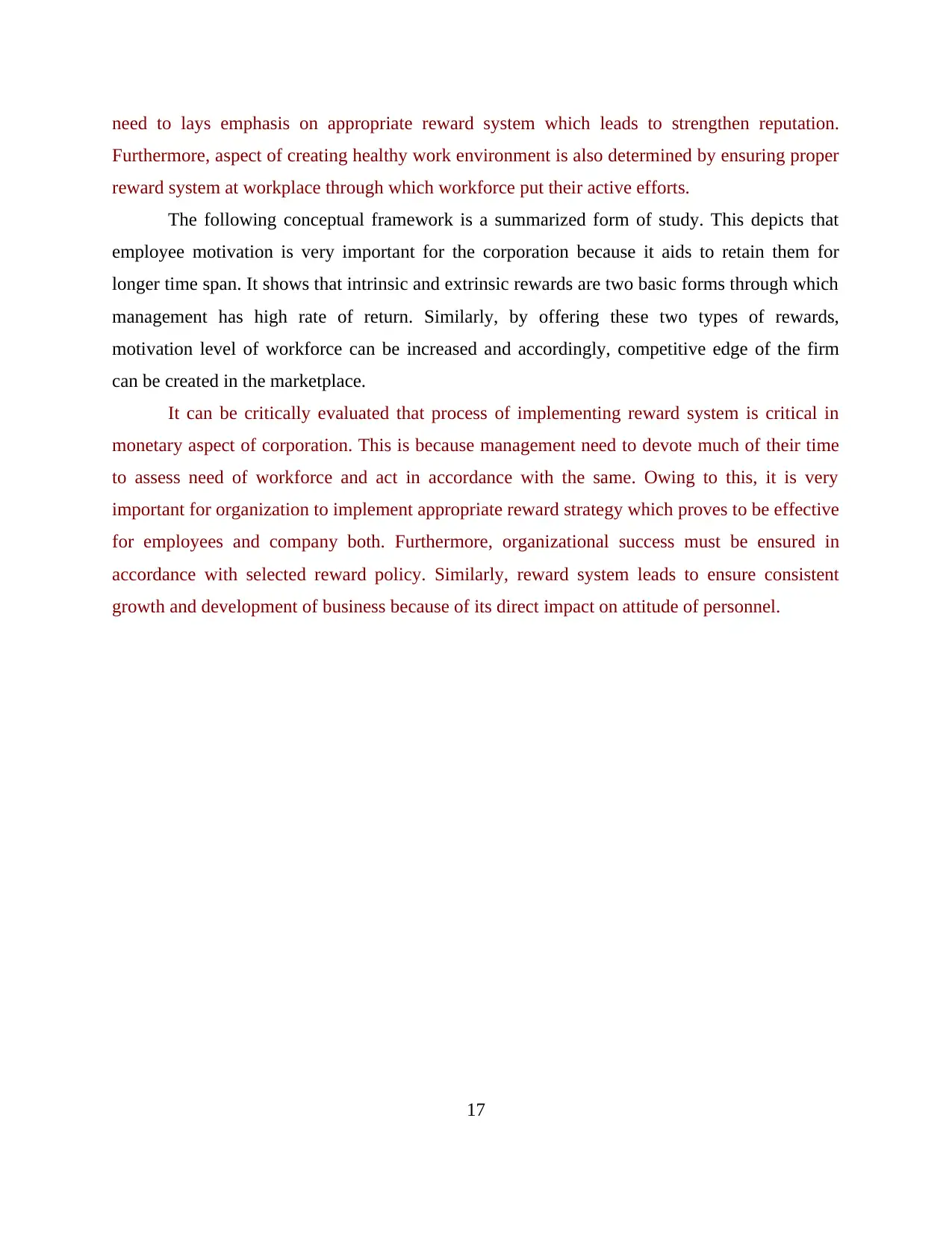
need to lays emphasis on appropriate reward system which leads to strengthen reputation.
Furthermore, aspect of creating healthy work environment is also determined by ensuring proper
reward system at workplace through which workforce put their active efforts.
The following conceptual framework is a summarized form of study. This depicts that
employee motivation is very important for the corporation because it aids to retain them for
longer time span. It shows that intrinsic and extrinsic rewards are two basic forms through which
management has high rate of return. Similarly, by offering these two types of rewards,
motivation level of workforce can be increased and accordingly, competitive edge of the firm
can be created in the marketplace.
It can be critically evaluated that process of implementing reward system is critical in
monetary aspect of corporation. This is because management need to devote much of their time
to assess need of workforce and act in accordance with the same. Owing to this, it is very
important for organization to implement appropriate reward strategy which proves to be effective
for employees and company both. Furthermore, organizational success must be ensured in
accordance with selected reward policy. Similarly, reward system leads to ensure consistent
growth and development of business because of its direct impact on attitude of personnel.
17
Furthermore, aspect of creating healthy work environment is also determined by ensuring proper
reward system at workplace through which workforce put their active efforts.
The following conceptual framework is a summarized form of study. This depicts that
employee motivation is very important for the corporation because it aids to retain them for
longer time span. It shows that intrinsic and extrinsic rewards are two basic forms through which
management has high rate of return. Similarly, by offering these two types of rewards,
motivation level of workforce can be increased and accordingly, competitive edge of the firm
can be created in the marketplace.
It can be critically evaluated that process of implementing reward system is critical in
monetary aspect of corporation. This is because management need to devote much of their time
to assess need of workforce and act in accordance with the same. Owing to this, it is very
important for organization to implement appropriate reward strategy which proves to be effective
for employees and company both. Furthermore, organizational success must be ensured in
accordance with selected reward policy. Similarly, reward system leads to ensure consistent
growth and development of business because of its direct impact on attitude of personnel.
17
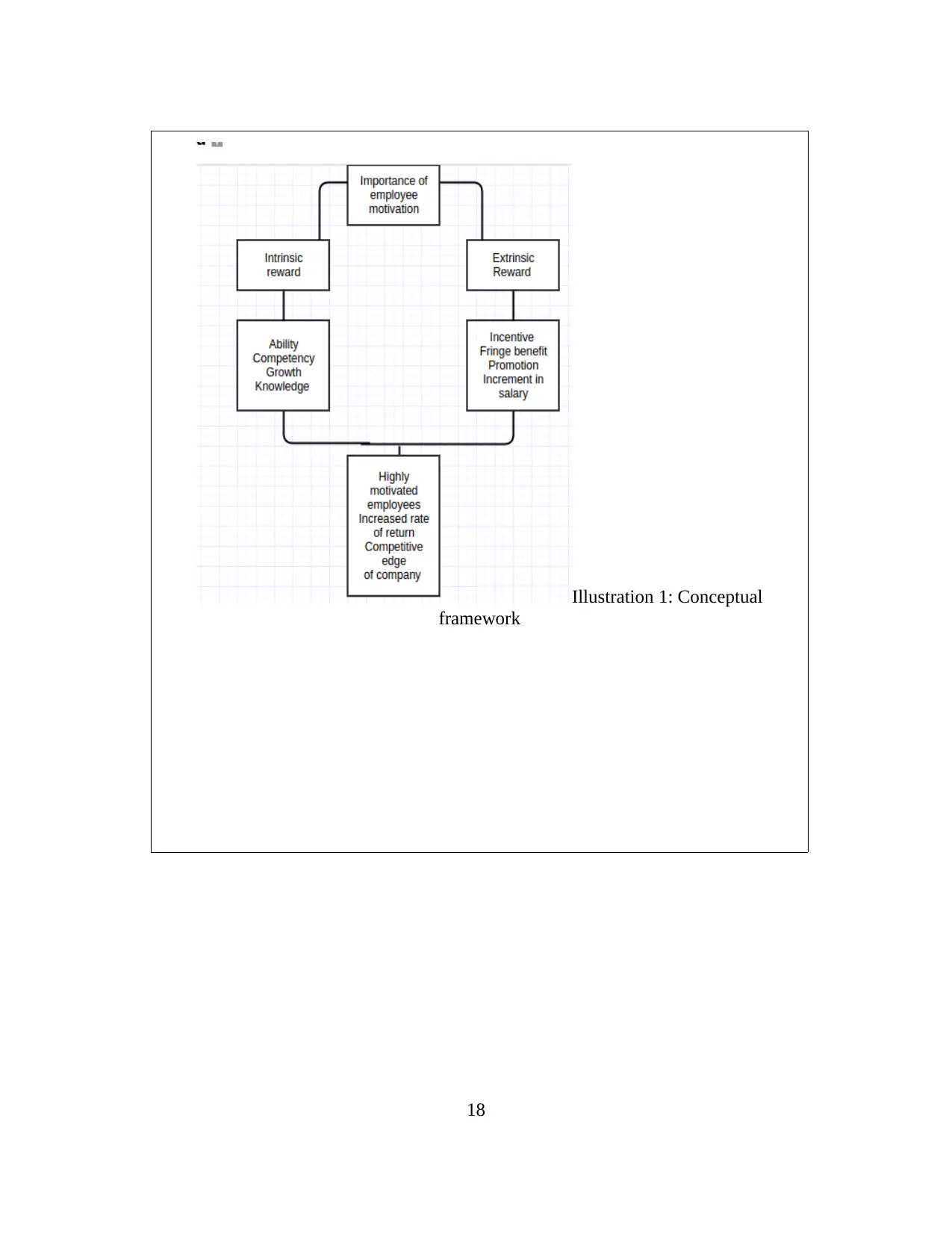
18
Illustration 1: Conceptual
framework
Illustration 1: Conceptual
framework

CHAPTER 3: RESEARCH METHODOLOGY
3.1 Introduction
Research methodology is the third chapter of dissertation that pertain all relevant
information related to methods selected for collection and data analysis. It assists researcher to
present findings of study in right manner and accordingly draw valid conclusion. Current study is
based on quantitative as well as qualitative type of investigation. It facilitates to present the
outcome of study in right manner. Apart from this, methodology part of current study includes
sampling, data collection and analysis methods. Similarly, research approach, philosophy and
analysis methods have been selected. On the other hand, selection of all methods based on
research aim and objectives so that researcher can bring forth valid outcome.
3.2 Research philosophy
Research philosophy is the most important aspect of research methodology. It is based on
certain assumption and set pattern of scholar regarding the research issue. There are different
kind of research philosophies are used such positivism, realism and interpretivism. Present study
uses realism philosophy because researcher posses his own views in analyzing collected data.
Other than this, basic reason behind selecting this approach is involvement of human behaviour
in study (Realism philosophy, 2016). This aspect enables researcher to gather large amount of
data and assess the relationship between reward system and employees' performance of
corporation. By using realism philosophy data will be analyzed with respect to impact of
different kind of rewards on working of employees. This leads to draw valid conclusion and also
enables scholar to provide appropriate suggestions. Thus, selection of realism philosophy is
helpful in completing study effectively (Keightley, 2010).
3.3 Research approach
Research approach refers to certain pattern followed in the study for the purpose of data
collection. Generally every research selects either deductive or inductive approach in accordance
with requirement. Here, the former one begins with generalization so that accordingly researcher
would find the specific issues behind problem under investigation. On the other hand, inductive
approach is initiated with specific level of focus that results in developing new theory or
19
3.1 Introduction
Research methodology is the third chapter of dissertation that pertain all relevant
information related to methods selected for collection and data analysis. It assists researcher to
present findings of study in right manner and accordingly draw valid conclusion. Current study is
based on quantitative as well as qualitative type of investigation. It facilitates to present the
outcome of study in right manner. Apart from this, methodology part of current study includes
sampling, data collection and analysis methods. Similarly, research approach, philosophy and
analysis methods have been selected. On the other hand, selection of all methods based on
research aim and objectives so that researcher can bring forth valid outcome.
3.2 Research philosophy
Research philosophy is the most important aspect of research methodology. It is based on
certain assumption and set pattern of scholar regarding the research issue. There are different
kind of research philosophies are used such positivism, realism and interpretivism. Present study
uses realism philosophy because researcher posses his own views in analyzing collected data.
Other than this, basic reason behind selecting this approach is involvement of human behaviour
in study (Realism philosophy, 2016). This aspect enables researcher to gather large amount of
data and assess the relationship between reward system and employees' performance of
corporation. By using realism philosophy data will be analyzed with respect to impact of
different kind of rewards on working of employees. This leads to draw valid conclusion and also
enables scholar to provide appropriate suggestions. Thus, selection of realism philosophy is
helpful in completing study effectively (Keightley, 2010).
3.3 Research approach
Research approach refers to certain pattern followed in the study for the purpose of data
collection. Generally every research selects either deductive or inductive approach in accordance
with requirement. Here, the former one begins with generalization so that accordingly researcher
would find the specific issues behind problem under investigation. On the other hand, inductive
approach is initiated with specific level of focus that results in developing new theory or
19
Paraphrase This Document
Need a fresh take? Get an instant paraphrase of this document with our AI Paraphraser

exploring existing knowledge (Inductive and Deductive Instruction, 2009). It indicates that,
current study uses inductive approach under which at first data are collected from different
sources. The collected data are then analyzed in order to produce valid outcome for research
issue (Clarke and Fujimura, 2014). However, deductive approach has not been selected because
it is started with generalization and then causes are identified. Owing to this, for current study,
inductive approach is appropriate in order to assess causes and relationship between two
variables such as reward system and employees performance. This aspects enables researcher to
gather appropriate data and analyze the same by using statistical technique (Davies, 2010).
3.7 Sampling design
Sampling is the process of selecting certain number of respondents for collection of data.
However, it is not possible for the researcher to include entire population for the purpose of data
collection. Thus, different sampling techniques are there for selecting population related to study.
Basically two types of sampling techniques are used such as probability and non-probability
sampling. Under the present study non-probability sampling has been used due to selection of
employees of Marriott hotel (Danping and Lee, 2011). Here, the purpose of study is known and
researcher wants to get specific information from selected population. For this purpose,
purposive sampling has been used wherein targeted population play vital role in providing
relevant information related to reward system of Marriott hotel. Here, sample size is kept 100 so
that respondents can provide enough information related to reward system and its connection
with performance of workforce can be assessed in right manner. However, selected population
has detail knowledge related to reward system of corporation and accordingly their performance
was observed by management also. This is the reason for selecting 100 employees of Marriott for
collection of data (Anderson and et. al., 2011).
3.4 Research design and strategy
There are different research design such as descriptive, case study and exploratory. Along
with that, exploratory study is also included. For the current study research will focus on
descriptive research design their specific features of population are laid down. It enables scholars
to describe the characteristics of respondents who are directly related to study. Furthermore,
descriptive research design is one under which scholar come to know about its target population
20
current study uses inductive approach under which at first data are collected from different
sources. The collected data are then analyzed in order to produce valid outcome for research
issue (Clarke and Fujimura, 2014). However, deductive approach has not been selected because
it is started with generalization and then causes are identified. Owing to this, for current study,
inductive approach is appropriate in order to assess causes and relationship between two
variables such as reward system and employees performance. This aspects enables researcher to
gather appropriate data and analyze the same by using statistical technique (Davies, 2010).
3.7 Sampling design
Sampling is the process of selecting certain number of respondents for collection of data.
However, it is not possible for the researcher to include entire population for the purpose of data
collection. Thus, different sampling techniques are there for selecting population related to study.
Basically two types of sampling techniques are used such as probability and non-probability
sampling. Under the present study non-probability sampling has been used due to selection of
employees of Marriott hotel (Danping and Lee, 2011). Here, the purpose of study is known and
researcher wants to get specific information from selected population. For this purpose,
purposive sampling has been used wherein targeted population play vital role in providing
relevant information related to reward system of Marriott hotel. Here, sample size is kept 100 so
that respondents can provide enough information related to reward system and its connection
with performance of workforce can be assessed in right manner. However, selected population
has detail knowledge related to reward system of corporation and accordingly their performance
was observed by management also. This is the reason for selecting 100 employees of Marriott for
collection of data (Anderson and et. al., 2011).
3.4 Research design and strategy
There are different research design such as descriptive, case study and exploratory. Along
with that, exploratory study is also included. For the current study research will focus on
descriptive research design their specific features of population are laid down. It enables scholars
to describe the characteristics of respondents who are directly related to study. Furthermore,
descriptive research design is one under which scholar come to know about its target population
20
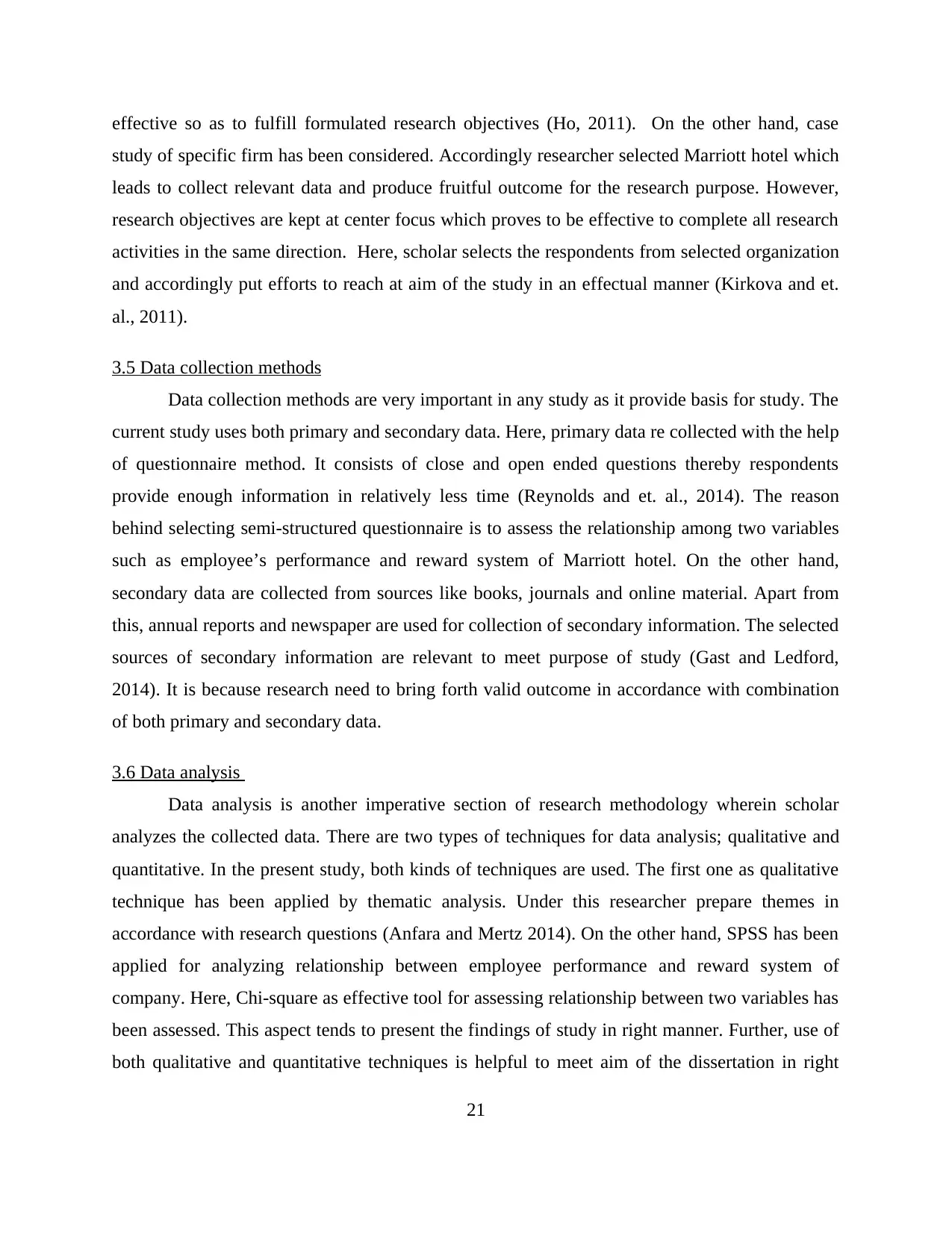
effective so as to fulfill formulated research objectives (Ho, 2011). On the other hand, case
study of specific firm has been considered. Accordingly researcher selected Marriott hotel which
leads to collect relevant data and produce fruitful outcome for the research purpose. However,
research objectives are kept at center focus which proves to be effective to complete all research
activities in the same direction. Here, scholar selects the respondents from selected organization
and accordingly put efforts to reach at aim of the study in an effectual manner (Kirkova and et.
al., 2011).
3.5 Data collection methods
Data collection methods are very important in any study as it provide basis for study. The
current study uses both primary and secondary data. Here, primary data re collected with the help
of questionnaire method. It consists of close and open ended questions thereby respondents
provide enough information in relatively less time (Reynolds and et. al., 2014). The reason
behind selecting semi-structured questionnaire is to assess the relationship among two variables
such as employee’s performance and reward system of Marriott hotel. On the other hand,
secondary data are collected from sources like books, journals and online material. Apart from
this, annual reports and newspaper are used for collection of secondary information. The selected
sources of secondary information are relevant to meet purpose of study (Gast and Ledford,
2014). It is because research need to bring forth valid outcome in accordance with combination
of both primary and secondary data.
3.6 Data analysis
Data analysis is another imperative section of research methodology wherein scholar
analyzes the collected data. There are two types of techniques for data analysis; qualitative and
quantitative. In the present study, both kinds of techniques are used. The first one as qualitative
technique has been applied by thematic analysis. Under this researcher prepare themes in
accordance with research questions (Anfara and Mertz 2014). On the other hand, SPSS has been
applied for analyzing relationship between employee performance and reward system of
company. Here, Chi-square as effective tool for assessing relationship between two variables has
been assessed. This aspect tends to present the findings of study in right manner. Further, use of
both qualitative and quantitative techniques is helpful to meet aim of the dissertation in right
21
study of specific firm has been considered. Accordingly researcher selected Marriott hotel which
leads to collect relevant data and produce fruitful outcome for the research purpose. However,
research objectives are kept at center focus which proves to be effective to complete all research
activities in the same direction. Here, scholar selects the respondents from selected organization
and accordingly put efforts to reach at aim of the study in an effectual manner (Kirkova and et.
al., 2011).
3.5 Data collection methods
Data collection methods are very important in any study as it provide basis for study. The
current study uses both primary and secondary data. Here, primary data re collected with the help
of questionnaire method. It consists of close and open ended questions thereby respondents
provide enough information in relatively less time (Reynolds and et. al., 2014). The reason
behind selecting semi-structured questionnaire is to assess the relationship among two variables
such as employee’s performance and reward system of Marriott hotel. On the other hand,
secondary data are collected from sources like books, journals and online material. Apart from
this, annual reports and newspaper are used for collection of secondary information. The selected
sources of secondary information are relevant to meet purpose of study (Gast and Ledford,
2014). It is because research need to bring forth valid outcome in accordance with combination
of both primary and secondary data.
3.6 Data analysis
Data analysis is another imperative section of research methodology wherein scholar
analyzes the collected data. There are two types of techniques for data analysis; qualitative and
quantitative. In the present study, both kinds of techniques are used. The first one as qualitative
technique has been applied by thematic analysis. Under this researcher prepare themes in
accordance with research questions (Anfara and Mertz 2014). On the other hand, SPSS has been
applied for analyzing relationship between employee performance and reward system of
company. Here, Chi-square as effective tool for assessing relationship between two variables has
been assessed. This aspect tends to present the findings of study in right manner. Further, use of
both qualitative and quantitative techniques is helpful to meet aim of the dissertation in right
21
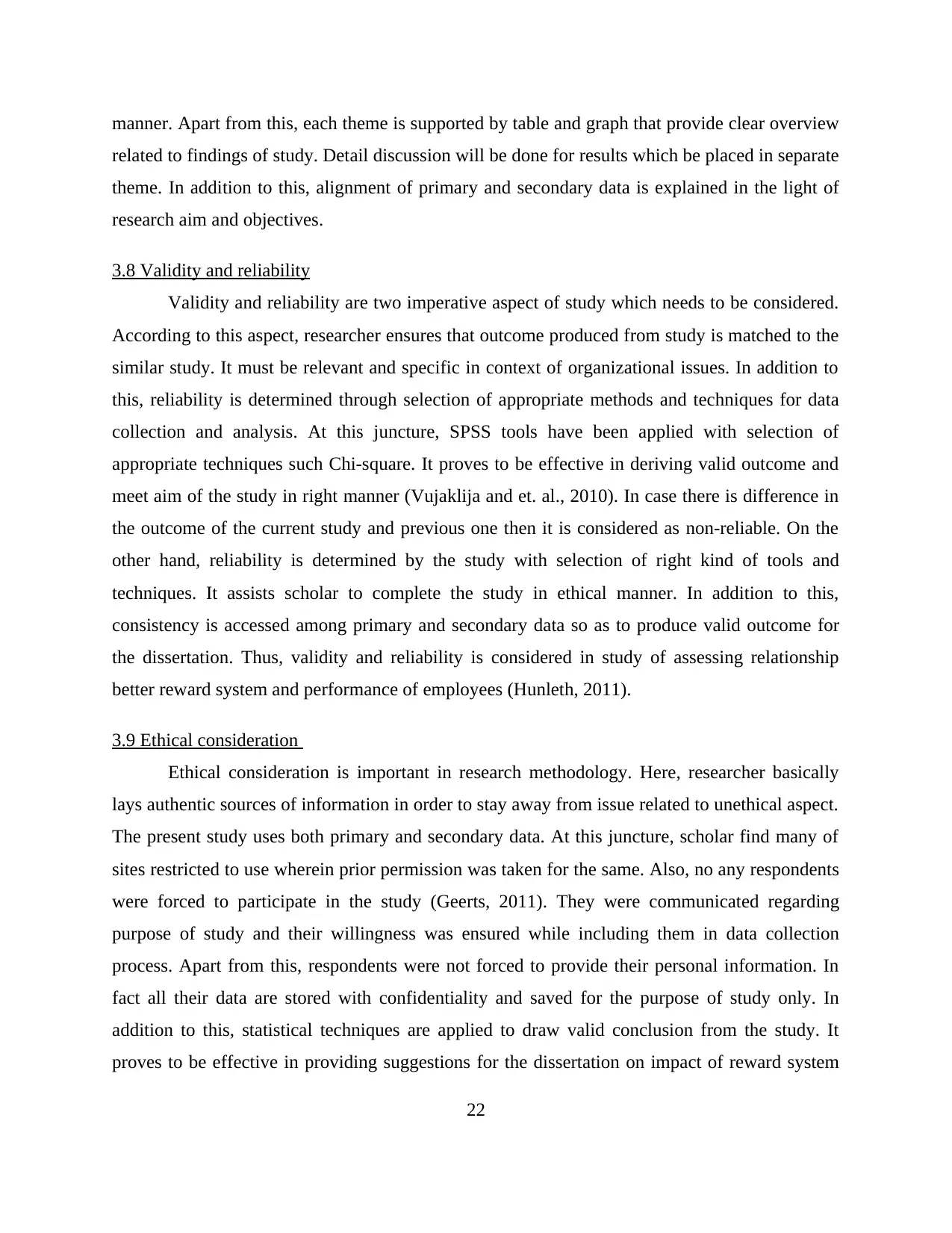
manner. Apart from this, each theme is supported by table and graph that provide clear overview
related to findings of study. Detail discussion will be done for results which be placed in separate
theme. In addition to this, alignment of primary and secondary data is explained in the light of
research aim and objectives.
3.8 Validity and reliability
Validity and reliability are two imperative aspect of study which needs to be considered.
According to this aspect, researcher ensures that outcome produced from study is matched to the
similar study. It must be relevant and specific in context of organizational issues. In addition to
this, reliability is determined through selection of appropriate methods and techniques for data
collection and analysis. At this juncture, SPSS tools have been applied with selection of
appropriate techniques such Chi-square. It proves to be effective in deriving valid outcome and
meet aim of the study in right manner (Vujaklija and et. al., 2010). In case there is difference in
the outcome of the current study and previous one then it is considered as non-reliable. On the
other hand, reliability is determined by the study with selection of right kind of tools and
techniques. It assists scholar to complete the study in ethical manner. In addition to this,
consistency is accessed among primary and secondary data so as to produce valid outcome for
the dissertation. Thus, validity and reliability is considered in study of assessing relationship
better reward system and performance of employees (Hunleth, 2011).
3.9 Ethical consideration
Ethical consideration is important in research methodology. Here, researcher basically
lays authentic sources of information in order to stay away from issue related to unethical aspect.
The present study uses both primary and secondary data. At this juncture, scholar find many of
sites restricted to use wherein prior permission was taken for the same. Also, no any respondents
were forced to participate in the study (Geerts, 2011). They were communicated regarding
purpose of study and their willingness was ensured while including them in data collection
process. Apart from this, respondents were not forced to provide their personal information. In
fact all their data are stored with confidentiality and saved for the purpose of study only. In
addition to this, statistical techniques are applied to draw valid conclusion from the study. It
proves to be effective in providing suggestions for the dissertation on impact of reward system
22
related to findings of study. Detail discussion will be done for results which be placed in separate
theme. In addition to this, alignment of primary and secondary data is explained in the light of
research aim and objectives.
3.8 Validity and reliability
Validity and reliability are two imperative aspect of study which needs to be considered.
According to this aspect, researcher ensures that outcome produced from study is matched to the
similar study. It must be relevant and specific in context of organizational issues. In addition to
this, reliability is determined through selection of appropriate methods and techniques for data
collection and analysis. At this juncture, SPSS tools have been applied with selection of
appropriate techniques such Chi-square. It proves to be effective in deriving valid outcome and
meet aim of the study in right manner (Vujaklija and et. al., 2010). In case there is difference in
the outcome of the current study and previous one then it is considered as non-reliable. On the
other hand, reliability is determined by the study with selection of right kind of tools and
techniques. It assists scholar to complete the study in ethical manner. In addition to this,
consistency is accessed among primary and secondary data so as to produce valid outcome for
the dissertation. Thus, validity and reliability is considered in study of assessing relationship
better reward system and performance of employees (Hunleth, 2011).
3.9 Ethical consideration
Ethical consideration is important in research methodology. Here, researcher basically
lays authentic sources of information in order to stay away from issue related to unethical aspect.
The present study uses both primary and secondary data. At this juncture, scholar find many of
sites restricted to use wherein prior permission was taken for the same. Also, no any respondents
were forced to participate in the study (Geerts, 2011). They were communicated regarding
purpose of study and their willingness was ensured while including them in data collection
process. Apart from this, respondents were not forced to provide their personal information. In
fact all their data are stored with confidentiality and saved for the purpose of study only. In
addition to this, statistical techniques are applied to draw valid conclusion from the study. It
proves to be effective in providing suggestions for the dissertation on impact of reward system
22
Secure Best Marks with AI Grader
Need help grading? Try our AI Grader for instant feedback on your assignments.
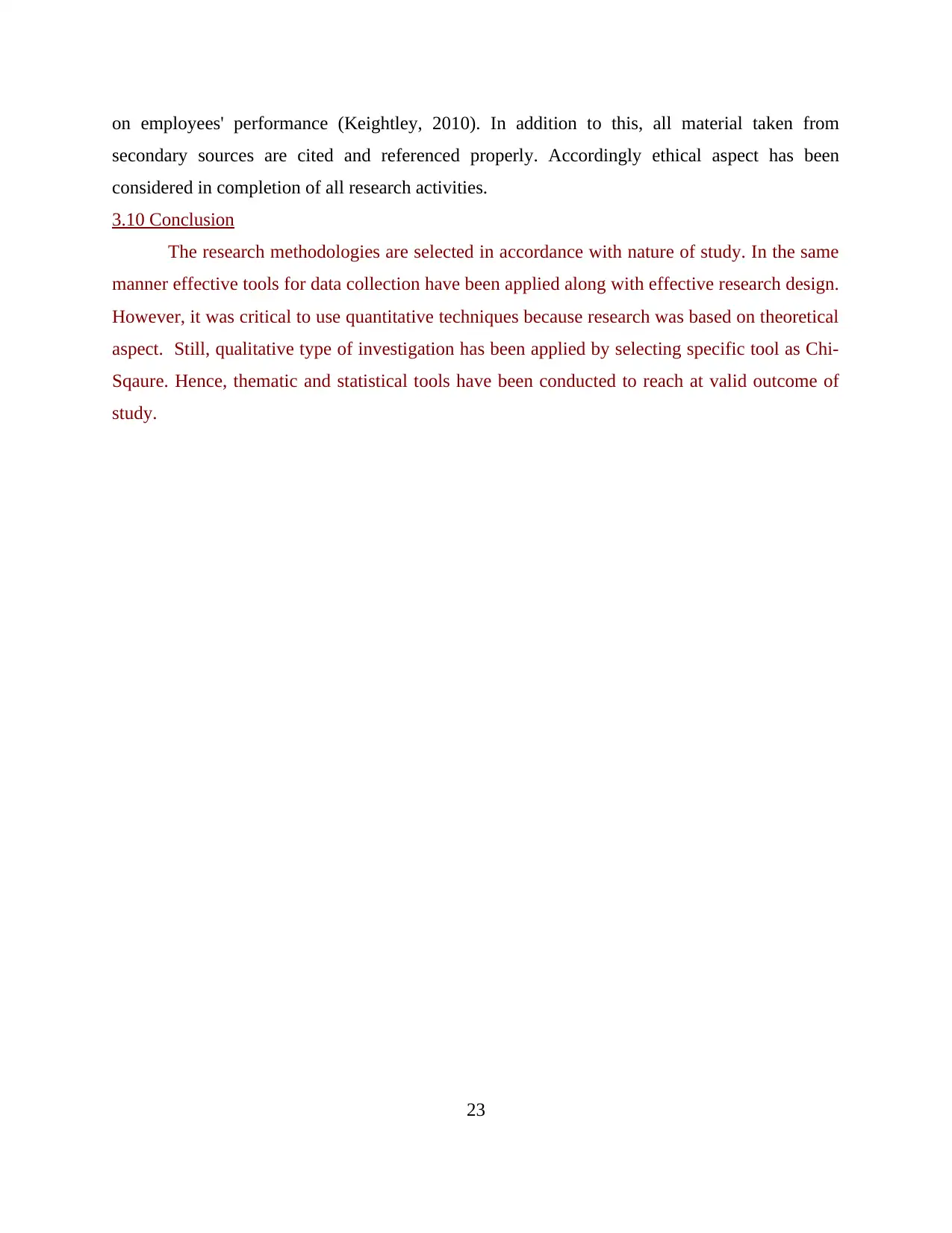
on employees' performance (Keightley, 2010). In addition to this, all material taken from
secondary sources are cited and referenced properly. Accordingly ethical aspect has been
considered in completion of all research activities.
3.10 Conclusion
The research methodologies are selected in accordance with nature of study. In the same
manner effective tools for data collection have been applied along with effective research design.
However, it was critical to use quantitative techniques because research was based on theoretical
aspect. Still, qualitative type of investigation has been applied by selecting specific tool as Chi-
Sqaure. Hence, thematic and statistical tools have been conducted to reach at valid outcome of
study.
23
secondary sources are cited and referenced properly. Accordingly ethical aspect has been
considered in completion of all research activities.
3.10 Conclusion
The research methodologies are selected in accordance with nature of study. In the same
manner effective tools for data collection have been applied along with effective research design.
However, it was critical to use quantitative techniques because research was based on theoretical
aspect. Still, qualitative type of investigation has been applied by selecting specific tool as Chi-
Sqaure. Hence, thematic and statistical tools have been conducted to reach at valid outcome of
study.
23

CHAPTER 4: DATA ANALYSIS
4.1 Introduction
Data analysis is the most important chapter of dissertation which consists detail analysis
of collected data. It enables researcher to present the findings of collected data in an appropriate
manner so as to draw valid conclusion. The data analysis chapter is done in accordance with
selected themes which are prepared on the basis of research objectives. The current dissertation
on impact of reward system on employees performance has been conducted by using thematic
analysis and Chi-square. Similarly, hypothesis have been framed in questions where Chi-Square
has been applied. This tends to achieve aim or objectives of report which leads to provide clear
evidence to readers. It facilitates researcher to conclude the collected information in the light of
research aim and objectives. This proves to be effective in developing valid conclusion for
meeting aim of the study. In addition to this, analysis of current study has been done as follows-
4.2 Analysis of data
Data analysis process is begun as follows-
Theme 1: Benefits of reward system
High rate of return 40.00%
Increased customer base 30.00%
Competitive edge 30.00%
24
40.00%
30.00%
30.00%
High rate of return
Increased customer
base
Competitive edge
4.1 Introduction
Data analysis is the most important chapter of dissertation which consists detail analysis
of collected data. It enables researcher to present the findings of collected data in an appropriate
manner so as to draw valid conclusion. The data analysis chapter is done in accordance with
selected themes which are prepared on the basis of research objectives. The current dissertation
on impact of reward system on employees performance has been conducted by using thematic
analysis and Chi-square. Similarly, hypothesis have been framed in questions where Chi-Square
has been applied. This tends to achieve aim or objectives of report which leads to provide clear
evidence to readers. It facilitates researcher to conclude the collected information in the light of
research aim and objectives. This proves to be effective in developing valid conclusion for
meeting aim of the study. In addition to this, analysis of current study has been done as follows-
4.2 Analysis of data
Data analysis process is begun as follows-
Theme 1: Benefits of reward system
High rate of return 40.00%
Increased customer base 30.00%
Competitive edge 30.00%
24
40.00%
30.00%
30.00%
High rate of return
Increased customer
base
Competitive edge
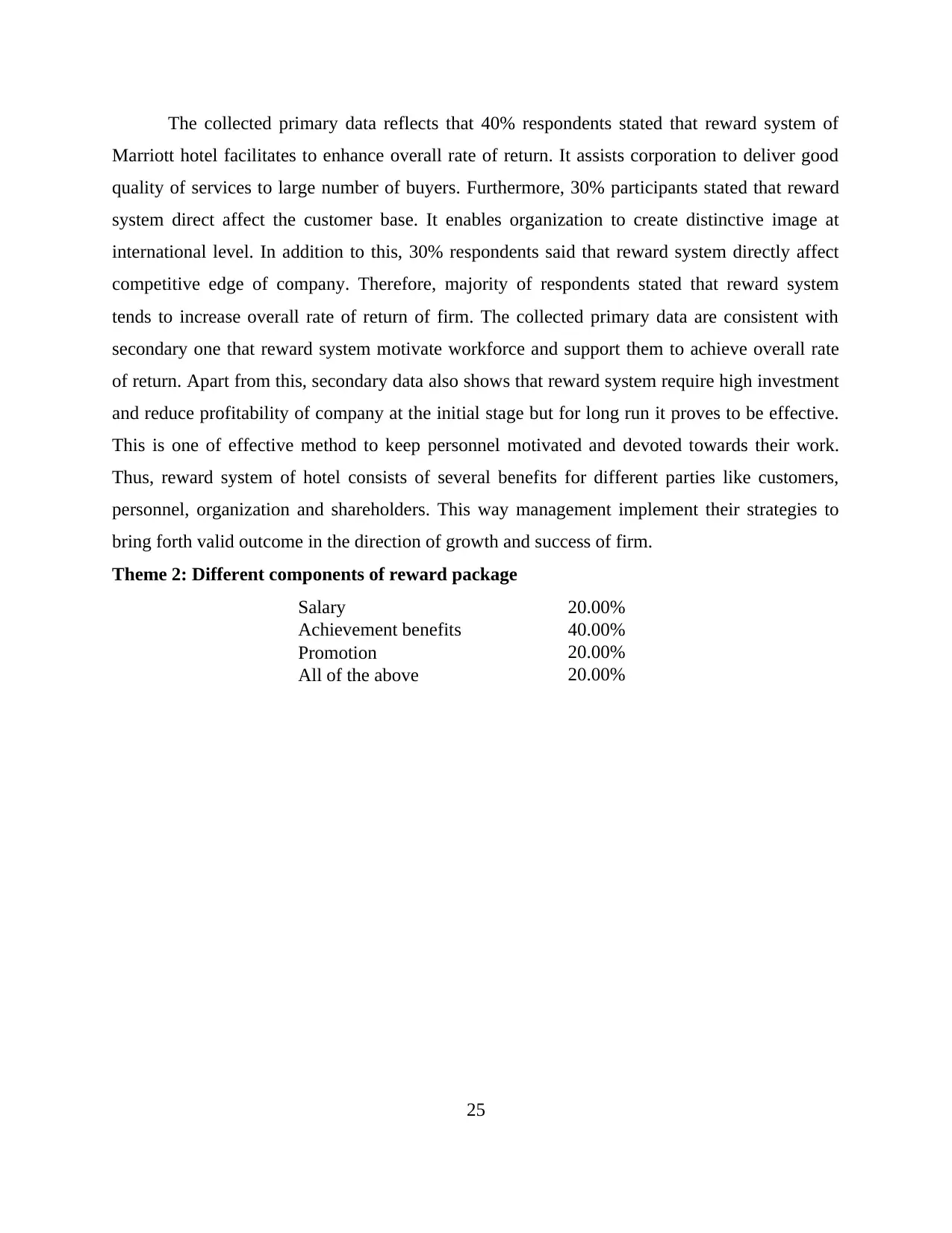
The collected primary data reflects that 40% respondents stated that reward system of
Marriott hotel facilitates to enhance overall rate of return. It assists corporation to deliver good
quality of services to large number of buyers. Furthermore, 30% participants stated that reward
system direct affect the customer base. It enables organization to create distinctive image at
international level. In addition to this, 30% respondents said that reward system directly affect
competitive edge of company. Therefore, majority of respondents stated that reward system
tends to increase overall rate of return of firm. The collected primary data are consistent with
secondary one that reward system motivate workforce and support them to achieve overall rate
of return. Apart from this, secondary data also shows that reward system require high investment
and reduce profitability of company at the initial stage but for long run it proves to be effective.
This is one of effective method to keep personnel motivated and devoted towards their work.
Thus, reward system of hotel consists of several benefits for different parties like customers,
personnel, organization and shareholders. This way management implement their strategies to
bring forth valid outcome in the direction of growth and success of firm.
Theme 2: Different components of reward package
Salary 20.00%
Achievement benefits 40.00%
Promotion 20.00%
All of the above 20.00%
25
Marriott hotel facilitates to enhance overall rate of return. It assists corporation to deliver good
quality of services to large number of buyers. Furthermore, 30% participants stated that reward
system direct affect the customer base. It enables organization to create distinctive image at
international level. In addition to this, 30% respondents said that reward system directly affect
competitive edge of company. Therefore, majority of respondents stated that reward system
tends to increase overall rate of return of firm. The collected primary data are consistent with
secondary one that reward system motivate workforce and support them to achieve overall rate
of return. Apart from this, secondary data also shows that reward system require high investment
and reduce profitability of company at the initial stage but for long run it proves to be effective.
This is one of effective method to keep personnel motivated and devoted towards their work.
Thus, reward system of hotel consists of several benefits for different parties like customers,
personnel, organization and shareholders. This way management implement their strategies to
bring forth valid outcome in the direction of growth and success of firm.
Theme 2: Different components of reward package
Salary 20.00%
Achievement benefits 40.00%
Promotion 20.00%
All of the above 20.00%
25
Paraphrase This Document
Need a fresh take? Get an instant paraphrase of this document with our AI Paraphraser
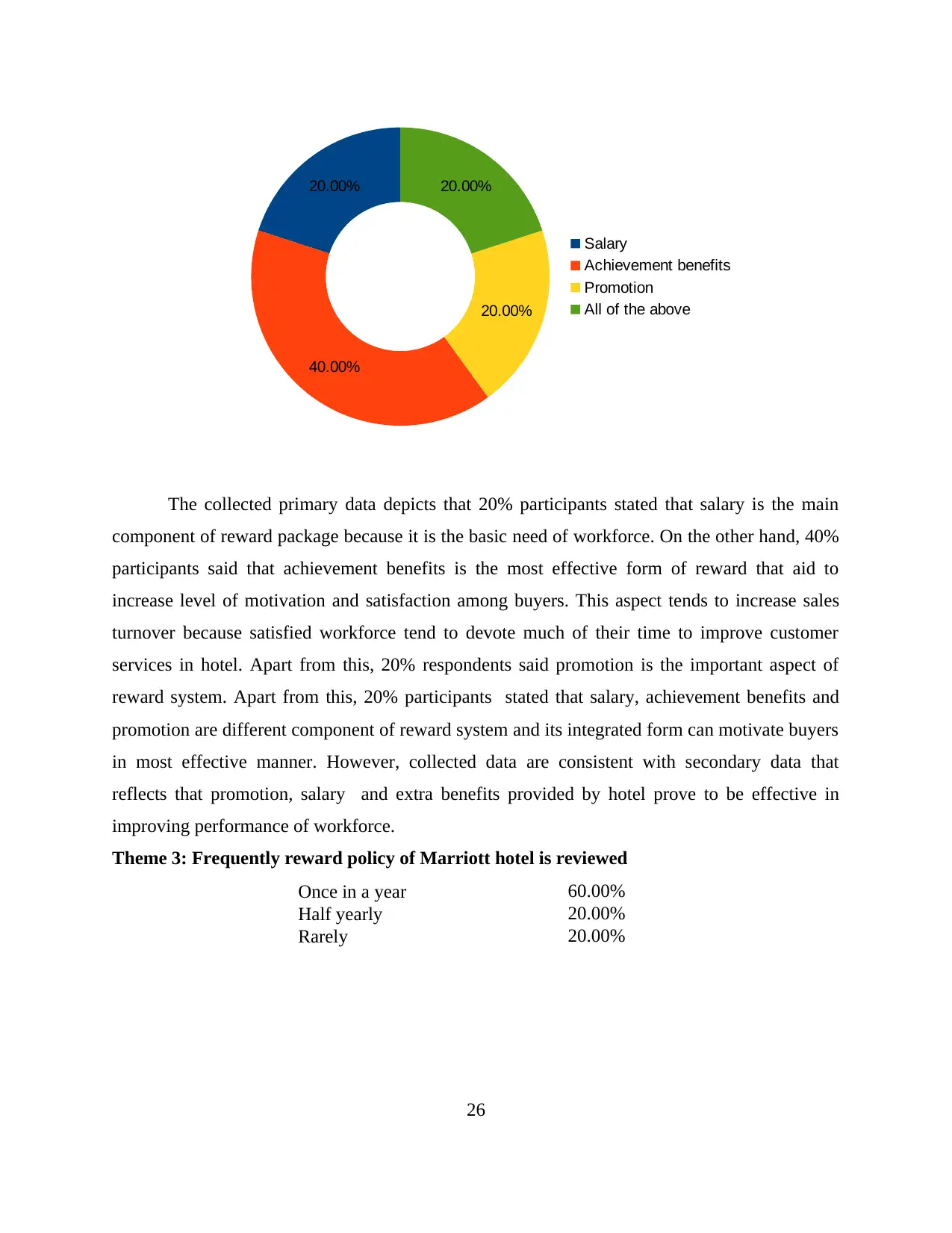
The collected primary data depicts that 20% participants stated that salary is the main
component of reward package because it is the basic need of workforce. On the other hand, 40%
participants said that achievement benefits is the most effective form of reward that aid to
increase level of motivation and satisfaction among buyers. This aspect tends to increase sales
turnover because satisfied workforce tend to devote much of their time to improve customer
services in hotel. Apart from this, 20% respondents said promotion is the important aspect of
reward system. Apart from this, 20% participants stated that salary, achievement benefits and
promotion are different component of reward system and its integrated form can motivate buyers
in most effective manner. However, collected data are consistent with secondary data that
reflects that promotion, salary and extra benefits provided by hotel prove to be effective in
improving performance of workforce.
Theme 3: Frequently reward policy of Marriott hotel is reviewed
Once in a year 60.00%
Half yearly 20.00%
Rarely 20.00%
26
20.00%
40.00%
20.00%
20.00%
Salary
Achievement benefits
Promotion
All of the above
component of reward package because it is the basic need of workforce. On the other hand, 40%
participants said that achievement benefits is the most effective form of reward that aid to
increase level of motivation and satisfaction among buyers. This aspect tends to increase sales
turnover because satisfied workforce tend to devote much of their time to improve customer
services in hotel. Apart from this, 20% respondents said promotion is the important aspect of
reward system. Apart from this, 20% participants stated that salary, achievement benefits and
promotion are different component of reward system and its integrated form can motivate buyers
in most effective manner. However, collected data are consistent with secondary data that
reflects that promotion, salary and extra benefits provided by hotel prove to be effective in
improving performance of workforce.
Theme 3: Frequently reward policy of Marriott hotel is reviewed
Once in a year 60.00%
Half yearly 20.00%
Rarely 20.00%
26
20.00%
40.00%
20.00%
20.00%
Salary
Achievement benefits
Promotion
All of the above
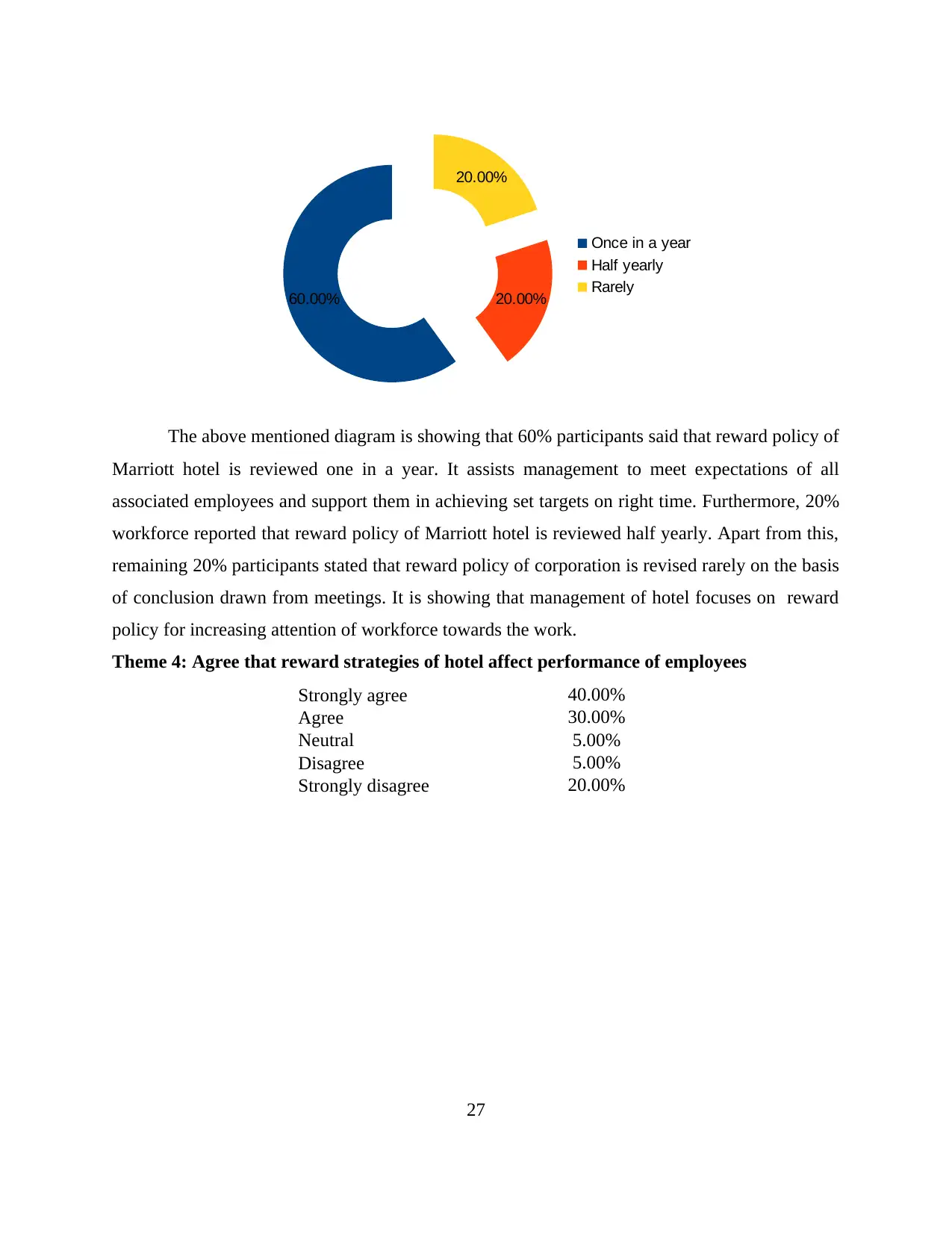
The above mentioned diagram is showing that 60% participants said that reward policy of
Marriott hotel is reviewed one in a year. It assists management to meet expectations of all
associated employees and support them in achieving set targets on right time. Furthermore, 20%
workforce reported that reward policy of Marriott hotel is reviewed half yearly. Apart from this,
remaining 20% participants stated that reward policy of corporation is revised rarely on the basis
of conclusion drawn from meetings. It is showing that management of hotel focuses on reward
policy for increasing attention of workforce towards the work.
Theme 4: Agree that reward strategies of hotel affect performance of employees
Strongly agree 40.00%
Agree 30.00%
Neutral 5.00%
Disagree 5.00%
Strongly disagree 20.00%
27
60.00% 20.00%
20.00%
Once in a year
Half yearly
Rarely
Marriott hotel is reviewed one in a year. It assists management to meet expectations of all
associated employees and support them in achieving set targets on right time. Furthermore, 20%
workforce reported that reward policy of Marriott hotel is reviewed half yearly. Apart from this,
remaining 20% participants stated that reward policy of corporation is revised rarely on the basis
of conclusion drawn from meetings. It is showing that management of hotel focuses on reward
policy for increasing attention of workforce towards the work.
Theme 4: Agree that reward strategies of hotel affect performance of employees
Strongly agree 40.00%
Agree 30.00%
Neutral 5.00%
Disagree 5.00%
Strongly disagree 20.00%
27
60.00% 20.00%
20.00%
Once in a year
Half yearly
Rarely
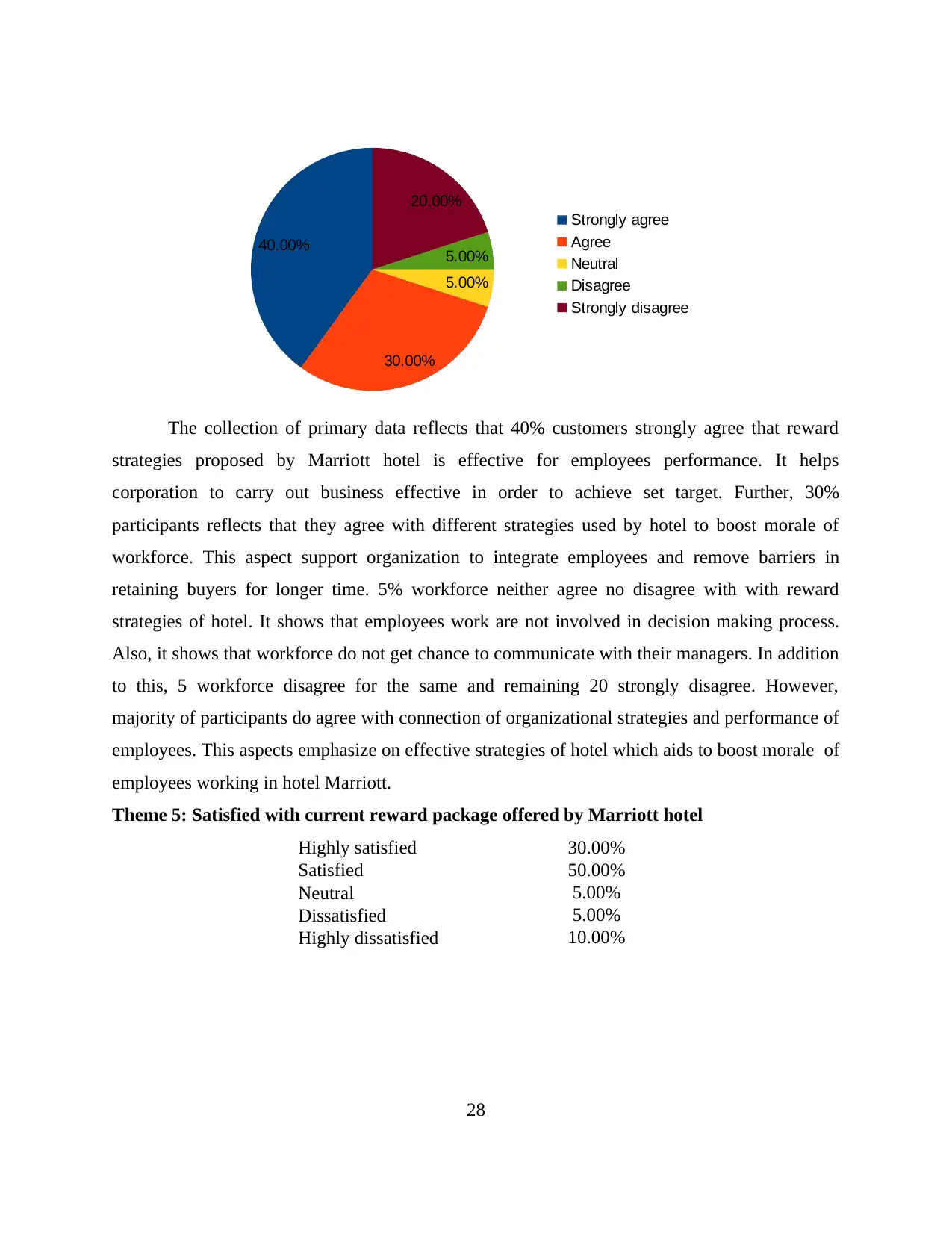
The collection of primary data reflects that 40% customers strongly agree that reward
strategies proposed by Marriott hotel is effective for employees performance. It helps
corporation to carry out business effective in order to achieve set target. Further, 30%
participants reflects that they agree with different strategies used by hotel to boost morale of
workforce. This aspect support organization to integrate employees and remove barriers in
retaining buyers for longer time. 5% workforce neither agree no disagree with with reward
strategies of hotel. It shows that employees work are not involved in decision making process.
Also, it shows that workforce do not get chance to communicate with their managers. In addition
to this, 5 workforce disagree for the same and remaining 20 strongly disagree. However,
majority of participants do agree with connection of organizational strategies and performance of
employees. This aspects emphasize on effective strategies of hotel which aids to boost morale of
employees working in hotel Marriott.
Theme 5: Satisfied with current reward package offered by Marriott hotel
Highly satisfied 30.00%
Satisfied 50.00%
Neutral 5.00%
Dissatisfied 5.00%
Highly dissatisfied 10.00%
28
40.00%
30.00%
5.00%
5.00%
20.00%
Strongly agree
Agree
Neutral
Disagree
Strongly disagree
strategies proposed by Marriott hotel is effective for employees performance. It helps
corporation to carry out business effective in order to achieve set target. Further, 30%
participants reflects that they agree with different strategies used by hotel to boost morale of
workforce. This aspect support organization to integrate employees and remove barriers in
retaining buyers for longer time. 5% workforce neither agree no disagree with with reward
strategies of hotel. It shows that employees work are not involved in decision making process.
Also, it shows that workforce do not get chance to communicate with their managers. In addition
to this, 5 workforce disagree for the same and remaining 20 strongly disagree. However,
majority of participants do agree with connection of organizational strategies and performance of
employees. This aspects emphasize on effective strategies of hotel which aids to boost morale of
employees working in hotel Marriott.
Theme 5: Satisfied with current reward package offered by Marriott hotel
Highly satisfied 30.00%
Satisfied 50.00%
Neutral 5.00%
Dissatisfied 5.00%
Highly dissatisfied 10.00%
28
40.00%
30.00%
5.00%
5.00%
20.00%
Strongly agree
Agree
Neutral
Disagree
Strongly disagree
Secure Best Marks with AI Grader
Need help grading? Try our AI Grader for instant feedback on your assignments.
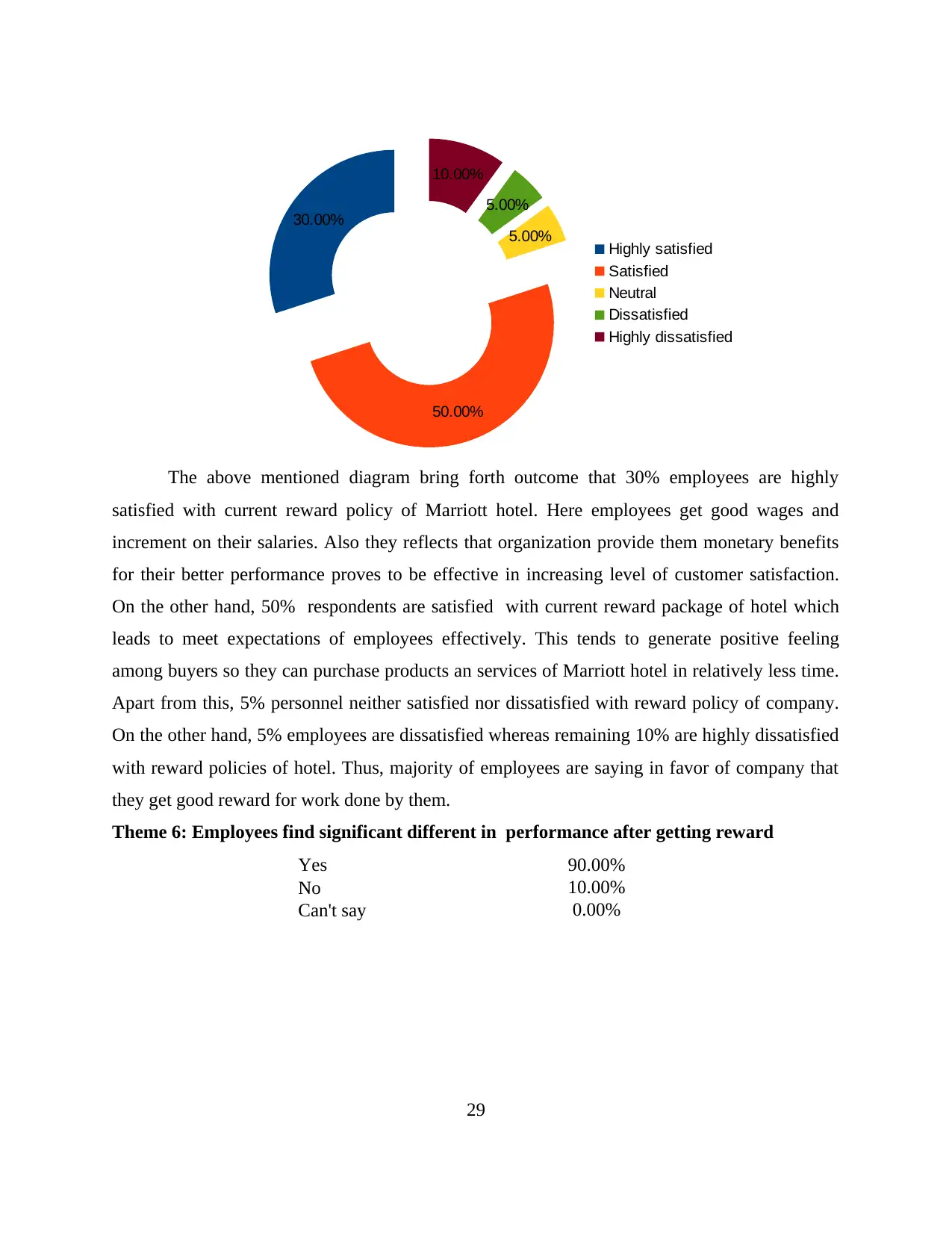
The above mentioned diagram bring forth outcome that 30% employees are highly
satisfied with current reward policy of Marriott hotel. Here employees get good wages and
increment on their salaries. Also they reflects that organization provide them monetary benefits
for their better performance proves to be effective in increasing level of customer satisfaction.
On the other hand, 50% respondents are satisfied with current reward package of hotel which
leads to meet expectations of employees effectively. This tends to generate positive feeling
among buyers so they can purchase products an services of Marriott hotel in relatively less time.
Apart from this, 5% personnel neither satisfied nor dissatisfied with reward policy of company.
On the other hand, 5% employees are dissatisfied whereas remaining 10% are highly dissatisfied
with reward policies of hotel. Thus, majority of employees are saying in favor of company that
they get good reward for work done by them.
Theme 6: Employees find significant different in performance after getting reward
Yes 90.00%
No 10.00%
Can't say 0.00%
29
30.00%
50.00%
5.00%
5.00%
10.00%
Highly satisfied
Satisfied
Neutral
Dissatisfied
Highly dissatisfied
satisfied with current reward policy of Marriott hotel. Here employees get good wages and
increment on their salaries. Also they reflects that organization provide them monetary benefits
for their better performance proves to be effective in increasing level of customer satisfaction.
On the other hand, 50% respondents are satisfied with current reward package of hotel which
leads to meet expectations of employees effectively. This tends to generate positive feeling
among buyers so they can purchase products an services of Marriott hotel in relatively less time.
Apart from this, 5% personnel neither satisfied nor dissatisfied with reward policy of company.
On the other hand, 5% employees are dissatisfied whereas remaining 10% are highly dissatisfied
with reward policies of hotel. Thus, majority of employees are saying in favor of company that
they get good reward for work done by them.
Theme 6: Employees find significant different in performance after getting reward
Yes 90.00%
No 10.00%
Can't say 0.00%
29
30.00%
50.00%
5.00%
5.00%
10.00%
Highly satisfied
Satisfied
Neutral
Dissatisfied
Highly dissatisfied
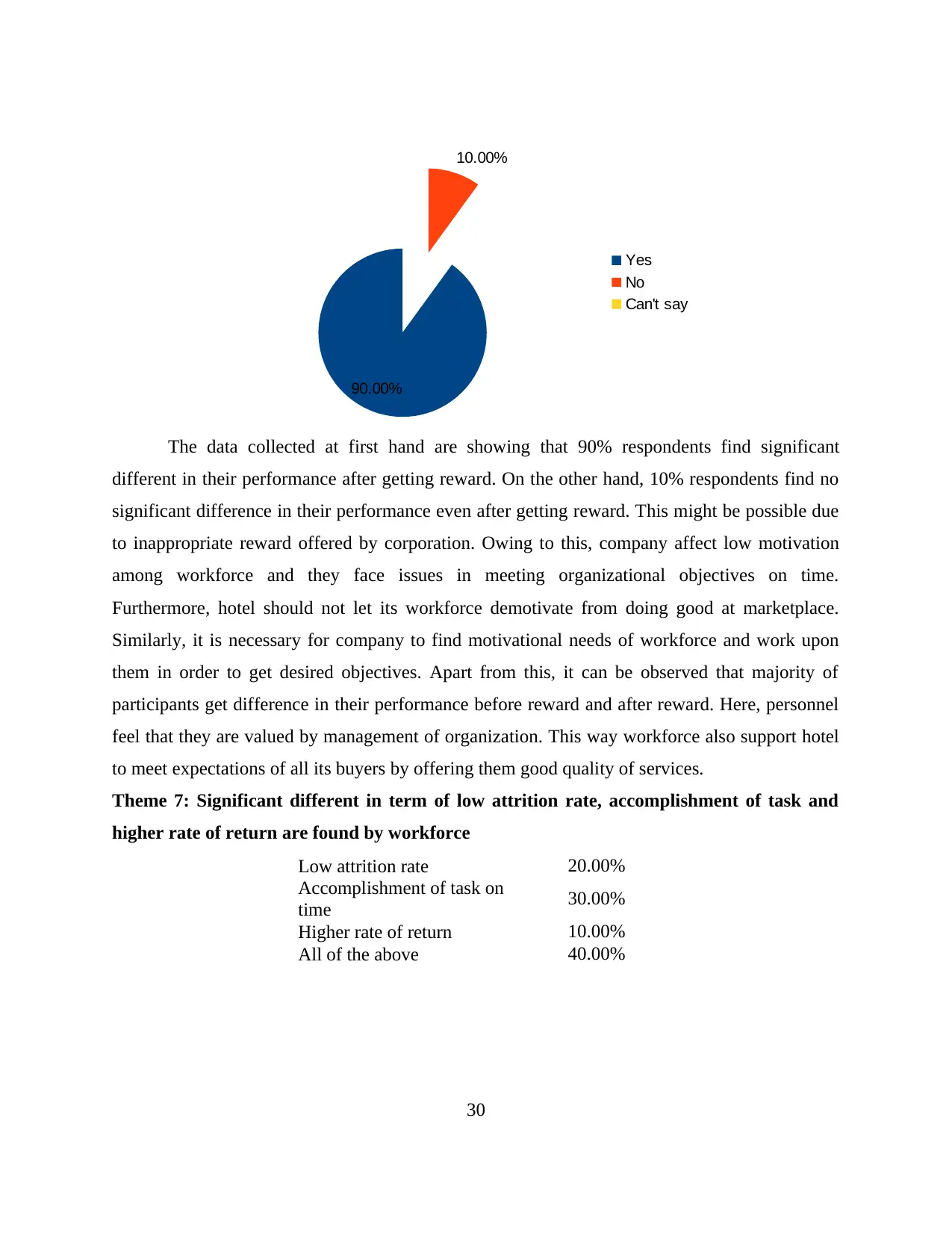
The data collected at first hand are showing that 90% respondents find significant
different in their performance after getting reward. On the other hand, 10% respondents find no
significant difference in their performance even after getting reward. This might be possible due
to inappropriate reward offered by corporation. Owing to this, company affect low motivation
among workforce and they face issues in meeting organizational objectives on time.
Furthermore, hotel should not let its workforce demotivate from doing good at marketplace.
Similarly, it is necessary for company to find motivational needs of workforce and work upon
them in order to get desired objectives. Apart from this, it can be observed that majority of
participants get difference in their performance before reward and after reward. Here, personnel
feel that they are valued by management of organization. This way workforce also support hotel
to meet expectations of all its buyers by offering them good quality of services.
Theme 7: Significant different in term of low attrition rate, accomplishment of task and
higher rate of return are found by workforce
Low attrition rate 20.00%
Accomplishment of task on
time 30.00%
Higher rate of return 10.00%
All of the above 40.00%
30
90.00%
10.00%
Yes
No
Can't say
different in their performance after getting reward. On the other hand, 10% respondents find no
significant difference in their performance even after getting reward. This might be possible due
to inappropriate reward offered by corporation. Owing to this, company affect low motivation
among workforce and they face issues in meeting organizational objectives on time.
Furthermore, hotel should not let its workforce demotivate from doing good at marketplace.
Similarly, it is necessary for company to find motivational needs of workforce and work upon
them in order to get desired objectives. Apart from this, it can be observed that majority of
participants get difference in their performance before reward and after reward. Here, personnel
feel that they are valued by management of organization. This way workforce also support hotel
to meet expectations of all its buyers by offering them good quality of services.
Theme 7: Significant different in term of low attrition rate, accomplishment of task and
higher rate of return are found by workforce
Low attrition rate 20.00%
Accomplishment of task on
time 30.00%
Higher rate of return 10.00%
All of the above 40.00%
30
90.00%
10.00%
Yes
No
Can't say
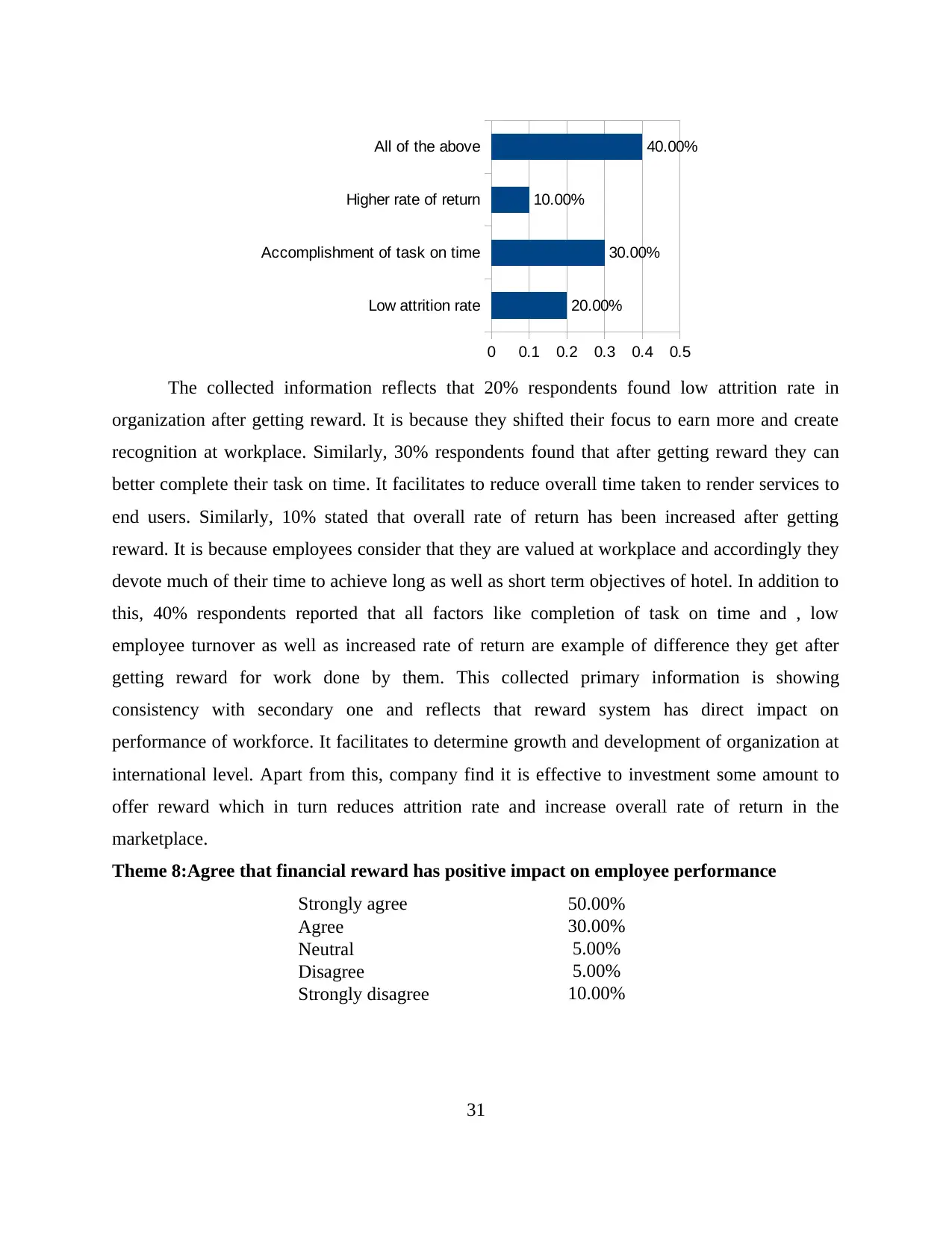
The collected information reflects that 20% respondents found low attrition rate in
organization after getting reward. It is because they shifted their focus to earn more and create
recognition at workplace. Similarly, 30% respondents found that after getting reward they can
better complete their task on time. It facilitates to reduce overall time taken to render services to
end users. Similarly, 10% stated that overall rate of return has been increased after getting
reward. It is because employees consider that they are valued at workplace and accordingly they
devote much of their time to achieve long as well as short term objectives of hotel. In addition to
this, 40% respondents reported that all factors like completion of task on time and , low
employee turnover as well as increased rate of return are example of difference they get after
getting reward for work done by them. This collected primary information is showing
consistency with secondary one and reflects that reward system has direct impact on
performance of workforce. It facilitates to determine growth and development of organization at
international level. Apart from this, company find it is effective to investment some amount to
offer reward which in turn reduces attrition rate and increase overall rate of return in the
marketplace.
Theme 8:Agree that financial reward has positive impact on employee performance
Strongly agree 50.00%
Agree 30.00%
Neutral 5.00%
Disagree 5.00%
Strongly disagree 10.00%
31
Low attrition rate
Accomplishment of task on time
Higher rate of return
All of the above
0 0.1 0.2 0.3 0.4 0.5
20.00%
30.00%
10.00%
40.00%
organization after getting reward. It is because they shifted their focus to earn more and create
recognition at workplace. Similarly, 30% respondents found that after getting reward they can
better complete their task on time. It facilitates to reduce overall time taken to render services to
end users. Similarly, 10% stated that overall rate of return has been increased after getting
reward. It is because employees consider that they are valued at workplace and accordingly they
devote much of their time to achieve long as well as short term objectives of hotel. In addition to
this, 40% respondents reported that all factors like completion of task on time and , low
employee turnover as well as increased rate of return are example of difference they get after
getting reward for work done by them. This collected primary information is showing
consistency with secondary one and reflects that reward system has direct impact on
performance of workforce. It facilitates to determine growth and development of organization at
international level. Apart from this, company find it is effective to investment some amount to
offer reward which in turn reduces attrition rate and increase overall rate of return in the
marketplace.
Theme 8:Agree that financial reward has positive impact on employee performance
Strongly agree 50.00%
Agree 30.00%
Neutral 5.00%
Disagree 5.00%
Strongly disagree 10.00%
31
Low attrition rate
Accomplishment of task on time
Higher rate of return
All of the above
0 0.1 0.2 0.3 0.4 0.5
20.00%
30.00%
10.00%
40.00%
Paraphrase This Document
Need a fresh take? Get an instant paraphrase of this document with our AI Paraphraser
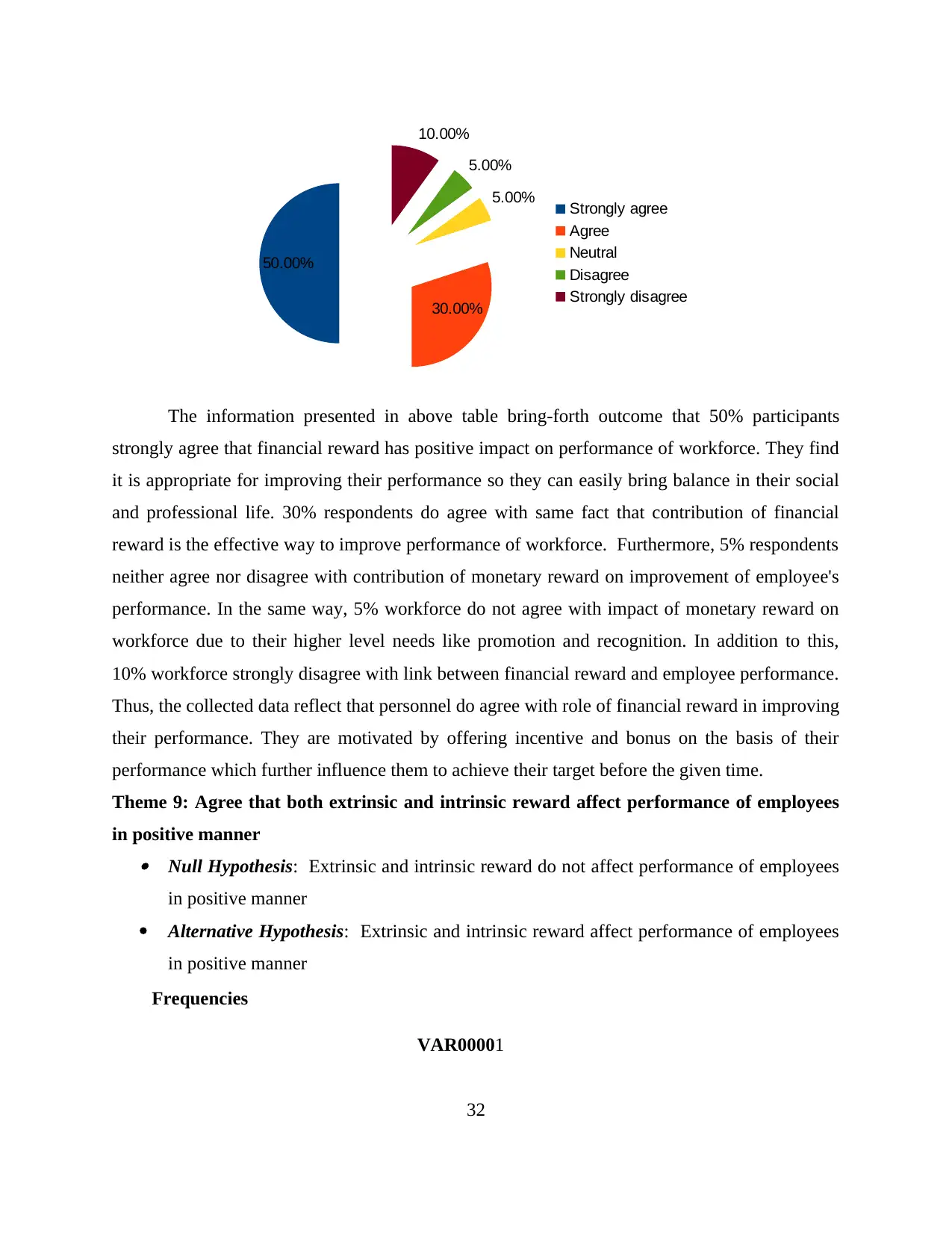
The information presented in above table bring-forth outcome that 50% participants
strongly agree that financial reward has positive impact on performance of workforce. They find
it is appropriate for improving their performance so they can easily bring balance in their social
and professional life. 30% respondents do agree with same fact that contribution of financial
reward is the effective way to improve performance of workforce. Furthermore, 5% respondents
neither agree nor disagree with contribution of monetary reward on improvement of employee's
performance. In the same way, 5% workforce do not agree with impact of monetary reward on
workforce due to their higher level needs like promotion and recognition. In addition to this,
10% workforce strongly disagree with link between financial reward and employee performance.
Thus, the collected data reflect that personnel do agree with role of financial reward in improving
their performance. They are motivated by offering incentive and bonus on the basis of their
performance which further influence them to achieve their target before the given time.
Theme 9: Agree that both extrinsic and intrinsic reward affect performance of employees
in positive manner Null Hypothesis: Extrinsic and intrinsic reward do not affect performance of employees
in positive manner
Alternative Hypothesis: Extrinsic and intrinsic reward affect performance of employees
in positive manner
Frequencies
VAR00001
32
50.00%
30.00%
5.00%
5.00%
10.00%
Strongly agree
Agree
Neutral
Disagree
Strongly disagree
strongly agree that financial reward has positive impact on performance of workforce. They find
it is appropriate for improving their performance so they can easily bring balance in their social
and professional life. 30% respondents do agree with same fact that contribution of financial
reward is the effective way to improve performance of workforce. Furthermore, 5% respondents
neither agree nor disagree with contribution of monetary reward on improvement of employee's
performance. In the same way, 5% workforce do not agree with impact of monetary reward on
workforce due to their higher level needs like promotion and recognition. In addition to this,
10% workforce strongly disagree with link between financial reward and employee performance.
Thus, the collected data reflect that personnel do agree with role of financial reward in improving
their performance. They are motivated by offering incentive and bonus on the basis of their
performance which further influence them to achieve their target before the given time.
Theme 9: Agree that both extrinsic and intrinsic reward affect performance of employees
in positive manner Null Hypothesis: Extrinsic and intrinsic reward do not affect performance of employees
in positive manner
Alternative Hypothesis: Extrinsic and intrinsic reward affect performance of employees
in positive manner
Frequencies
VAR00001
32
50.00%
30.00%
5.00%
5.00%
10.00%
Strongly agree
Agree
Neutral
Disagree
Strongly disagree
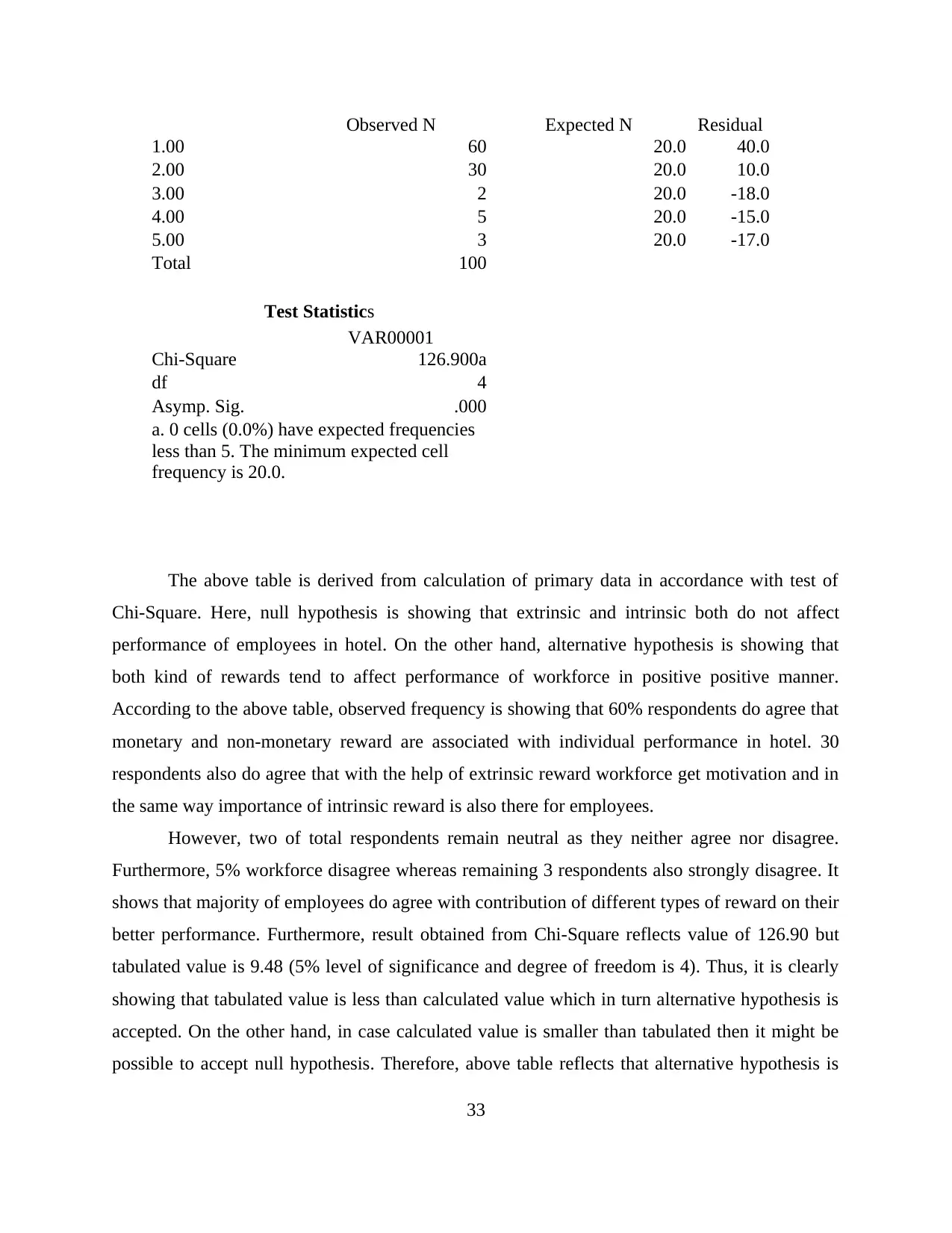
Observed N Expected N Residual
1.00 60 20.0 40.0
2.00 30 20.0 10.0
3.00 2 20.0 -18.0
4.00 5 20.0 -15.0
5.00 3 20.0 -17.0
Total 100
Test Statistics
VAR00001
Chi-Square 126.900a
df 4
Asymp. Sig. .000
a. 0 cells (0.0%) have expected frequencies
less than 5. The minimum expected cell
frequency is 20.0.
The above table is derived from calculation of primary data in accordance with test of
Chi-Square. Here, null hypothesis is showing that extrinsic and intrinsic both do not affect
performance of employees in hotel. On the other hand, alternative hypothesis is showing that
both kind of rewards tend to affect performance of workforce in positive positive manner.
According to the above table, observed frequency is showing that 60% respondents do agree that
monetary and non-monetary reward are associated with individual performance in hotel. 30
respondents also do agree that with the help of extrinsic reward workforce get motivation and in
the same way importance of intrinsic reward is also there for employees.
However, two of total respondents remain neutral as they neither agree nor disagree.
Furthermore, 5% workforce disagree whereas remaining 3 respondents also strongly disagree. It
shows that majority of employees do agree with contribution of different types of reward on their
better performance. Furthermore, result obtained from Chi-Square reflects value of 126.90 but
tabulated value is 9.48 (5% level of significance and degree of freedom is 4). Thus, it is clearly
showing that tabulated value is less than calculated value which in turn alternative hypothesis is
accepted. On the other hand, in case calculated value is smaller than tabulated then it might be
possible to accept null hypothesis. Therefore, above table reflects that alternative hypothesis is
33
1.00 60 20.0 40.0
2.00 30 20.0 10.0
3.00 2 20.0 -18.0
4.00 5 20.0 -15.0
5.00 3 20.0 -17.0
Total 100
Test Statistics
VAR00001
Chi-Square 126.900a
df 4
Asymp. Sig. .000
a. 0 cells (0.0%) have expected frequencies
less than 5. The minimum expected cell
frequency is 20.0.
The above table is derived from calculation of primary data in accordance with test of
Chi-Square. Here, null hypothesis is showing that extrinsic and intrinsic both do not affect
performance of employees in hotel. On the other hand, alternative hypothesis is showing that
both kind of rewards tend to affect performance of workforce in positive positive manner.
According to the above table, observed frequency is showing that 60% respondents do agree that
monetary and non-monetary reward are associated with individual performance in hotel. 30
respondents also do agree that with the help of extrinsic reward workforce get motivation and in
the same way importance of intrinsic reward is also there for employees.
However, two of total respondents remain neutral as they neither agree nor disagree.
Furthermore, 5% workforce disagree whereas remaining 3 respondents also strongly disagree. It
shows that majority of employees do agree with contribution of different types of reward on their
better performance. Furthermore, result obtained from Chi-Square reflects value of 126.90 but
tabulated value is 9.48 (5% level of significance and degree of freedom is 4). Thus, it is clearly
showing that tabulated value is less than calculated value which in turn alternative hypothesis is
accepted. On the other hand, in case calculated value is smaller than tabulated then it might be
possible to accept null hypothesis. Therefore, above table reflects that alternative hypothesis is
33
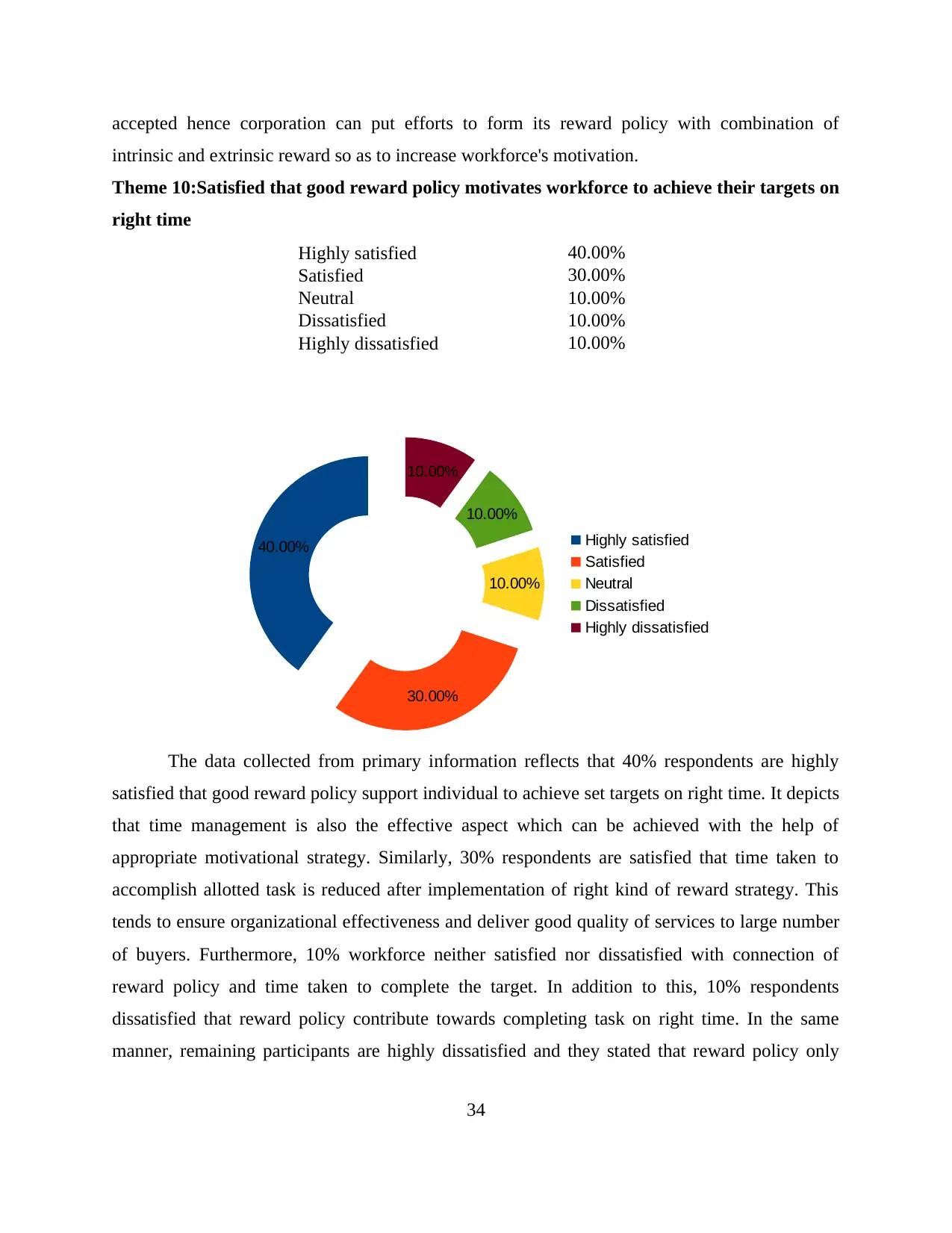
accepted hence corporation can put efforts to form its reward policy with combination of
intrinsic and extrinsic reward so as to increase workforce's motivation.
Theme 10:Satisfied that good reward policy motivates workforce to achieve their targets on
right time
Highly satisfied 40.00%
Satisfied 30.00%
Neutral 10.00%
Dissatisfied 10.00%
Highly dissatisfied 10.00%
The data collected from primary information reflects that 40% respondents are highly
satisfied that good reward policy support individual to achieve set targets on right time. It depicts
that time management is also the effective aspect which can be achieved with the help of
appropriate motivational strategy. Similarly, 30% respondents are satisfied that time taken to
accomplish allotted task is reduced after implementation of right kind of reward strategy. This
tends to ensure organizational effectiveness and deliver good quality of services to large number
of buyers. Furthermore, 10% workforce neither satisfied nor dissatisfied with connection of
reward policy and time taken to complete the target. In addition to this, 10% respondents
dissatisfied that reward policy contribute towards completing task on right time. In the same
manner, remaining participants are highly dissatisfied and they stated that reward policy only
34
40.00%
30.00%
10.00%
10.00%
10.00%
Highly satisfied
Satisfied
Neutral
Dissatisfied
Highly dissatisfied
intrinsic and extrinsic reward so as to increase workforce's motivation.
Theme 10:Satisfied that good reward policy motivates workforce to achieve their targets on
right time
Highly satisfied 40.00%
Satisfied 30.00%
Neutral 10.00%
Dissatisfied 10.00%
Highly dissatisfied 10.00%
The data collected from primary information reflects that 40% respondents are highly
satisfied that good reward policy support individual to achieve set targets on right time. It depicts
that time management is also the effective aspect which can be achieved with the help of
appropriate motivational strategy. Similarly, 30% respondents are satisfied that time taken to
accomplish allotted task is reduced after implementation of right kind of reward strategy. This
tends to ensure organizational effectiveness and deliver good quality of services to large number
of buyers. Furthermore, 10% workforce neither satisfied nor dissatisfied with connection of
reward policy and time taken to complete the target. In addition to this, 10% respondents
dissatisfied that reward policy contribute towards completing task on right time. In the same
manner, remaining participants are highly dissatisfied and they stated that reward policy only
34
40.00%
30.00%
10.00%
10.00%
10.00%
Highly satisfied
Satisfied
Neutral
Dissatisfied
Highly dissatisfied
Secure Best Marks with AI Grader
Need help grading? Try our AI Grader for instant feedback on your assignments.

motivate workforce but do not reduce time taken to accomplish given task. The collected
information is consistent with secondary also where it can be said that reward strategies support
individual to perform their task effectively and perform good in the marketplace.
1.3 Conclusion
The data analysis chapter concludes that reward system proves to be effective in long run
success of corporation. It becomes critical to manage the workforce without motivating them by
using effective reward policies. The same critical aspects has been incorporated in the chapter of
data analysis which provides more realistic information related to importance of reward system
in improving workforce performance. It can also be said that both positive and negative aspects
are analyzed in the chapter which leads to portray clear link between reward system and
workforce performance.
35
information is consistent with secondary also where it can be said that reward strategies support
individual to perform their task effectively and perform good in the marketplace.
1.3 Conclusion
The data analysis chapter concludes that reward system proves to be effective in long run
success of corporation. It becomes critical to manage the workforce without motivating them by
using effective reward policies. The same critical aspects has been incorporated in the chapter of
data analysis which provides more realistic information related to importance of reward system
in improving workforce performance. It can also be said that both positive and negative aspects
are analyzed in the chapter which leads to portray clear link between reward system and
workforce performance.
35

CHAPTER 5: CONCLUSION AND RECOMMENDATIONS
5.1 Conclusion
The above chapter of data analysis concludes that reward system of company has direct
impact on employees performance. However, it depends on individual requirement and
accordingly management plan for implementing strategies. This aspect has significant difference
on performance of employees in term of reduced employee turnover and high rate of return. Not
only this but time taken to complete allotted task is also reduced to a great extent. This is
showing that contribution of reward policy is very important in boosting morale of workforce
and supporting them to achieve their targets on right time. It is also well known fact that
achievement tends to give higher level of motivation and this further leads to success.
It has also been analyzed that monetary reward is not sufficient to improve the
performance of workforce. Here, it is also important to assess need of employees related to
working condition and job profile so they can work with concentration. This is because
monotonous work merely demotivate workforce and do not support them in accomplishing their
targets on time. For this purpose, it is essential for Marriott hotel to address issues faced by
workforce in context of job profile. However, there is not sense to offer non-monetary reward for
workforce working at lower level because they seek incentive and bonus to fulfill their need.
Apart from this, extra benefits related to transportation charges are also important for lower level
management. This reflects that reward can be set after proper analysis of employees and their
requirement.
Furthermore, intrinsic reward are offered for employees to bring perfection in their
personality which leads to generate positive attitude among them. It direct aid to their abilities,
skills and competency through which they gain better position in corporation. Similarly, an issue
related to low skilled workforce is faced in Marriott hotel which has adverse impact on
performance of company. Owing to this, barriers regarding meeting expectations of buyers is
faced that create bad impression of corporation. For this purpose, different alternatives are used
by management for improving performance of workforce so as to retain them for longer time
span. At the same time they are motivated by using different mode of communication which
serve as the effective method to increase their productivity.
36
5.1 Conclusion
The above chapter of data analysis concludes that reward system of company has direct
impact on employees performance. However, it depends on individual requirement and
accordingly management plan for implementing strategies. This aspect has significant difference
on performance of employees in term of reduced employee turnover and high rate of return. Not
only this but time taken to complete allotted task is also reduced to a great extent. This is
showing that contribution of reward policy is very important in boosting morale of workforce
and supporting them to achieve their targets on right time. It is also well known fact that
achievement tends to give higher level of motivation and this further leads to success.
It has also been analyzed that monetary reward is not sufficient to improve the
performance of workforce. Here, it is also important to assess need of employees related to
working condition and job profile so they can work with concentration. This is because
monotonous work merely demotivate workforce and do not support them in accomplishing their
targets on time. For this purpose, it is essential for Marriott hotel to address issues faced by
workforce in context of job profile. However, there is not sense to offer non-monetary reward for
workforce working at lower level because they seek incentive and bonus to fulfill their need.
Apart from this, extra benefits related to transportation charges are also important for lower level
management. This reflects that reward can be set after proper analysis of employees and their
requirement.
Furthermore, intrinsic reward are offered for employees to bring perfection in their
personality which leads to generate positive attitude among them. It direct aid to their abilities,
skills and competency through which they gain better position in corporation. Similarly, an issue
related to low skilled workforce is faced in Marriott hotel which has adverse impact on
performance of company. Owing to this, barriers regarding meeting expectations of buyers is
faced that create bad impression of corporation. For this purpose, different alternatives are used
by management for improving performance of workforce so as to retain them for longer time
span. At the same time they are motivated by using different mode of communication which
serve as the effective method to increase their productivity.
36
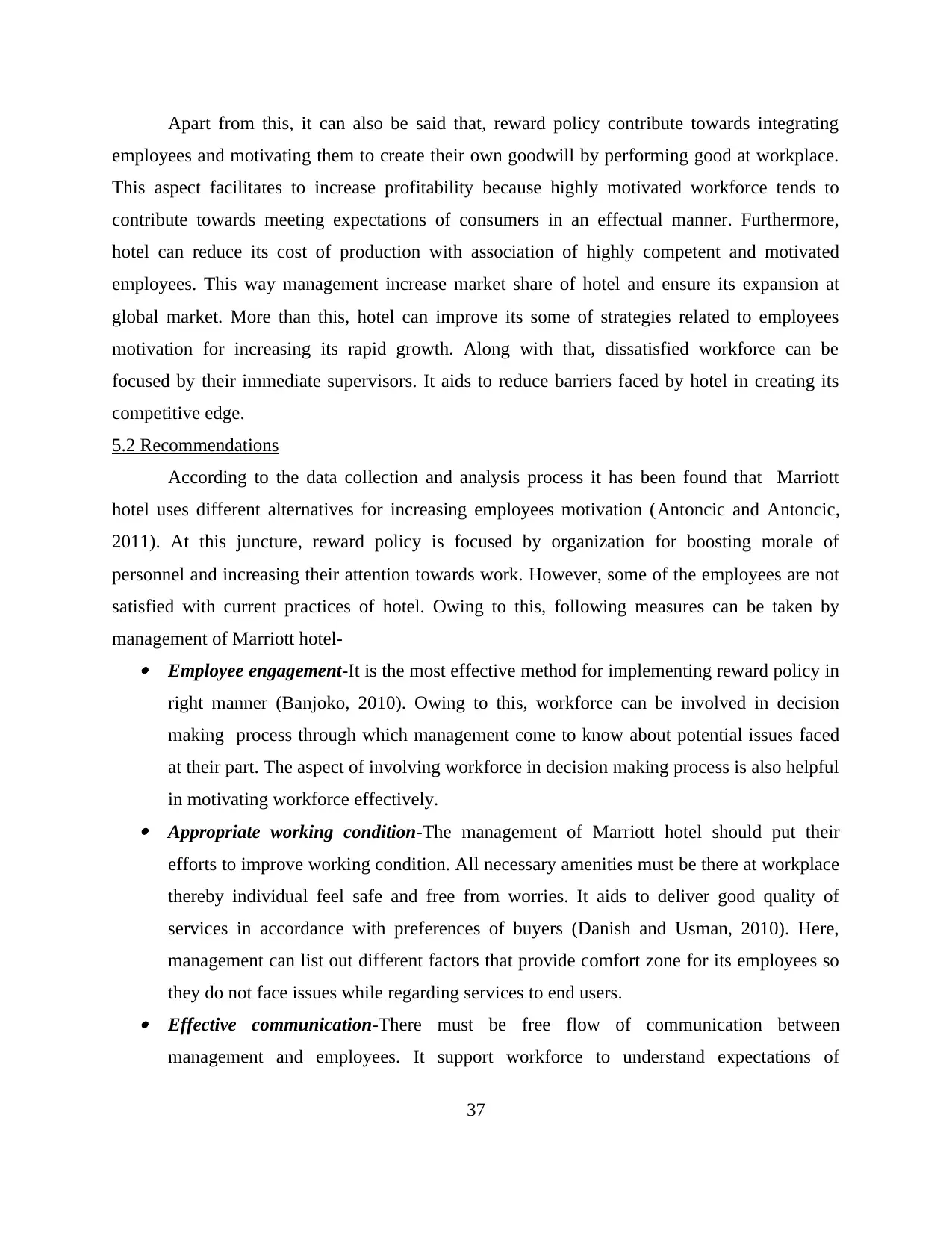
Apart from this, it can also be said that, reward policy contribute towards integrating
employees and motivating them to create their own goodwill by performing good at workplace.
This aspect facilitates to increase profitability because highly motivated workforce tends to
contribute towards meeting expectations of consumers in an effectual manner. Furthermore,
hotel can reduce its cost of production with association of highly competent and motivated
employees. This way management increase market share of hotel and ensure its expansion at
global market. More than this, hotel can improve its some of strategies related to employees
motivation for increasing its rapid growth. Along with that, dissatisfied workforce can be
focused by their immediate supervisors. It aids to reduce barriers faced by hotel in creating its
competitive edge.
5.2 Recommendations
According to the data collection and analysis process it has been found that Marriott
hotel uses different alternatives for increasing employees motivation (Antoncic and Antoncic,
2011). At this juncture, reward policy is focused by organization for boosting morale of
personnel and increasing their attention towards work. However, some of the employees are not
satisfied with current practices of hotel. Owing to this, following measures can be taken by
management of Marriott hotel- Employee engagement-It is the most effective method for implementing reward policy in
right manner (Banjoko, 2010). Owing to this, workforce can be involved in decision
making process through which management come to know about potential issues faced
at their part. The aspect of involving workforce in decision making process is also helpful
in motivating workforce effectively. Appropriate working condition-The management of Marriott hotel should put their
efforts to improve working condition. All necessary amenities must be there at workplace
thereby individual feel safe and free from worries. It aids to deliver good quality of
services in accordance with preferences of buyers (Danish and Usman, 2010). Here,
management can list out different factors that provide comfort zone for its employees so
they do not face issues while regarding services to end users. Effective communication-There must be free flow of communication between
management and employees. It support workforce to understand expectations of
37
employees and motivating them to create their own goodwill by performing good at workplace.
This aspect facilitates to increase profitability because highly motivated workforce tends to
contribute towards meeting expectations of consumers in an effectual manner. Furthermore,
hotel can reduce its cost of production with association of highly competent and motivated
employees. This way management increase market share of hotel and ensure its expansion at
global market. More than this, hotel can improve its some of strategies related to employees
motivation for increasing its rapid growth. Along with that, dissatisfied workforce can be
focused by their immediate supervisors. It aids to reduce barriers faced by hotel in creating its
competitive edge.
5.2 Recommendations
According to the data collection and analysis process it has been found that Marriott
hotel uses different alternatives for increasing employees motivation (Antoncic and Antoncic,
2011). At this juncture, reward policy is focused by organization for boosting morale of
personnel and increasing their attention towards work. However, some of the employees are not
satisfied with current practices of hotel. Owing to this, following measures can be taken by
management of Marriott hotel- Employee engagement-It is the most effective method for implementing reward policy in
right manner (Banjoko, 2010). Owing to this, workforce can be involved in decision
making process through which management come to know about potential issues faced
at their part. The aspect of involving workforce in decision making process is also helpful
in motivating workforce effectively. Appropriate working condition-The management of Marriott hotel should put their
efforts to improve working condition. All necessary amenities must be there at workplace
thereby individual feel safe and free from worries. It aids to deliver good quality of
services in accordance with preferences of buyers (Danish and Usman, 2010). Here,
management can list out different factors that provide comfort zone for its employees so
they do not face issues while regarding services to end users. Effective communication-There must be free flow of communication between
management and employees. It support workforce to understand expectations of
37
Paraphrase This Document
Need a fresh take? Get an instant paraphrase of this document with our AI Paraphraser
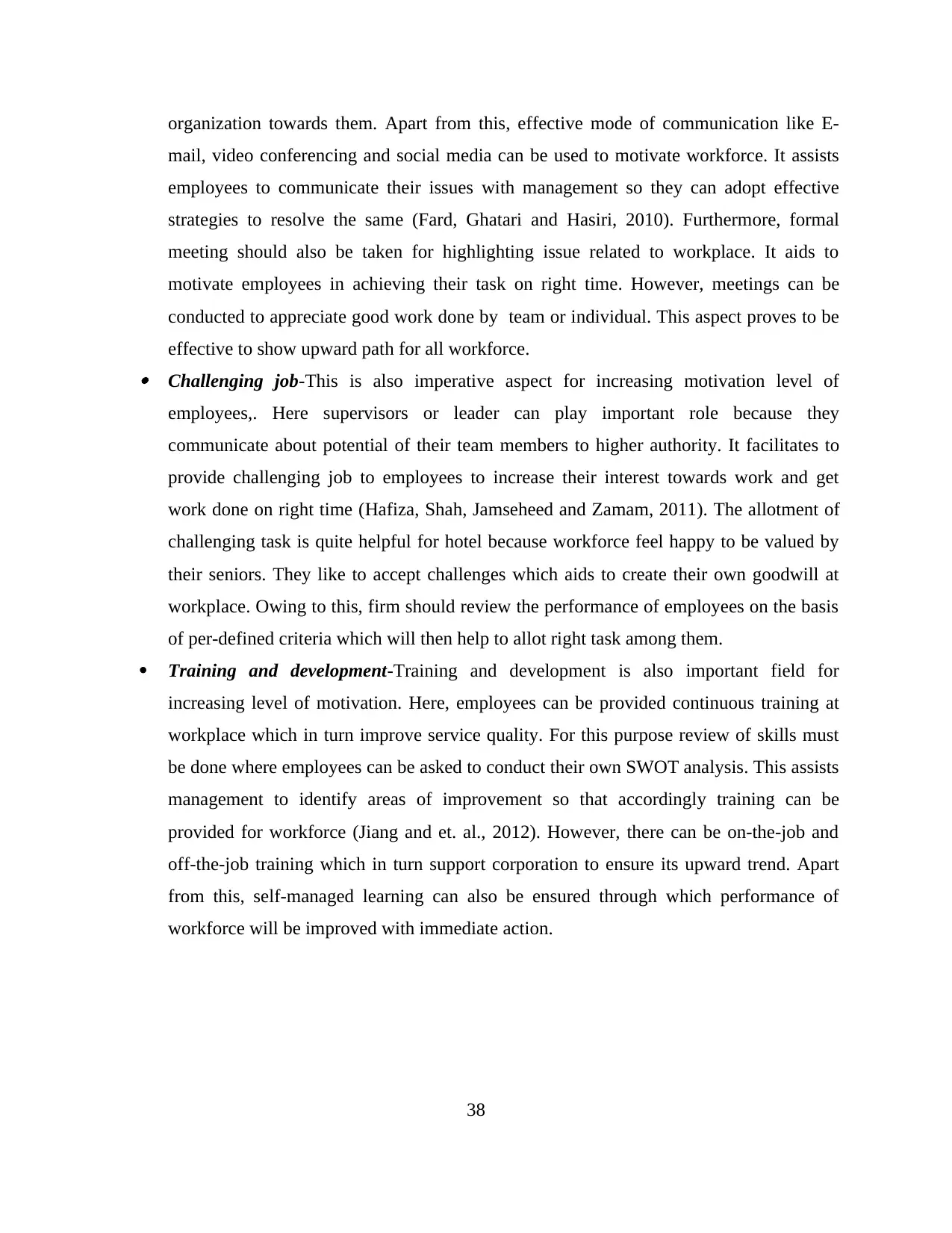
organization towards them. Apart from this, effective mode of communication like E-
mail, video conferencing and social media can be used to motivate workforce. It assists
employees to communicate their issues with management so they can adopt effective
strategies to resolve the same (Fard, Ghatari and Hasiri, 2010). Furthermore, formal
meeting should also be taken for highlighting issue related to workplace. It aids to
motivate employees in achieving their task on right time. However, meetings can be
conducted to appreciate good work done by team or individual. This aspect proves to be
effective to show upward path for all workforce. Challenging job-This is also imperative aspect for increasing motivation level of
employees,. Here supervisors or leader can play important role because they
communicate about potential of their team members to higher authority. It facilitates to
provide challenging job to employees to increase their interest towards work and get
work done on right time (Hafiza, Shah, Jamseheed and Zamam, 2011). The allotment of
challenging task is quite helpful for hotel because workforce feel happy to be valued by
their seniors. They like to accept challenges which aids to create their own goodwill at
workplace. Owing to this, firm should review the performance of employees on the basis
of per-defined criteria which will then help to allot right task among them.
Training and development-Training and development is also important field for
increasing level of motivation. Here, employees can be provided continuous training at
workplace which in turn improve service quality. For this purpose review of skills must
be done where employees can be asked to conduct their own SWOT analysis. This assists
management to identify areas of improvement so that accordingly training can be
provided for workforce (Jiang and et. al., 2012). However, there can be on-the-job and
off-the-job training which in turn support corporation to ensure its upward trend. Apart
from this, self-managed learning can also be ensured through which performance of
workforce will be improved with immediate action.
38
mail, video conferencing and social media can be used to motivate workforce. It assists
employees to communicate their issues with management so they can adopt effective
strategies to resolve the same (Fard, Ghatari and Hasiri, 2010). Furthermore, formal
meeting should also be taken for highlighting issue related to workplace. It aids to
motivate employees in achieving their task on right time. However, meetings can be
conducted to appreciate good work done by team or individual. This aspect proves to be
effective to show upward path for all workforce. Challenging job-This is also imperative aspect for increasing motivation level of
employees,. Here supervisors or leader can play important role because they
communicate about potential of their team members to higher authority. It facilitates to
provide challenging job to employees to increase their interest towards work and get
work done on right time (Hafiza, Shah, Jamseheed and Zamam, 2011). The allotment of
challenging task is quite helpful for hotel because workforce feel happy to be valued by
their seniors. They like to accept challenges which aids to create their own goodwill at
workplace. Owing to this, firm should review the performance of employees on the basis
of per-defined criteria which will then help to allot right task among them.
Training and development-Training and development is also important field for
increasing level of motivation. Here, employees can be provided continuous training at
workplace which in turn improve service quality. For this purpose review of skills must
be done where employees can be asked to conduct their own SWOT analysis. This assists
management to identify areas of improvement so that accordingly training can be
provided for workforce (Jiang and et. al., 2012). However, there can be on-the-job and
off-the-job training which in turn support corporation to ensure its upward trend. Apart
from this, self-managed learning can also be ensured through which performance of
workforce will be improved with immediate action.
38
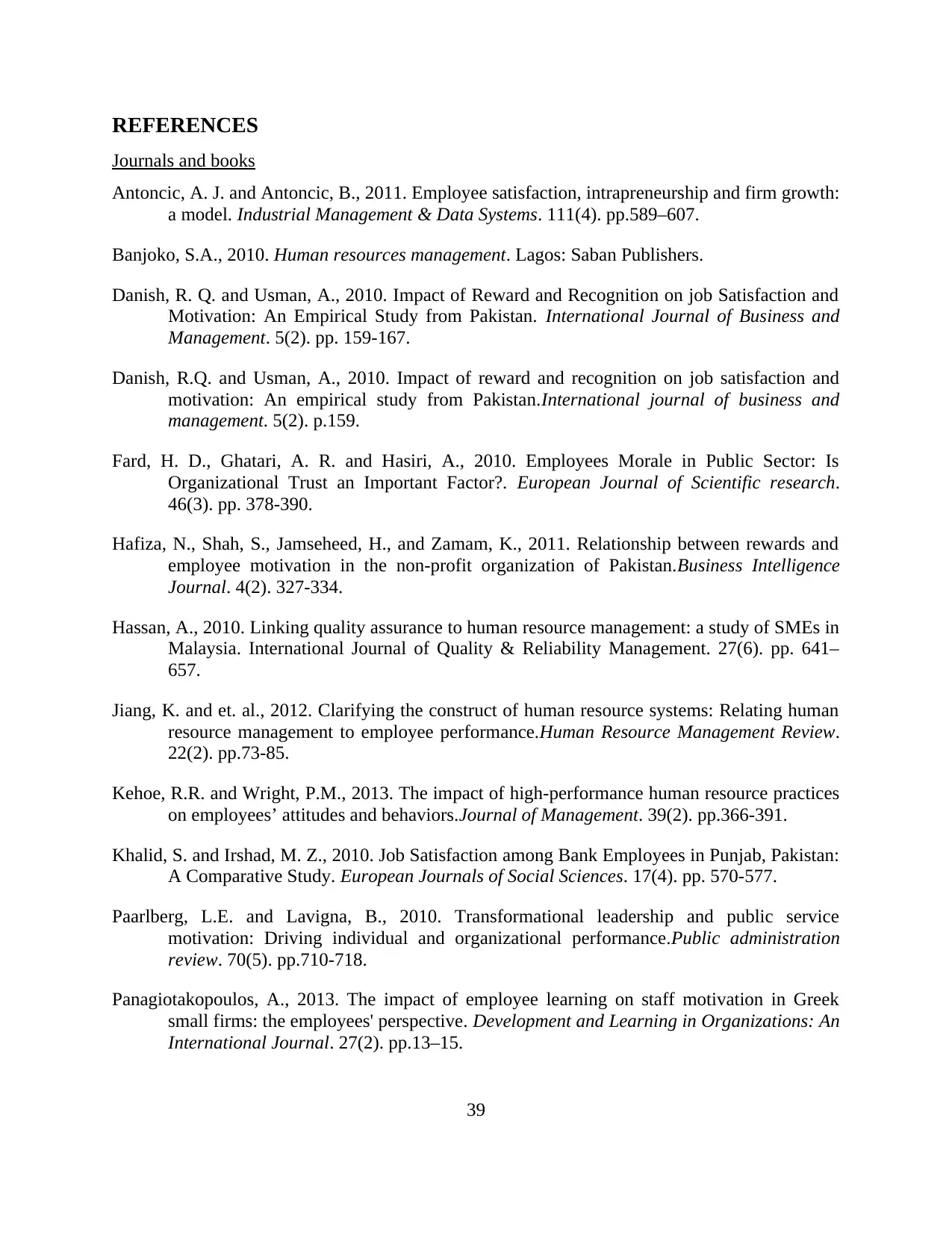
REFERENCES
Journals and books
Antoncic, A. J. and Antoncic, B., 2011. Employee satisfaction, intrapreneurship and firm growth:
a model. Industrial Management & Data Systems. 111(4). pp.589–607.
Banjoko, S.A., 2010. Human resources management. Lagos: Saban Publishers.
Danish, R. Q. and Usman, A., 2010. Impact of Reward and Recognition on job Satisfaction and
Motivation: An Empirical Study from Pakistan. International Journal of Business and
Management. 5(2). pp. 159-167.
Danish, R.Q. and Usman, A., 2010. Impact of reward and recognition on job satisfaction and
motivation: An empirical study from Pakistan.International journal of business and
management. 5(2). p.159.
Fard, H. D., Ghatari, A. R. and Hasiri, A., 2010. Employees Morale in Public Sector: Is
Organizational Trust an Important Factor?. European Journal of Scientific research.
46(3). pp. 378-390.
Hafiza, N., Shah, S., Jamseheed, H., and Zamam, K., 2011. Relationship between rewards and
employee motivation in the non-profit organization of Pakistan.Business Intelligence
Journal. 4(2). 327-334.
Hassan, A., 2010. Linking quality assurance to human resource management: a study of SMEs in
Malaysia. International Journal of Quality & Reliability Management. 27(6). pp. 641–
657.
Jiang, K. and et. al., 2012. Clarifying the construct of human resource systems: Relating human
resource management to employee performance.Human Resource Management Review.
22(2). pp.73-85.
Kehoe, R.R. and Wright, P.M., 2013. The impact of high-performance human resource practices
on employees’ attitudes and behaviors.Journal of Management. 39(2). pp.366-391.
Khalid, S. and Irshad, M. Z., 2010. Job Satisfaction among Bank Employees in Punjab, Pakistan:
A Comparative Study. European Journals of Social Sciences. 17(4). pp. 570-577.
Paarlberg, L.E. and Lavigna, B., 2010. Transformational leadership and public service
motivation: Driving individual and organizational performance.Public administration
review. 70(5). pp.710-718.
Panagiotakopoulos, A., 2013. The impact of employee learning on staff motivation in Greek
small firms: the employees' perspective. Development and Learning in Organizations: An
International Journal. 27(2). pp.13–15.
39
Journals and books
Antoncic, A. J. and Antoncic, B., 2011. Employee satisfaction, intrapreneurship and firm growth:
a model. Industrial Management & Data Systems. 111(4). pp.589–607.
Banjoko, S.A., 2010. Human resources management. Lagos: Saban Publishers.
Danish, R. Q. and Usman, A., 2010. Impact of Reward and Recognition on job Satisfaction and
Motivation: An Empirical Study from Pakistan. International Journal of Business and
Management. 5(2). pp. 159-167.
Danish, R.Q. and Usman, A., 2010. Impact of reward and recognition on job satisfaction and
motivation: An empirical study from Pakistan.International journal of business and
management. 5(2). p.159.
Fard, H. D., Ghatari, A. R. and Hasiri, A., 2010. Employees Morale in Public Sector: Is
Organizational Trust an Important Factor?. European Journal of Scientific research.
46(3). pp. 378-390.
Hafiza, N., Shah, S., Jamseheed, H., and Zamam, K., 2011. Relationship between rewards and
employee motivation in the non-profit organization of Pakistan.Business Intelligence
Journal. 4(2). 327-334.
Hassan, A., 2010. Linking quality assurance to human resource management: a study of SMEs in
Malaysia. International Journal of Quality & Reliability Management. 27(6). pp. 641–
657.
Jiang, K. and et. al., 2012. Clarifying the construct of human resource systems: Relating human
resource management to employee performance.Human Resource Management Review.
22(2). pp.73-85.
Kehoe, R.R. and Wright, P.M., 2013. The impact of high-performance human resource practices
on employees’ attitudes and behaviors.Journal of Management. 39(2). pp.366-391.
Khalid, S. and Irshad, M. Z., 2010. Job Satisfaction among Bank Employees in Punjab, Pakistan:
A Comparative Study. European Journals of Social Sciences. 17(4). pp. 570-577.
Paarlberg, L.E. and Lavigna, B., 2010. Transformational leadership and public service
motivation: Driving individual and organizational performance.Public administration
review. 70(5). pp.710-718.
Panagiotakopoulos, A., 2013. The impact of employee learning on staff motivation in Greek
small firms: the employees' perspective. Development and Learning in Organizations: An
International Journal. 27(2). pp.13–15.
39
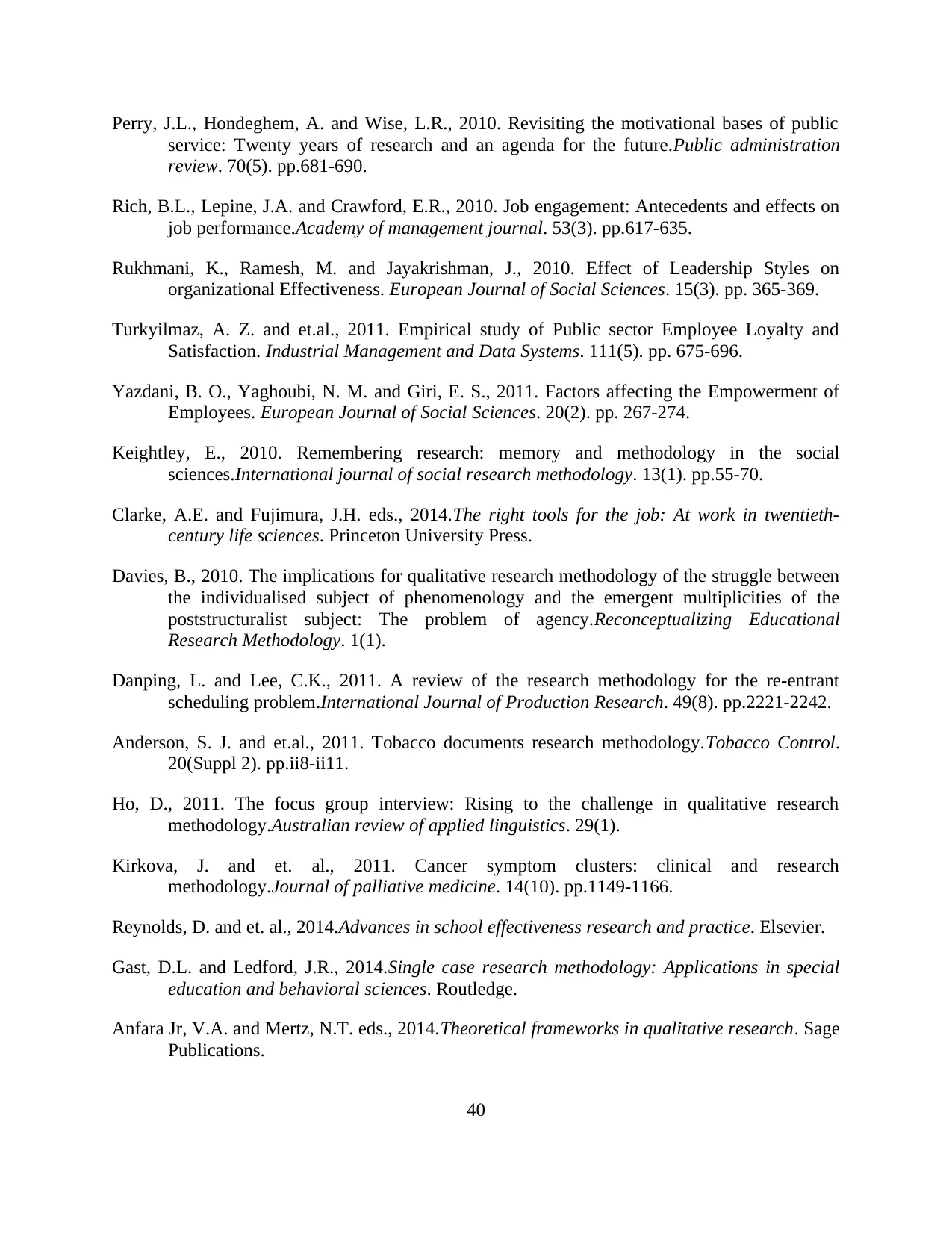
Perry, J.L., Hondeghem, A. and Wise, L.R., 2010. Revisiting the motivational bases of public
service: Twenty years of research and an agenda for the future.Public administration
review. 70(5). pp.681-690.
Rich, B.L., Lepine, J.A. and Crawford, E.R., 2010. Job engagement: Antecedents and effects on
job performance.Academy of management journal. 53(3). pp.617-635.
Rukhmani, K., Ramesh, M. and Jayakrishman, J., 2010. Effect of Leadership Styles on
organizational Effectiveness. European Journal of Social Sciences. 15(3). pp. 365-369.
Turkyilmaz, A. Z. and et.al., 2011. Empirical study of Public sector Employee Loyalty and
Satisfaction. Industrial Management and Data Systems. 111(5). pp. 675-696.
Yazdani, B. O., Yaghoubi, N. M. and Giri, E. S., 2011. Factors affecting the Empowerment of
Employees. European Journal of Social Sciences. 20(2). pp. 267-274.
Keightley, E., 2010. Remembering research: memory and methodology in the social
sciences.International journal of social research methodology. 13(1). pp.55-70.
Clarke, A.E. and Fujimura, J.H. eds., 2014.The right tools for the job: At work in twentieth-
century life sciences. Princeton University Press.
Davies, B., 2010. The implications for qualitative research methodology of the struggle between
the individualised subject of phenomenology and the emergent multiplicities of the
poststructuralist subject: The problem of agency.Reconceptualizing Educational
Research Methodology. 1(1).
Danping, L. and Lee, C.K., 2011. A review of the research methodology for the re-entrant
scheduling problem.International Journal of Production Research. 49(8). pp.2221-2242.
Anderson, S. J. and et.al., 2011. Tobacco documents research methodology.Tobacco Control.
20(Suppl 2). pp.ii8-ii11.
Ho, D., 2011. The focus group interview: Rising to the challenge in qualitative research
methodology.Australian review of applied linguistics. 29(1).
Kirkova, J. and et. al., 2011. Cancer symptom clusters: clinical and research
methodology.Journal of palliative medicine. 14(10). pp.1149-1166.
Reynolds, D. and et. al., 2014.Advances in school effectiveness research and practice. Elsevier.
Gast, D.L. and Ledford, J.R., 2014.Single case research methodology: Applications in special
education and behavioral sciences. Routledge.
Anfara Jr, V.A. and Mertz, N.T. eds., 2014.Theoretical frameworks in qualitative research. Sage
Publications.
40
service: Twenty years of research and an agenda for the future.Public administration
review. 70(5). pp.681-690.
Rich, B.L., Lepine, J.A. and Crawford, E.R., 2010. Job engagement: Antecedents and effects on
job performance.Academy of management journal. 53(3). pp.617-635.
Rukhmani, K., Ramesh, M. and Jayakrishman, J., 2010. Effect of Leadership Styles on
organizational Effectiveness. European Journal of Social Sciences. 15(3). pp. 365-369.
Turkyilmaz, A. Z. and et.al., 2011. Empirical study of Public sector Employee Loyalty and
Satisfaction. Industrial Management and Data Systems. 111(5). pp. 675-696.
Yazdani, B. O., Yaghoubi, N. M. and Giri, E. S., 2011. Factors affecting the Empowerment of
Employees. European Journal of Social Sciences. 20(2). pp. 267-274.
Keightley, E., 2010. Remembering research: memory and methodology in the social
sciences.International journal of social research methodology. 13(1). pp.55-70.
Clarke, A.E. and Fujimura, J.H. eds., 2014.The right tools for the job: At work in twentieth-
century life sciences. Princeton University Press.
Davies, B., 2010. The implications for qualitative research methodology of the struggle between
the individualised subject of phenomenology and the emergent multiplicities of the
poststructuralist subject: The problem of agency.Reconceptualizing Educational
Research Methodology. 1(1).
Danping, L. and Lee, C.K., 2011. A review of the research methodology for the re-entrant
scheduling problem.International Journal of Production Research. 49(8). pp.2221-2242.
Anderson, S. J. and et.al., 2011. Tobacco documents research methodology.Tobacco Control.
20(Suppl 2). pp.ii8-ii11.
Ho, D., 2011. The focus group interview: Rising to the challenge in qualitative research
methodology.Australian review of applied linguistics. 29(1).
Kirkova, J. and et. al., 2011. Cancer symptom clusters: clinical and research
methodology.Journal of palliative medicine. 14(10). pp.1149-1166.
Reynolds, D. and et. al., 2014.Advances in school effectiveness research and practice. Elsevier.
Gast, D.L. and Ledford, J.R., 2014.Single case research methodology: Applications in special
education and behavioral sciences. Routledge.
Anfara Jr, V.A. and Mertz, N.T. eds., 2014.Theoretical frameworks in qualitative research. Sage
Publications.
40
Secure Best Marks with AI Grader
Need help grading? Try our AI Grader for instant feedback on your assignments.
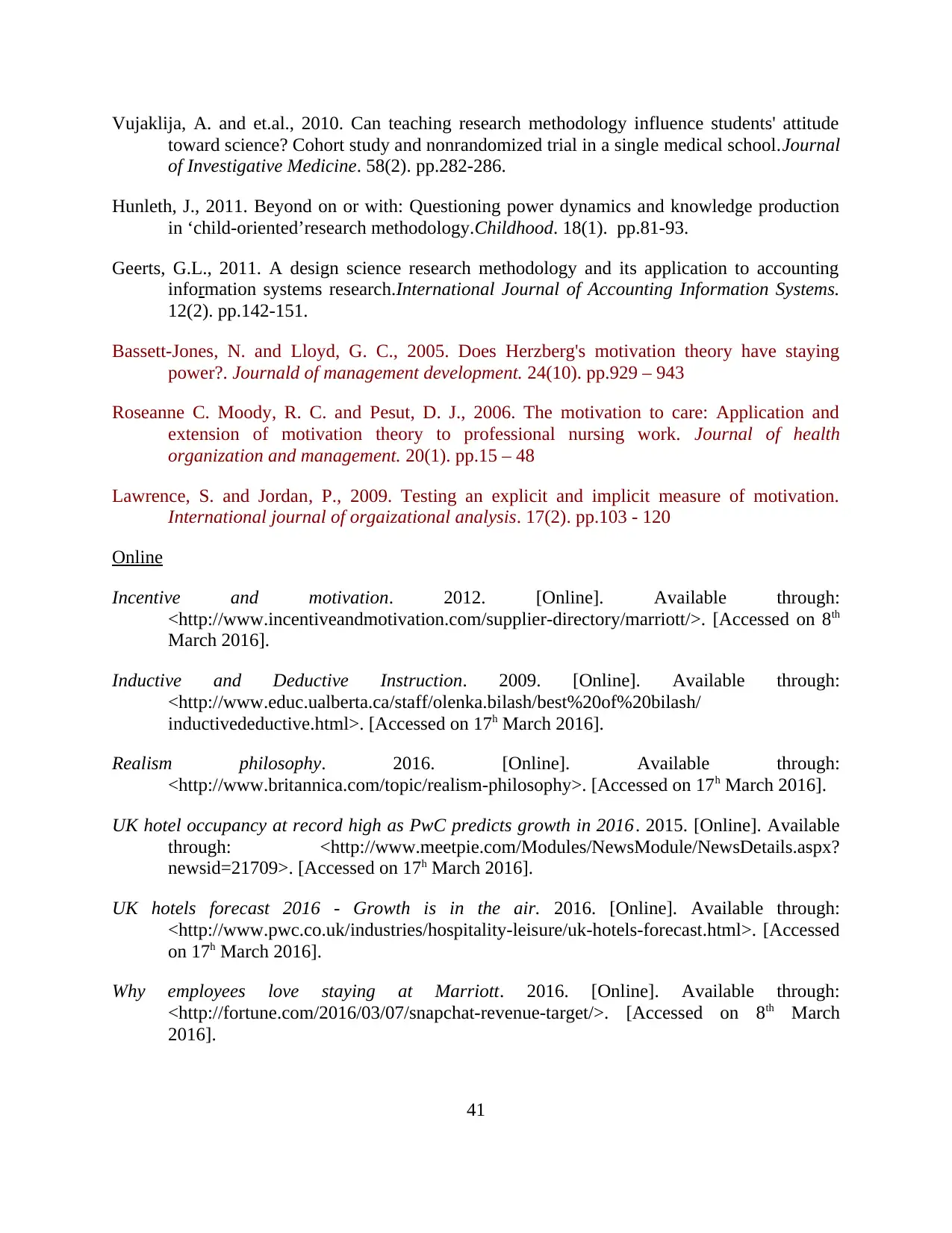
Vujaklija, A. and et.al., 2010. Can teaching research methodology influence students' attitude
toward science? Cohort study and nonrandomized trial in a single medical school.Journal
of Investigative Medicine. 58(2). pp.282-286.
Hunleth, J., 2011. Beyond on or with: Questioning power dynamics and knowledge production
in ‘child-oriented’research methodology.Childhood. 18(1). pp.81-93.
Geerts, G.L., 2011. A design science research methodology and its application to accounting
information systems research.International Journal of Accounting Information Systems.
12(2). pp.142-151.
Bassett‐Jones, N. and Lloyd, G. C., 2005. Does Herzberg's motivation theory have staying
power?. Journald of management development. 24(10). pp.929 – 943
Roseanne C. Moody, R. C. and Pesut, D. J., 2006. The motivation to care: Application and
extension of motivation theory to professional nursing work. Journal of health
organization and management. 20(1). pp.15 – 48
Lawrence, S. and Jordan, P., 2009. Testing an explicit and implicit measure of motivation.
International journal of orgaizational analysis. 17(2). pp.103 - 120
Online
Incentive and motivation. 2012. [Online]. Available through:
<http://www.incentiveandmotivation.com/supplier-directory/marriott/>. [Accessed on 8th
March 2016].
Inductive and Deductive Instruction. 2009. [Online]. Available through:
<http://www.educ.ualberta.ca/staff/olenka.bilash/best%20of%20bilash/
inductivedeductive.html>. [Accessed on 17h March 2016].
Realism philosophy. 2016. [Online]. Available through:
<http://www.britannica.com/topic/realism-philosophy>. [Accessed on 17h March 2016].
UK hotel occupancy at record high as PwC predicts growth in 2016. 2015. [Online]. Available
through: <http://www.meetpie.com/Modules/NewsModule/NewsDetails.aspx?
newsid=21709>. [Accessed on 17h March 2016].
UK hotels forecast 2016 - Growth is in the air. 2016. [Online]. Available through:
<http://www.pwc.co.uk/industries/hospitality-leisure/uk-hotels-forecast.html>. [Accessed
on 17h March 2016].
Why employees love staying at Marriott. 2016. [Online]. Available through:
<http://fortune.com/2016/03/07/snapchat-revenue-target/>. [Accessed on 8th March
2016].
41
toward science? Cohort study and nonrandomized trial in a single medical school.Journal
of Investigative Medicine. 58(2). pp.282-286.
Hunleth, J., 2011. Beyond on or with: Questioning power dynamics and knowledge production
in ‘child-oriented’research methodology.Childhood. 18(1). pp.81-93.
Geerts, G.L., 2011. A design science research methodology and its application to accounting
information systems research.International Journal of Accounting Information Systems.
12(2). pp.142-151.
Bassett‐Jones, N. and Lloyd, G. C., 2005. Does Herzberg's motivation theory have staying
power?. Journald of management development. 24(10). pp.929 – 943
Roseanne C. Moody, R. C. and Pesut, D. J., 2006. The motivation to care: Application and
extension of motivation theory to professional nursing work. Journal of health
organization and management. 20(1). pp.15 – 48
Lawrence, S. and Jordan, P., 2009. Testing an explicit and implicit measure of motivation.
International journal of orgaizational analysis. 17(2). pp.103 - 120
Online
Incentive and motivation. 2012. [Online]. Available through:
<http://www.incentiveandmotivation.com/supplier-directory/marriott/>. [Accessed on 8th
March 2016].
Inductive and Deductive Instruction. 2009. [Online]. Available through:
<http://www.educ.ualberta.ca/staff/olenka.bilash/best%20of%20bilash/
inductivedeductive.html>. [Accessed on 17h March 2016].
Realism philosophy. 2016. [Online]. Available through:
<http://www.britannica.com/topic/realism-philosophy>. [Accessed on 17h March 2016].
UK hotel occupancy at record high as PwC predicts growth in 2016. 2015. [Online]. Available
through: <http://www.meetpie.com/Modules/NewsModule/NewsDetails.aspx?
newsid=21709>. [Accessed on 17h March 2016].
UK hotels forecast 2016 - Growth is in the air. 2016. [Online]. Available through:
<http://www.pwc.co.uk/industries/hospitality-leisure/uk-hotels-forecast.html>. [Accessed
on 17h March 2016].
Why employees love staying at Marriott. 2016. [Online]. Available through:
<http://fortune.com/2016/03/07/snapchat-revenue-target/>. [Accessed on 8th March
2016].
41

42
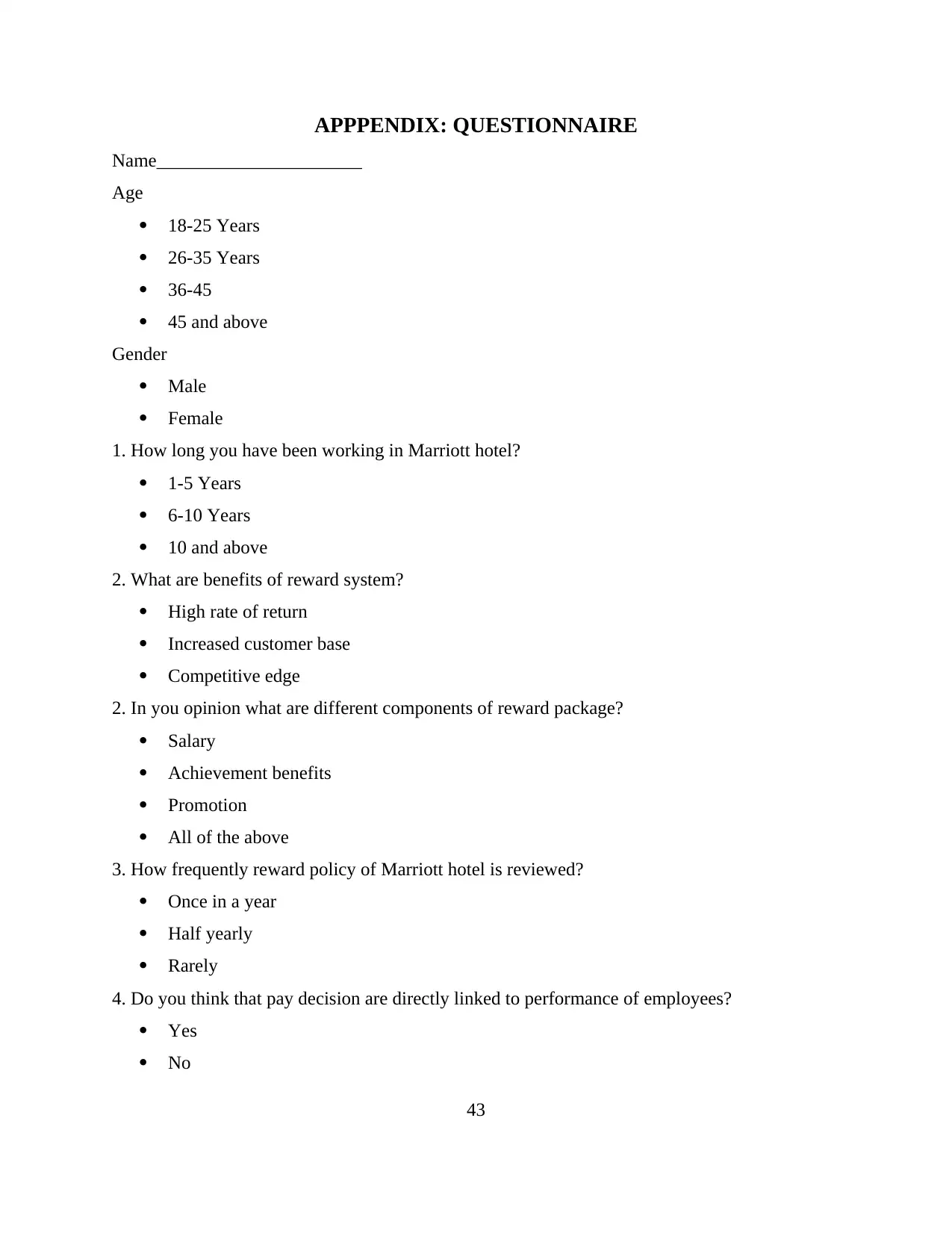
APPPENDIX: QUESTIONNAIRE
Name______________________
Age
18-25 Years
26-35 Years
36-45
45 and above
Gender
Male
Female
1. How long you have been working in Marriott hotel?
1-5 Years
6-10 Years
10 and above
2. What are benefits of reward system?
High rate of return
Increased customer base
Competitive edge
2. In you opinion what are different components of reward package?
Salary
Achievement benefits
Promotion
All of the above
3. How frequently reward policy of Marriott hotel is reviewed?
Once in a year
Half yearly
Rarely
4. Do you think that pay decision are directly linked to performance of employees?
Yes
No
43
Name______________________
Age
18-25 Years
26-35 Years
36-45
45 and above
Gender
Male
Female
1. How long you have been working in Marriott hotel?
1-5 Years
6-10 Years
10 and above
2. What are benefits of reward system?
High rate of return
Increased customer base
Competitive edge
2. In you opinion what are different components of reward package?
Salary
Achievement benefits
Promotion
All of the above
3. How frequently reward policy of Marriott hotel is reviewed?
Once in a year
Half yearly
Rarely
4. Do you think that pay decision are directly linked to performance of employees?
Yes
No
43
Paraphrase This Document
Need a fresh take? Get an instant paraphrase of this document with our AI Paraphraser
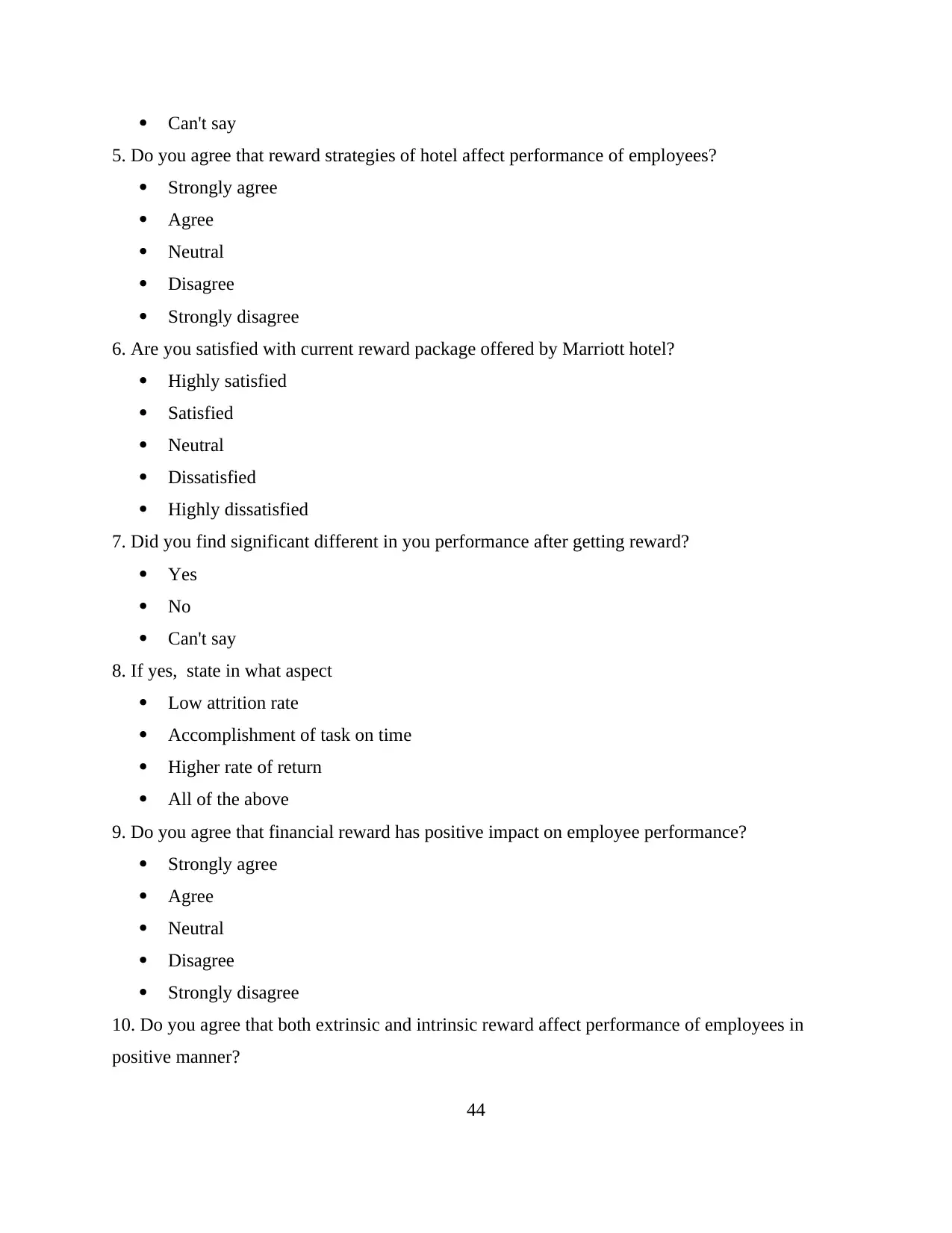
Can't say
5. Do you agree that reward strategies of hotel affect performance of employees?
Strongly agree
Agree
Neutral
Disagree
Strongly disagree
6. Are you satisfied with current reward package offered by Marriott hotel?
Highly satisfied
Satisfied
Neutral
Dissatisfied
Highly dissatisfied
7. Did you find significant different in you performance after getting reward?
Yes
No
Can't say
8. If yes, state in what aspect
Low attrition rate
Accomplishment of task on time
Higher rate of return
All of the above
9. Do you agree that financial reward has positive impact on employee performance?
Strongly agree
Agree
Neutral
Disagree
Strongly disagree
10. Do you agree that both extrinsic and intrinsic reward affect performance of employees in
positive manner?
44
5. Do you agree that reward strategies of hotel affect performance of employees?
Strongly agree
Agree
Neutral
Disagree
Strongly disagree
6. Are you satisfied with current reward package offered by Marriott hotel?
Highly satisfied
Satisfied
Neutral
Dissatisfied
Highly dissatisfied
7. Did you find significant different in you performance after getting reward?
Yes
No
Can't say
8. If yes, state in what aspect
Low attrition rate
Accomplishment of task on time
Higher rate of return
All of the above
9. Do you agree that financial reward has positive impact on employee performance?
Strongly agree
Agree
Neutral
Disagree
Strongly disagree
10. Do you agree that both extrinsic and intrinsic reward affect performance of employees in
positive manner?
44
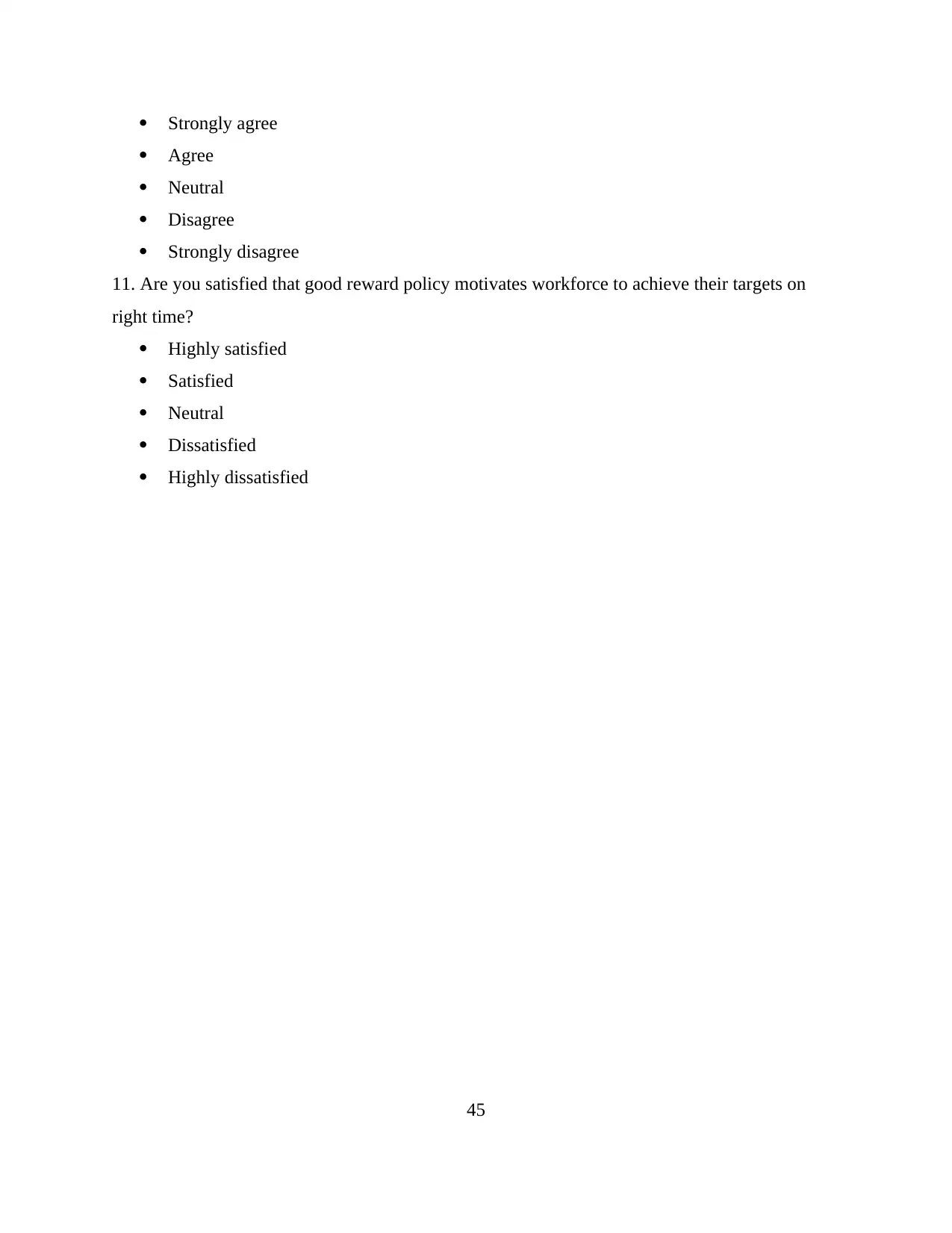
Strongly agree
Agree
Neutral
Disagree
Strongly disagree
11. Are you satisfied that good reward policy motivates workforce to achieve their targets on
right time?
Highly satisfied
Satisfied
Neutral
Dissatisfied
Highly dissatisfied
45
Agree
Neutral
Disagree
Strongly disagree
11. Are you satisfied that good reward policy motivates workforce to achieve their targets on
right time?
Highly satisfied
Satisfied
Neutral
Dissatisfied
Highly dissatisfied
45
1 out of 45
Related Documents
Your All-in-One AI-Powered Toolkit for Academic Success.
+13062052269
info@desklib.com
Available 24*7 on WhatsApp / Email
![[object Object]](/_next/static/media/star-bottom.7253800d.svg)
Unlock your academic potential
© 2024 | Zucol Services PVT LTD | All rights reserved.





